
UNCLASSIFIED
UNCLASSIFIED
DoD Enterprise Identity, Credential, and Access
Management (ICAM)
Reference Design
Version 1.0
June 2020
Prepared by Department of Defense, Office of the Chief
Information Officer (DoD CIO)
DISTRIBUTION STATEMENT C. Distribution authorized to U.S. Government agencies and their contractors
(Administrative or Operational Use). Other requests for this document shall be referred to the DCIO-CS.
CLEARED AS AMENDED
For Open Publication
Department of Defense
OFFICE OF PREPUBLICATION AND SECURITY REVIEW
Aug 07, 2020

UNCLASSIFIED
ii
UNCLASSIFIED
Document Approvals
Prepared By:
N. Thomas Lam
IE/Architecture and Engineering
Department of Defense, Office of the Chief Information Officer (DoD CIO)
Thomas J Clancy, COL US Army
CS/Architecture and Capability Oversight, DoD ICAM Lead
Department of Defense, Office of the Chief Information Officer (DoD CIO)
Approved By:
Peter T. Ranks
Deputy Chief Information Officer for Information Enterprise (DCIO IE)
Department of Defense, Office of the Chief Information Officer (DoD CIO)
John (Jack) W. Wilmer III
Deputy Chief Information Officer for Cyber Security (DCIO CS)
Department of Defense, Office of the Chief Information Officer (DoD CIO)
LAM.NGOAN.THOMAS.12294
38960
Digitally signed by
LAM.NGOAN.THOMAS.1229438960
Date: 2020.07.16 11:22:39 -04'00'
CLANCY.THOMAS.JEROME.JR.1
022639923
Digitally signed by
CLANCY.THOMAS.JEROME.JR.1022639923
Date: 2020.07.16 11:29:55 -04'00'
RANKS.PETER.THOMAS.12
84616665
Digitally signed by
RANKS.PETER.THOMAS.1284616665
Date: 2020.07.16 17:25:42 -04'00'
Digitally signed by
WILMER.JOHN.W.III.1267975430
Date: 2020.07.17 11:07:35 -04'00'

UNCLASSIFIED
iii
UNCLASSIFIED
Version History
Version
Date
Approved By
Summary of Changes
1.0
TBD
TBD
Renames and replaces the IdAM Portfolio
Description dated August 2015 and the IdAM
Reference Architecture dated April 2014. (Existing
IdAM SDs and TADs will remain valid until updated
versions are established.)
Updates name from Identity and Access
Management (IdAM) to Identity, Credential,
and Access Management (ICAM) to align with
Federal government terminology
Removes and cancels the list of formal ICAM
related requirements
Restructures document for clarity
Updates ICAM Taxonomy to better conform to
Federal ICAM Architecture
Updates descriptions and data flows of ICAM
capabilities
Summarizes current DoD enterprise ICAM
services
Defines ICAM roles and responsibilities
UNCLASSIFIED
iv
UNCLASSIFIED
Executive Summary
The purpose of this Identity, Credential, and Access Management (ICAM) Reference Design (RD) is to
provide a high-level description of ICAM from a capability perspective, including transformational goals
for ICAM in accordance with the Department of Defense (DoD) Digital Modernization Strategy. As
described in Goal 3, Objective 2 of the DoD Digital Modernization Strategy, ICAM “creates a secure and
trusted environment where any user can access all authorized resources (including [services,
information systems], and data) to have a successful mission, while also letting the Department of
Defense (DoD) know who is on the network at any given time.” This objective focuses on managing
access to DoD resources while balancing the responsibility to share with the need to protect. ICAM is not
a single process or technology, but is a complex set of systems and services that operate under varying
policies and organizations.
There are significant advantages to the DoD in providing ICAM services at the DoD enterprise level,
including consistency in how services are implemented, improved security, cost savings, and attribution
by having a discrete defined digital identity for a single entity. ICAM is also fundamental for the
transformation to a modern data-centric identity-based access management architecture that is
required in a future-state Zero Trust (ZT) Architecture. To gain these advantages, DoD enterprise ICAM
services must support functionality for both the DoD internal community and DoD mission partners,
must provide interfaces that are usable by Component information systems, and must minimize or
eliminate gaps in supporting ICAM capabilities.
The ICAM RD promotes centralization of identity and credential management, including attribute
management and credential issuance and revocation. The ICAM RD also establishes standardized
processes and protocols for authentication and authorization. Access decisions must be fundamentally
managed by local administrators who understand the context and mission relevance for person entities
and Non-Person Entities (NPE) who require access to resources.
The RD defines an ICAM taxonomy that is based on the core elements of the Federal ICAM (FICAM)
Architecture, and describes data flow patterns for each of the capabilities defined in the ICAM
taxonomy. Systems and services shown in these data flows may be operated at the DoD enterprise, DoD
Component, Community of Interest (COI), or local level. In addition to generic data flow patterns, the RD
provides a set of implementation patterns and their related use cases for ICAM capabilities. These
patterns are intended to demonstrate how capabilities may be implemented to meet a broad set of
mission and other needs. They are not intended to be prescriptive for how a given information system
consumes ICAM capabilities, nor are they intended to describe all possible ICAM use cases. Finally, the
RD describes existing and planned DoD Enterprise ICAM services, and roles and responsibilities for ICAM
service providers and for DoD Components in deploying ICAM.
This document is not intended to mandate specific technologies, processes, or procedures. Instead, it is
intended to:
Aid mission owners in understanding ICAM requirements and describing current and planned
DoD enterprise ICAM services to enable them to make decisions ICAM implementation so that it
meets the needs of the mission, including enabling authorized access by mission partners.
Support the owners and operators of DoD enterprise ICAM services so that these services can
effectively interface with each other to support ICAM capabilities.
UNCLASSIFIED
v
UNCLASSIFIED
Support DoD Components in understanding how to consume DoD enterprise ICAM services and
how to operate DoD Component, COI, or local level ICAM services when DoD enterprise services
do not meet mission needs.
Each mission owner is responsible for ensuring ICAM is implemented in a secure manner consistent with
mission requirements. Conducting operational, threat representative cybersecurity testing as part of
ICAM implementation efforts is a mechanism that needs to be used to check secure implementation.

UNCLASSIFIED
vi
UNCLASSIFIED
Contents
1. Introduction ...............................................................................................................................1
1.1. Purpose .......................................................................................................................................... 2
1.2. Applicability .................................................................................................................................... 3
1.3. DoD Community ............................................................................................................................. 4
DoD Internal Community ...................................................................................................... 4
External Mission Partner Community ................................................................................... 5
Beneficiaries .......................................................................................................................... 5
Other Entities ........................................................................................................................ 6
1.4. DoD Computing Environment ........................................................................................................ 6
1.5. References ...................................................................................................................................... 6
2. ICAM Capability Overview ..........................................................................................................9
2.1. Transformational Goals ................................................................................................................ 10
2.2. ICAM Capability Taxonomy Overview (DoDAF CV-2) ................................................................... 11
Core ICAM Capabilities ........................................................................................................ 12
2.2.1.1 Identity Management ..................................................................................................... 13
2.2.1.2 Credential Management ................................................................................................. 16
2.2.1.3 Access Management ....................................................................................................... 19
Access Accountability Capabilities ...................................................................................... 23
2.2.2.1 Log Collection and Consolidation .................................................................................... 23
2.2.2.2 Access Review ................................................................................................................. 24
2.2.2.3 Identity Resolution .......................................................................................................... 25
Contact Data Capabilities .................................................................................................... 25
2.2.3.1 Contact Data Collection .................................................................................................. 26
2.2.3.2 Contact Data Lookup ....................................................................................................... 26
2.3. Using DoD Enterprise ICAM Services ........................................................................................... 26
DoD Enterprise Benefits from Use of DoD Enterprise ICAM Services ................................ 26
Information System Benefits from Using DoD Enterprise ICAM Services .......................... 27
Mitigating Challenges to Using DoD Enterprise ICAM Services .......................................... 27
3. ICAM Data Flows ...................................................................................................................... 29
3.1. Core ICAM Capabilities ................................................................................................................. 32
Identity Management ......................................................................................................... 32
3.1.1.1 Person Entity ................................................................................................................... 33
3.1.1.2 NPE .................................................................................................................................. 35
3.1.1.3 Federated Entity .............................................................................................................. 35
Credential Management ..................................................................................................... 36
3.1.2.1 Internal Credential Management ................................................................................... 36
3.1.2.2 External Credential Registration ..................................................................................... 38
Access Management ........................................................................................................... 39

UNCLASSIFIED
vii
UNCLASSIFIED
3.1.3.1 Resource Access Management ....................................................................................... 39
3.1.3.2 Provisioning ..................................................................................................................... 40
3.1.3.3 Authentication ................................................................................................................ 42
3.1.3.4 Authorization .................................................................................................................. 45
3.2. Access Accountability Capabilities ............................................................................................... 47
Log Collection and Consolidation ........................................................................................ 47
Access Review ..................................................................................................................... 48
Identity Resolution .............................................................................................................. 49
3.3. Contact Data Capabilities ............................................................................................................. 50
4. ICAM Patterns and Associated Use Cases .................................................................................. 51
4.1. Identity and Credential Patterns .................................................................................................. 51
Unclassified Enterprise DoD Internal Initial Registration .................................................... 51
Unclassified Enterprise Mission Partner Entity Registration .............................................. 53
Community of Interest User Registration ........................................................................... 54
Community of Interest Person Entity Identity Provider Registration ................................. 56
Secret Enterprise Registration for DoD and Federal Agencies ........................................... 57
Secret Enterprise Registration for Non-Federal Agency Mission Partner Entities ............. 58
Short-Lived NPE Registration .............................................................................................. 59
DoD Beneficiary Registration .............................................................................................. 60
DoD Applicant Registration ................................................................................................. 61
4.2. Access Management Patterns ...................................................................................................... 62
Access to DoD Managed Resources .................................................................................... 62
Access for Unanticipated Entities ....................................................................................... 63
Privileged User Access......................................................................................................... 65
Zero Trust ............................................................................................................................ 66
Access to Software as a Service (SaaS) Cloud Managed System ........................................ 66
4.3. Access Accountability Patterns .................................................................................................... 68
Logging and Monitoring ...................................................................................................... 68
Access Review ..................................................................................................................... 69
Identity Resolution .............................................................................................................. 70
4.4. Contact Data Lookup .................................................................................................................... 70
5. DoD Enterprise ICAM Services ................................................................................................... 72
5.1. DoD ICAM Enterprise Services Summary ..................................................................................... 72
5.2. Production DoD ICAM Enterprise Services ................................................................................... 74
Person Data Repository (PDR) ............................................................................................ 74
Identity Resolution Service ................................................................................................. 75
Trusted Associate Sponsorship System (TASS) ................................................................... 75
DoD Public Key Infrastructure (PKI) .................................................................................... 75
Real-Time Automated Personnel Identification System (RAPIDS) ...................................... 75

UNCLASSIFIED
viii
UNCLASSIFIED
NIPRNet Enterprise Alternate Token System (NEATS) / Alternate Token Issuance and
Management System (ATIMS) ............................................................................................................ 76
Purebred ............................................................................................................................. 76
DoD Self-service (DS) Logon ................................................................................................ 76
Enterprise Identity Attribute Service (EIAS) ........................................................................ 77
Identity Synchronization Service (IdSS)............................................................................... 77
milConnect .......................................................................................................................... 77
Enterprise Directory Services (EDS) .................................................................................... 77
Global Directory Service (GDS)............................................................................................ 78
5.3. Planned DoD ICAM Enterprise Services ....................................................................................... 78
Mission Partner Registration (MPR) ................................................................................... 78
Identity Provider (IdP) ......................................................................................................... 78
Multi-Factor Authentication (MFA) Registration Service ................................................... 79
EIAS (Enhanced) .................................................................................................................. 79
Backend Attribute Exchange (BAE) ..................................................................................... 79
DS Logon (Enhanced) .......................................................................................................... 79
Automated Account Provisioning (AAP) ............................................................................. 79
Master User Record (MUR) ................................................................................................. 80
6. ICAM Implementation Responsibilities ...................................................................................... 81
6.1. DoD ICAM Joint Program Integration Office (JPIO) Responsibilities ............................................ 81
6.2. DoD Enterprise ICAM Service Provider Responsibilities .............................................................. 81
6.3. DoD Component Responsibilities ................................................................................................. 81
Establish DoD Component Level ICAM Governance ........................................................... 81
Support DoD Enterprise ICAM Services .............................................................................. 82
Use DoD Enterprise ICAM Services ..................................................................................... 82
Operate COI and Local ICAM Services ................................................................................. 82
6.4. Responsibilities Related to External Federated ICAM Service Providers ..................................... 83
7. Summary of ICAM Service Gaps ................................................................................................ 84
Mapping ICAM Capabilities to the FICAM Architecture .............................................. 88
ICAM and the Risk Management Framework ............................................................ 90
Case Study: Moving Beyond CAC Authentication and Authorization .......................... 97
DoD Internal Community Persona Type Codes ........................................................ 100
Non-Person Entity Type Codes ................................................................................ 101
Core Authorization Attributes ................................................................................ 102
Glossary of Terms .................................................................................................. 103
Acronyms .............................................................................................................. 110
UNCLASSIFIED
ix
UNCLASSIFIED
Figures
Figure 1 – DoD ICAM Vision Capability Viewpoint (CV-1) ............................................................................. 9
Figure 2 – Core ICAM High-Level Operational Concept Graphic (OV-1) ..................................................... 10
Figure 3 – ICAM Capability Taxonomy (CV-2) ............................................................................................. 12
Figure 4 – Person Entity Identity Creation (C1.1.1) .................................................................................... 33
Figure 5 – Modify Identity Attributes (C1.1.1) ............................................................................................ 33
Figure 6 – Modify Attributes (C.1.1.1) ........................................................................................................ 34
Figure 7 – Deactivate Identity (C1.1.1) ....................................................................................................... 34
Figure 8 – Create and Maintain NPE Identity (C1.1.2) ................................................................................ 35
Figure 9 – Decommission NPE Identity (C1.1.2) ......................................................................................... 35
Figure 10 – Modify Federated Identity Attributes (C1.1.3) ........................................................................ 36
Figure 11 – Credential Issuance (C1.2.1) ..................................................................................................... 37
Figure 12 – Derived Credential Issuance (C1.2.1) ....................................................................................... 37
Figure 13 – Credential Revocation (C1.2.1) ................................................................................................ 38
Figure 14 – Credential Registration (C1.2.2) ............................................................................................... 39
Figure 15 – Resource Access Management via Hosting Information System (C1.3.1) ............................... 39
Figure 16 – Resource Access Management via Data Tagging (C1.3.1) ....................................................... 40
Figure 17 – Manual Provisioning (C1.3.2) ................................................................................................... 40
Figure 18 – Dynamic Provisioning (C1.3.2) ................................................................................................. 41
Figure 19 – Direct Authentication (C1.3.3) ................................................................................................. 42
Figure 20 – Authentication using a Reverse Proxy IdP (C1.3.3) .................................................................. 43
Figure 21 – Authentication using an IdP (C1.3.3)........................................................................................ 44
Figure 22 – Authentication of an External Entity using an External IdP (C1.3.3) ........................................ 45
Figure 23 – Direct Authorization (C1.3.4) ................................................................................................... 45
Figure 24 – Authorization using Reverse Proxy IdP (C1.3.4) ....................................................................... 46
Figure 25 – Dynamic Access using ABAC (C1.3.4) ....................................................................................... 47
Figure 26 – Log Collection and Consolidation (C2.1) .................................................................................. 48
Figure 27 – Person Entity Centric Access Review (C2.2) ............................................................................. 48
Figure 28 – Resource Centric Access Review .............................................................................................. 49
Figure 29 – NPE Centric Access Review ...................................................................................................... 49
Figure 30 – Identity Resolution (C2.3) ........................................................................................................ 50
Figure 31 – Contact Data Collection and Lookup (C3.1, C3.2) .................................................................... 50
Figure 32 – Unclassified DoD Internal Initial Registration .......................................................................... 51
Figure 33 – Unclassified Mission Partner Entity Registration ..................................................................... 53
Figure 34 – COI User Registration ............................................................................................................... 54
Figure 35 – COI IdP Registration ................................................................................................................. 56
Figure 36 – Secret Network Initial Registration .......................................................................................... 57
Figure 37 – Secret Registration for Mission Partners ................................................................................. 58
Figure 38 – Cloud Elasticity Registration ..................................................................................................... 59
Figure 39 – DoD Beneficiary Registration ................................................................................................... 60
Figure 40 – Applicant Registration .............................................................................................................. 61
Figure 41 – ICAM Service View (SvcV-1) ..................................................................................................... 72
UNCLASSIFIED
x
UNCLASSIFIED
Tables
Table 1 – ICAM Strategy Goals and Objectives ........................................................................................... 10
Table 2 – Mitigating Challenges with Use of Enterprise ICAM ................................................................... 27
Table 3 – ICAM Data Flow Entities and Services ......................................................................................... 29
Table 4 – ICAM Enterprise Services ............................................................................................................ 73
Table 5 – Summary of DoD ICAM Enterprise Capability Gaps .................................................................... 84
Table 6 – Mapping of ICAM Capabilities to FICAM Architecture Services .................................................. 88
Table 7– Mapping NIST SP 800-53 Controls to ICAM.................................................................................. 90
Table 8 – Sample Modifications to Support Mission Partner Entity Access ............................................... 98
Table 9 – Persona Type Codes .................................................................................................................. 100
Table 10 – Glossary ................................................................................................................................... 103
UNCLASSIFIED
1
UNCLASSIFIED
Identity, Credential, and Access Management (ICAM)
Reference Design (RD)
1. Introduction
As described in Goal 3 Objective 2 of the Department of Defense (DoD) Digital Modernization Strategy,
Identity, Credential, and Access Management (ICAM) “creates a secure and trusted environment where
any user can access all authorized resources (including [services, information systems], and data) to
have a successful mission, while also letting DoD know who is on the network at any given time.” To
realize this objective, the DoD must support capabilities that:
• Provide identity, credential and access management services to protect DoD information
systems and DoD electronic Physical Access Control Systems (PACS) resources Provide access
accountability
• Enable entities to look up contact data for person entities and Non-Person Entities (NPE)
ICAM is not new to the DoD. ICAM capabilities are already pervasive throughout the DoD because
Information Technology (IT) devices, systems, applications and services are in use throughout the DoD.
All of this DoD IT has some form of ICAM capability implemented to protect the full range of DoD
information systems and DoD PACS resources, from the least restricted and public to the most restricted
and protected. In addition, current ICAM capabilities enable DoD personnel to find and contact each
other and enable accountability of user behavior when accessing DoD resources.
Even though DoD ICAM capabilities already exist, these ICAM capabilities need to evolve, and additional
ICAM systems and services need to be implemented to meet the DoD ICAM objective and to better align
the DoD with the Federal ICAM (FICAM) Architecture. Additionally, DoD ICAM is evolving to support new
operating environments such as cloud and the transformation to a modern identity-based access
management architecture that is required in a future-state Zero Trust (ZT) Architecture.
DoD ICAM is not a single process or technology but is a complex set of systems and services that operate
under various policies and organizations.
The ICAM RD promotes centralization of identity and credential management, including attribute
management and credential issuance and revocation. The ICAM RD also establishes standardized
processes and protocols for authentication and authorization. Access decisions must be fundamentally
managed by local administrators who understand the context and mission relevance for person entities
and Non-Person Entities (NPE) who require access to resources.
ICAM capabilities address Risk Management Framework (RMF) security controls designed to mitigate
risk and protect resources. The Access Control (AC) and Identity and Authentication (IA) controls are
addressed through ICAM, but other RMF controls may also be fully or partially addressed through
proper ICAM implementation. Although a complete comparison between ICAM and the RMF security
controls is out of scope for this document, a mapping of security controls to related ICAM Reference
Design text is provided as Attachment B.
This document summarizes the designs for DoD ICAM:
• Section 1 provides the purpose and scope for this document along with an overview of the DoD
enterprise, including the user community and computing environment
UNCLASSIFIED
2
UNCLASSIFIED
• Section 2 describes the DoD ICAM vision, presents the ICAM capability taxonomy, and provides
an overview description of each of the ICAM capabilities
• Section 3 provides data flow diagrams describing how ICAM services can work together to
achieve ICAM capabilities
• Section 4 identifies a set of use cases for implementing ICAM capabilities for various types of
users
• Section 5 identifies operational and planned DoD enterprise level ICAM systems and services
that enable ICAM capabilities
• Section 6 provides DoD Component roles and responsibilities for the implementation of ICAM
• Section 7 summarizes gaps in current DoD enterprise ICAM capabilities
Details for design and implementation of DoD enterprise ICAM systems and services as well as interfaces
for interacting with ICAM services are found in their respective system documentation.
1.1. Purpose
The purpose of this ICAM Reference Design (RD) is two-fold. First, as an architecture document, it
supports the owners and operators of DoD enterprise ICAM services so that these services can
effectively interface with each other to support ICAM capabilities, and supports developers so they can
implement ICAM using consistent, standards-based methodologies. Second, as a descriptive document,
it supports DoD Components in understanding how to consume DoD enterprise ICAM services and how
to operate DoD Component, Community of Interest (COI), or local level ICAM services when DoD
enterprise services do not meet mission needs. For this document, a COI is a community of people,
information systems, and resources that share a common requirement for ICAM that is not at the DoD
enterprise level or specific information system level. COIs may be part of other COIs.
There are significant advantages to the DoD to provide ICAM services at the DoD enterprise level,
including cost savings from managing software licenses, economies of scale in deploying services,
consistency in how services are implemented, improved security, and attribution by having a discrete
defined digital identity for a single entity. However, to gain these advantages, DoD enterprise ICAM
services must support functionality for both the DoD internal community and DoD mission partners,
provide interfaces that are usable by Component information systems and resources, and minimize or
eliminate gaps in supporting ICAM capabilities. By describing needed ICAM capabilities and documenting
how DoD enterprise services are supporting these capabilities, this RD can promote adoption and use of
these services.
Each mission is responsible for ensuring ICAM is implemented in a secure manner consistent with its
unique mission requirements. This document is intended to aid mission owners in understanding ICAM
capabilities and describing current and planned DoD enterprise ICAM services to enable mission owners
to make decisions for how to implement ICAM so that it meets the needs of the mission. The intent of
this document is not to mandate specific technologies, processes, or procedures, but to aid mission
owners and implementers in evaluating the security and maintainability of their information systems
and resources.
Some of the considerations this document will assist mission owners and implementers in assessing
include:
UNCLASSIFIED
3
UNCLASSIFIED
Data Sources: provide information about available DoD enterprise sources, attributes available
from those sources, requirements for obtaining those attributes, and security considerations for
using these services
Identity Synchronization: enumerate common protocols, common procedures, and common
technologies for obtaining and using identifiers to support synchronizing identity data between
environments
Federation: processes and procedures for leveraging identity data and credentials that are
managed outside of the DoD to support authentication and authorization of DoD mission
partner entities
Assurance Levels: understanding identity assurance levels (IAL), authenticator assurance levels
(AAL), and federation assurance levels (FAL) and their impact to assist mission owners in
evaluating the right types of credentials to support in their missions
Authentication: authentication processes, procedures, leading practices, and common pitfalls
for person entities and NPEs
Authorization: authorization processes, procedures, leading practices, and common pitfalls for
person entities and NPEs
ICAM Technology: key ICAM technical concepts, implementation patterns, and security
considerations
Audit: auditing and logging considerations to support accountability
1.2. Applicability
The contents of this document are applicable to all of the following.
The Office of the Secretary of Defense (OSD), the Military Departments, the Office of the
Chairman of the Joint Chiefs of Staff (CJCS) and the Joint Staff, the Combatant Commands, the
DoD Office of the Inspector General (OIG), the Defense Agencies, the DoD Field Activities, and all
other organizational entities within the DoD (referred to collectively as the “DoD Components”).
All DoD unclassified, secret, top secret, and United States (US) owned releasable networks and
information systems under the authority of the Secretary of Defense (e.g., Non-classified
Internet Protocol Router Network [NIPRNet], Secret Internet Protocol Router Network
[SIPRNet], Defense Research and Engineering Network [DREN], Secret Defense Research and
Engineering Network [SDREN], SIPRNet Releasable [SIPR REL] De-Militarized Zone (DMZ), United
States Battlefield Information Collection and Exploitation System [USBICES], and DoD Mission
Partner Environment [MPE]). Information systems include those that are owned and operated
by or on behalf of the DoD, including systems hosted at DoD data centers, Platform Information
Technology (PIT) systems including weapon systems and control systems, contractor operated
systems, cloud hosted systems, and systems hosted on closed operational networks with no
connection to the DoD Information Networks (DoDIN).
All DoD and non-DoD person entity and NPE users (referred to as “entities”) accessing DoD
unclassified, secret, or top secret networks and resources under the authority of the Secretary
of Defense, including DoD mission partners and DoD beneficiaries.

UNCLASSIFIED
4
UNCLASSIFIED
All DoD ICAM capabilities, functions, systems, elements and services implemented at any and all
locations, from well-connected Continental United States (CONUS) and Outside Continental
United States (OCONUS) environments, to tactical environments, including the most challenging
and restricted Denied, Degraded, Intermittent, or Limited bandwidth (DDIL) environments.
The ICAM taxonomy and ICAM data flows in this document apply regardless of whether systems are
connected to the DoDIN and regardless of operational considerations. The use of DoD enterprise ICAM
services may not be applicable for some mission environments. When DoD enterprise ICAM services are
not used, the mission owner is responsible for implementing ICAM capabilities including identity
proofing, credential issuance and revocation, attribute management, entitlement provisioning, and
logging in accordance with this document.
The designs, requirements, and roles and responsibilities for ICAM capabilities, functions, systems,
elements and services implemented by the Intelligence Community (IC) and on the Joint Worldwide
Intelligence Communications System (JWICS) are the responsibility of the Director of National
Intelligence (DNI) to determine. As a result, this ICAM design does not specifically apply to the following.
However, ICAM capabilities should support interoperability to support information sharing between
these environments and the DoDIN.
Sensitive Compartmented Information (SCI) and information systems operated within the DoD
that fall under the authority provided in Intelligence Community Directive 503
Top Secret collateral systems
Special Access Programs
1
1.3. DoD Community
DoD provides resources to a broad community of users to support its core mission, provide services to
beneficiaries, and to address non-traditional missions. ICAM capabilities must be flexible enough to
meet the needs of information systems supporting these communities while providing sufficient security
to prevent unauthorized access.
DoD Internal Community
The DoD internal community includes all people who are eligible for fully provisioned network accounts
on NIPRNet or SIPRNet as a requirement of performing their job function, and NPEs that are fully
managed by the DoD. Identity information for the DoD internal community person entities is managed
through DoD enterprise services such as the Person Data Repository (PDR), and these entities are issued
credentials for the NIPRNet on Common Access Cards (CAC) or Alternate Logon Tokens (ALT) by the DoD
Public Key Infrastructure (PKI). On the SIPRNet, these entities are issued credentials by the DoD portion
of the National Security System (NSS) PKI. These entities may also be issued additional credentials based
on their primary credential for use in specialized environments such as mobile computing and non-
traditional systems that do not support the CAC form factor. Identity information for DoD internal NPEs
1
Note that the DoD Special Access Program (SAP) community operates under a separate but similar ICAM strategy
and is implementing its own program with guidance from the DoD and the National Security Agency (NSA).
Because of the highly sensitive nature of special access programs and their materials, they must be managed
independently and fall under the purview of the DOD SAP Chief Information Officer (CIO) office. For additional
details regarding SAP ICAM strategy and implementation, please contact the DOD SAP CIO office.

UNCLASSIFIED
5
UNCLASSIFIED
may be managed through DoD enterprise services or may be managed by the appropriate DoD
Component. The DoD internal community includes:
DoD military service members including active duty, reserve, and national guard
DoD civilian employees
Eligible non-US persons who work on DoD computers at DoD facilities
Contractors who work on DoD computers at DoD facilities
Eligible contractors who do not work at DoD facilities
Roles managed by the DoD where the nature of the role requires establishment of a separate
digital identity – role identities must be tightly bound to the people who perform them
NPEs that are fully managed by the DoD including
o Physical devices such as physical servers, workstations, mobile devices, or routers
o Virtual machines including servers and workstations
o Information systems, services, and processes with a long-term existence
o Information systems, services, and processes with a limited duration and targeted
purpose
o Non-traditional systems such as weapons systems and control systems
External Mission Partner Community
DoD interacts with a broad community of mission partners who are not eligible for DoD enterprise
credentials. The DoD mission partner community includes:
Federal Department and Agency Employees and Provisioned Contractors
Contractors who do not work on DoD computer at DoD facilities and are not otherwise eligible
members of the DoD internal community
Non-US persons, including allied and coalition partners
Other Government, including state, local, and tribal government employees
Non-Governmental Organizations (NGO)
External NPEs including those operated by cloud service providers
Some mission partner entities have credentials issued by external providers that are approved for use by
DoD information systems, such as Federal Agency Personal Identity Verification (PIV) smart cards,
Defense Industrial Base (DIB) commercial PIV-Interoperable (PIV-I) smart cards, or non-US sovereign
nation supported credentials. Some mission partner entities may interact with DoD in closed
environments where they are issued credentials that are only trusted within that environment. In order
to interact with these mission partner entities, authentication services must be able to consume mission
partner credentials by leveraging a persistent, unique identifier provided by the mission partner entity.
DoD services may map the identifier contained in the mission partner credential to a persistent, unique
identifier assigned by the DoD either at an DoD enterprise, COI, or local level in order to provide an
enterprise view of authentication.
Beneficiaries
DoD provides services to people who are eligible for benefits as a result of their relationship to the DoD.
Identity information for DoD beneficiaries is managed through the PDR, and these entities are eligible to
obtain credentials through DoD Self-service (DS) Logon. The DoD beneficiary community includes:
DoD military service members including active duty, reserve, and national guard
Military retirees

UNCLASSIFIED
6
UNCLASSIFIED
Military spouses and other dependents
Some overseas DoD civilian employees
Designees who to represent a beneficiary, either by the beneficiary themselves or through a
legal process such as dependency or power of attorney
Other Entities
Some DoD information systems interact with external entities for a limited duration or purpose. Identity
information for these entities is generally not managed at the DoD enterprise level, and these entities
may require locally issued credentials. Other entities include:
Vendors
Non-traditional mission non-government organizations
Military accession applicants who are not yet registered in the PDR
1.4. DoD Computing Environment
The DoD environment is a complex computing environment with a multitude of programs, stakeholders,
and other complexities. ICAM is a fundamental building block that must span the environment and
cannot be implemented in a one-size-fits-all manner.
ICAM must support missions operating at all security levels, including unclassified, secret, and top
secret. It is recognized that a mission operating in a high bandwidth unclassified environment will
perform ICAM functions differently than a mission operating in a secret level DDIL environment. The
complexity of the types of environments, degree of sensitivity of resources, and devices supported are
contributing factors to the difficulty of operating in the DoD environment.
Resources may be hosted in different environments, including:
DoD enterprise owned and managed data centers
DoD Component owned and managed data centers
Mission partner data centers
Private, public, or hybrid clouds including government clouds
Information systems deployed with tactical units
Person entities and NPEs accessing these resources operate from endpoint devices that include laptops
and desktops, mobile phones or tablets, and virtual machines. These devices may be owned and
managed by the DoD, owned and managed by DoD mission partners, or may be personally owned by
person entities. These operations may also take place from within short-lived services or containers.
Information systems and endpoint devices operate in various network environments, including DoD
protected high bandwidth, DDIL, closed COI enclaves, and external enclaves with varying degrees of
trust such as mission partner networks, private networks, and the public internet.
1.5. References
This RD incorporates and cancels the following documents:
Identity and Access Management Reference Architecture, Version 1.0, April 2014
Identity and Access Management Portfolio Description, Version 2.0, August 2015
UNCLASSIFIED
7
UNCLASSIFIED
Joint Information Environment (JIE) Executive Committee (EXCOM) approved Identity and
Access Management (IdAM) Service Descriptions (SD) and Technical Architecture Descriptions
(TAD) remain valid until updated versions are established
This RD also references the following documents:
Committee on National Security Systems (CNSS) Instruction 4009, Committee on National
Security Systems (CNSS) Glossary, 6 April 2015
https://www.cnss.gov/CNSS/issuances/Instructions.cfm
Department of Defense Naming Convention for People within DoD Identity, Credential, and
Access Management, February 2020
DoD Digital Modernization Strategy, 12 July 2019
https://media.defense.gov/2019/jul/12/2002156622/-1/-1/1/dod-digital-modernization-
strategy-2019.pdf
DoD Cyber Security Reference Architecture (CSRA)
DoD Identity, Credential, and Access Management Strategy (DRAFT), March 2020
DoD Instruction 8520.03, Identity Authentication for Information Systems, Change 1, 27 July
2017
https://www.esd.whs.mil/Portals/54/Documents/DD/issuances/dodi/852003p.pdf
Federal Identity, Credential, and Access Management (FICAM) Architecture
https://arch.idmanagement.gov/
Homeland Security Presidential Directive (HSPD) 12, Policies for a Common Identification
Standard for Federal Employees and Contractors, 27 August 2004
https://www.dhs.gov/homeland-security-presidential-directive-12
Intelligence Community Directive (ICD) 503, Intelligence Community Information Technology
Systems Security Risk Management, Certification and Accreditation, 15 September 2008
https://www.dni.gov/files/documents/ICD/ICD_503.pdf
National Institute of Standards and Technology (NIST) Computer Security Resource Center
(CSRC) Glossary
https://csrc.nist.gov/glossary
NIST Federal Information Processing Standard (FIPS) 201-2, Person Identity Verification (PIV) of
Federal Employees and Contractors, August 2013
https://csrc.nist.gov/publications/detail/fips/201/2/final
NIST Special Publication (SP) 800-53-4, Security and Privacy Controls for Federal Information
Systems and Organizations
https://csrc.nist.gov/publications/detail/sp/800-53/rev-4/final
NIST Special Publication (SP) 800-63-3, Digital Identity Guidelines, 22 June 2017
SP 800-63A, Enrollment and Identity Proofing
SP 800-63B, Authentication and Lifecycle Management
SP 800-63C, Federation and Assertions
https://pages.nist.gov/800-63-3
UNCLASSIFIED
8
UNCLASSIFIED
NIST SP 800-162, Guide to Attribute Based Access Control (ABAC) Definition and Considerations
https://csrc.nist.gov/publications/detail/sp/800-162/final
NIST SP 800-205, Attribute Considerations for Access Control Systems
https://csrc.nist.gov/publications/detail/sp/800-205/final
NISTIR 8112, Attribute Metadata: A Proposed Schema for Evaluating Federated Attributes
https://csrc.nist.gov/publications/detail/nistir/8112/final
Office of Management and Budget (OMB) Memo M-19-17, Enabling Mission Delivery through
Improved Identity, Credential, and Access Management, 21 May 2019
https://www.whitehouse.gov/wp-content/uploads/2019/05/M-19-17.pdf
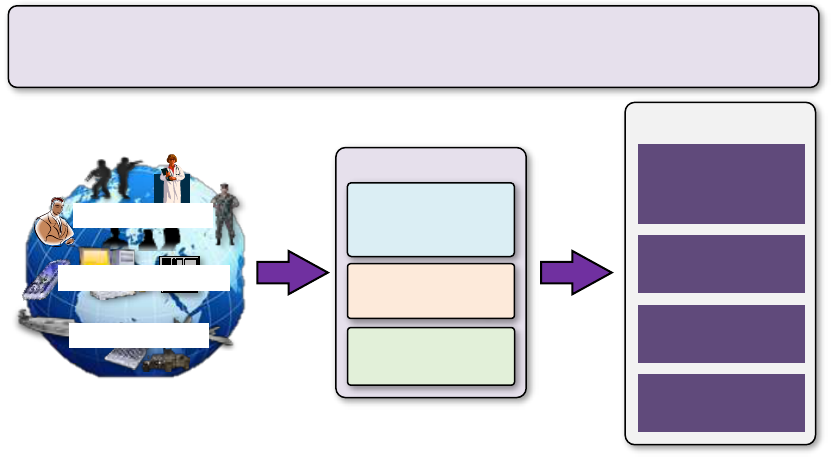
UNCLASSIFIED
9
UNCLASSIFIED
2. ICAM Capability Overview
This section provides the high-level ICAM capability perspective and includes the transformational vision
(DoD Architecture Framework [DoDAF] Capability Viewpoint [CV]-1), a description of ICAM goals and
objectives, and the capability taxonomy (DoDAF CV-2).
This DoD ICAM vision is depicted in Figure 1. ICAM capabilities improve mission effectiveness by
providing core ICAM (which includes identity management, credential management, and access
management), access accountability, and contact data capabilities to achieve ICAM results. These three
ICAM operational capabilities define the complete scope of DoD ICAM.
Figure 1 – DoD ICAM Vision Capability Viewpoint (CV-1)
The high-level operational concept for ICAM is shown in Figure 2. This diagram serves as the DoDAF
Operational Viewpoint (OV) 1 and as an organizing construct for ICAM enablers, capabilities, business
functions and services. It identifies the classes of entities: DoD person entities, DoD NPEs (such as
servers and web applications), and federated mission partner entities. The three classes of entities have
different processes for identity proofing and credentialing, as discussed in Sections 3.1.1 and 3.1.2. Once
credentialed and authenticated, access decisions for entities follow a common process. Access to
protected resources is based on the entity and their attributes (including roles), the access labels on a
resource, and the access policy that compares the entity and resource attributes and evaluates to make
a grant or deny decision.
DoD Identity, Credential, and Access Management (ICAM) Objective
Create a secure and trusted environment where any user can access all authorized resources to have a
successful mission, while also letting DoD know who is on the network at any given time
ICAM Capabilities
Core ICAM
Support Authentication
& Authorization
Access
Accountability
Contact Data
Collection
Person Entities
Non-Person Entities
Federated Entities
Results
Provide access to
DoD resources based
on mission need
Support rapid
situational response
Enhance visibility
and attribution
Demonstrate
compliance

UNCLASSIFIED
10
UNCLASSIFIED
Figure 2 – Core ICAM High-Level Operational Concept Graphic (OV-1)
Implementing effective ICAM requires data management in accordance with data management
principles, wherever ICAM data is originated or hosted. ICAM data includes identifiers and credentials to
support authentication; authorization and environment attributes along with digital policy rules to
support authorization; identity attributes to support contact data lookup; and access logs and
provisioned entitlements to support attribution. While all data management principles are important,
critical DoD Data Strategy goals include making ICAM data visible and accessible to information systems
or other entities that require the data and ensuring that ICAM data has sufficient quality that it can be
trusted by information systems in making access decisions.
2.1. Transformational Goals
The DoD Digital Modernization Strategy identifies eleven strategy elements in Goal 3, Objective 2, which
is to “Deploy an End-to-End Identity, Credential, and Access Management (ICAM) Infrastructure.” These
strategy elements are designed to focus DoD resources towards building and deploying ICAM solutions.
The resulting capabilities will facilitate information sharing across the DoD and with mission partners,
while managing risks and protecting information against unauthorized access. The strategy elements are
listed in Table 1.
Table 1 – ICAM Strategy Goals and Objectives
Element #
Strategy Element
1
Expand Public Key Enablement Capabilities to Support ICAM
2
Implement Automated Account Provisioning
3
Implement Support for Approved Multi-Factor Authentication Capabilities

UNCLASSIFIED
11
UNCLASSIFIED
Element #
Strategy Element
4
Enhance Enterprise Identity Attribute Service (EIAS)
5
Expand the Use of Derived Credentials
6
Implement a Data Centric Approach to Collect, Verify, Maintain, and Share identity and
Other Attributes
7
Improve and Enable Authentication to DoD Networks and Resources through Common
Standards, Shared Services, and Federation
8
Deploy Shared Services Promoting the Implementation of Enterprise ICAM
9
Enable Consistent Monitoring and Logging to Support Identity Analytics for Detecting
Insider Threats and External Attacks
10
Enhance the Governance Structure Promoting the Development and Adoption of
Enterprise ICAM Solutions
11
Create DoD Policies and Standards Clearly Defining Requirements for Identification,
Credentialing, Authentication and Authorization Lifecycle Management
2.2. ICAM Capability Taxonomy Overview (DoDAF CV-2)
The DoD ICAM Capability taxonomy is shown in Figure 3. It consists of three high-level parent
capabilities: core ICAM, access accountability, and contact data, and their second level child capabilities.
These capabilities collectively provide the DoD with the ability to enable the right person entity or NPE
to access the right resource at the right time for the right reason, and support knowing who is on the
network at what time and for what reason. The CV-2 is based on the core elements of the FICAM
Architecture. Attachment A contains a mapping of this taxonomy to the services defined in the FICAM
Architecture.
This section provides an operational description of each of the ICAM capabilities identified in Figure 3.
The intent of this section is to enumerate and describe these capabilities that must be part of DoD ICAM,
but not to dictate exact implementations. ICAM capabilities may be performed at the DoD enterprise,
DoD Component, COI, or local level. Some capabilities, such as identity management for mission partner
entities, may also be performed externally to the DoD. Information systems may also consume
capabilities from services operated at multiple levels depending on operational needs.
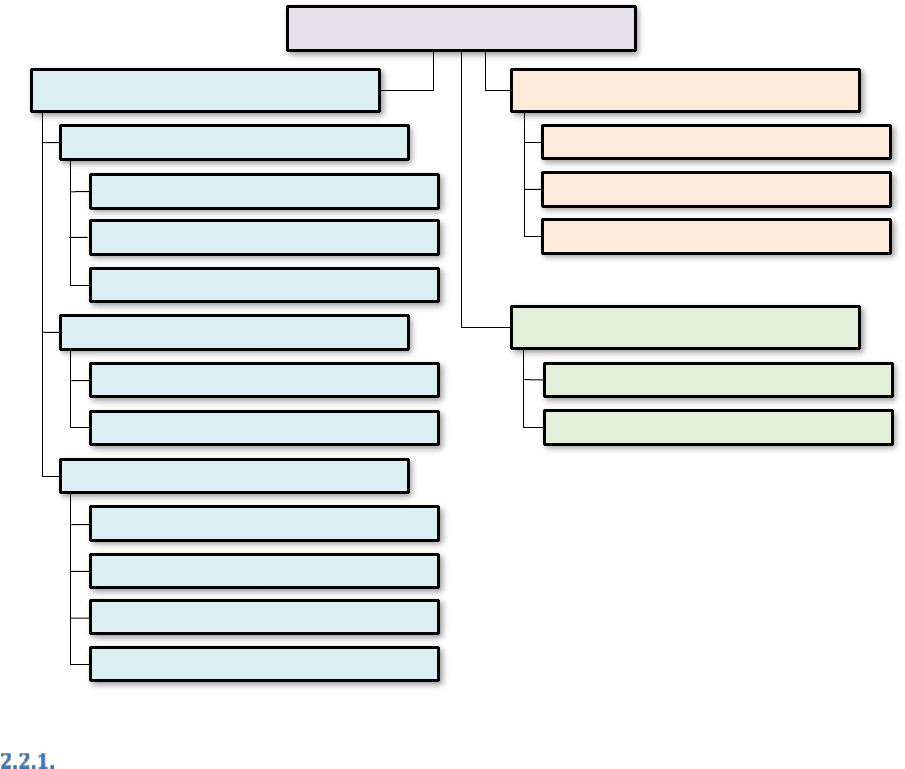
UNCLASSIFIED
12
UNCLASSIFIED
Figure 3 – ICAM Capability Taxonomy (CV-2)
Core ICAM Capabilities
As defined by the FICAM Architecture, ICAM is “the set of security disciplines that allows an organization
to enable the right [entity] to access the right resource at the right time for the right reason.” The FICAM
architecture defines five lower level capabilities as:
Identity Management allows an organization to construct a trusted digital identity based on an
entity’s defining attributes
Credential Management allows an organization to associate a digital identity with authoritative
proof of that claimed identity
Access Management allows an organization to leverage trusted identities and authoritative
credentials to ensure only permitted entities are granted access to protected resources
Governance enables organizations to make programmatic decisions, manage enterprise policies,
and promote program efficiency.
Federation allows an organization to accept ICAM information and decisions across
organizational boundaries based on an established trust.
This document focuses on the first three areas of identity management, credential management, and
access management. Governance is addressed in Section 6, ICAM Implementation Responsibilities.
C0. ICAM Capabilities
C1. Core ICAM Capabilities
C2. Access Accountability Capabilities
C3. Contact Data Capabilities
C2.1. Log Collection and Consolidation
C2.2. Access Review
C2.3. Identity Resolution
C3.1. Contact Data Collection
C3.2. Contact Data Lookup
C1.1. Identity Management
C1.1.1. Person Entity
C1.1.2. Non-Person Entity
C1.1.3. Federated Entity
C1.2. Credential Management
C1.2.1. Internal Credential Management
C1.2.2. External Credential Registration
C1.3. Access Management
C1.3.1. Resource Access Management
C1.3.2. Provisioning
C1.3.3. Authentication
C1.3.4. Authorization
UNCLASSIFIED
13
UNCLASSIFIED
Federation is addressed within the three core areas. Core ICAM capabilities are shown inside the box in
Figure 2, labeled Identity, Credential, and Access Management.
For DoD mission partner entities, ICAM capabilities can be performed internally by the DoD at the DoD
enterprise, DoD Component, COI, or local level, or can be performed by federated service providers.
These external services may onboard and manage mission partner entity identity and authorization
attributes, issue and maintain credentials, and even perform authentication and generate assertions as
an Identity Provider (IdP). Because DoD does not operate or oversee the operations of these external
services, DoD must make a determination whether the service is operated in a fashion that is
appropriate for DoD parties to rely on artifacts produced by the service. This determination requires
that the service provider operates in accordance with an agreed upon set of minimum requirements.
Approval may be implemented through a Memorandum of Agreement (MOA) or other formal
mechanism.
Users who require a broad set of entitlements to perform their job function, or who require
entitlements that allow them to manage the operations of information systems, network components,
or resources are known as privileged users. Privileged users may require separate identifiers and
credentials as well as additional auditing or monitoring to verify privileged user accounts are not being
accessed by unauthorized users and privileged users themselves are acting within their job
responsibilities. Provisioning entitlements for privileged users may leverage physical or virtual network
segregation and specialized provisioning and authentication tools. However, the patterns for identity,
credential, and access management for privileged users are the same as for non-privileged users.
Examples of privileged users include:
IT privileged users who have roles that allow read, write, or change access to manage IT systems
including system, network, or database administrators; and security analysts who manage audit
logs – IT privileged user roles are generic to all IT infrastructure, including transport, hosting
environments, cybersecurity, and application deployment
Developers and users with access to test tools
Functional privileged users who have approval authorities within workflows – functional
privileged user roles are specific to a mission area, such as human resources or finance
2.2.1.1 Identity Management
The baseline requirement for ICAM services is identity management. Entities must be assigned a
persistent unique identifier. Attributes can then be bound to the identifier to define a digital identity. A
single entity may be assigned different identifiers in different contexts. If these different contexts
interconnect, it may be necessary to map identifiers from one context to another. While attributes
associated with a digital identity change and evolve over time, digital identities never truly expire.
Instead, a digital identity may be deactivated.
Attributes may be categorized into different types, such as identity, contact, and authorization,
depending on how they are managed and used. Person entity identity attributes are generally managed
as part of a human resources function, and may include name, rank, and organizational affiliation.
Contact attributes are used to find and contact other entities, such as physical location, telephone
number, and email address. Authorization attributes are used to support provisioning and access control
decisions, such as clearance, training completion, and COI membership. Entitlements are an example of
authorization attributes that are used to determine which information systems or resources within
systems that an entity is authorized to access. Each attribute should be managed at a single source and
distributed as needed.
UNCLASSIFIED
14
UNCLASSIFIED
Different authorization attributes for a single entity may be managed by different attribute services,
depending on where the authoritative information for that attribute value is managed in the
organization. Management and orchestration details for this distribution must be governed and
controlled to ensure consistent data accuracy and to prevent collisions. It is important to note that a
single attribute may be used for multiple purposes. For example, an organizational affiliation attribute
may be managed as a human resource data element as an identity attribute but can also be used by a
contact data lookup service as a filter or used by an information system to determine authorization to
access a requested resource.
Attribute values may also have different degrees of validation. Identity attributes may be verified
through background investigations or by obtaining attribute values from a trusted source. Contact
attributes may be self-asserted without requiring validation. Attributes whose values are self-asserted
and not verified should not be used for authentication or authorization.
Because of security and privacy considerations, it is important that the extent of the distribution of
attributes be limited to what is required for specific ICAM operational capabilities. For example, if a
digital policy rule only uses a specific subset of attributes to make an access decision for a resource, then
only that subset should be provided. Another example is if an information system is accessed only by a
subset of DoD entities, then generally only attributes for this subset of entities should be distributed to
that information system. An exception might be a service that supports Contact Data capabilities, which
may require distributing a subset of contact attributes for entities to that information system. Other
considerations for determining the extent attributes should be distributed include privacy and legal
considerations, operations security, and system performance, particularly when bandwidth is limited.
Identity management may be performed at the DoD enterprise, DoD Component, COI, or local level.
Identity management for mission partner entities may also be performed externally to the DoD.
2.2.1.1.1 Person Entity
Person entities must be assigned an identifier that is persistent and unique within the context where it is
used, which might be DoD enterprise, DoD Component, COI, or local. If a COI or local information system
has a combination of users who are registered at the DoD enterprise level and users who are managed
locally, digital identities for DoD enterprise registered users must be mapped to their DoD enterprise
identifier to support access accountability.
Person entities include people, but person entities may also be roles. For most use cases, roles should be
defined as attributes of the people authorized to hold those roles. When distinct identities for roles are
required, such as for IT privileged user accounts and representation of organizational affiliation for
systems that do not support multiple roles based on a single identity, the role identity must be tightly
bound to the individual who is acting in that role to support attribution. Because attributes, credentials,
and entitlements may be associated with roles, digital identities for roles must also be managed. A role
may be linked to a specific individual, such as an organizational relationship or a privileged user identity.
A role may also be shared by multiple person entities, either concurrently such as membership in a
group or sequentially such as a watch officer station that is staffed by different people at different
times.
For DoD internal community members and beneficiaries, identity information for person entities is
managed at the DoD enterprise level by the Defense Manpower Data Center (DMDC). Person entities
are assigned a unique ten digit number identifier by the Person Data Repository (PDR) when the person
is first associated with the DoD, which is known as the Electronic Data Interchange Person Identifier
(EDIPI). This number is permanently assigned and unchanging. In addition, person entities are assigned
UNCLASSIFIED
15
UNCLASSIFIED
an Enterprise Username (EUN), which is a declarative human readable identifier based on the person’s
name. The EUN is assigned when the person is first associated with the DoD. If the person changes their
name, an additional EUN is assigned and it becomes the primary EUN. Because person entities may have
multiple current and previous relationships with the DoD, and these relationships may have different
authorizations to access DoD resources, DoD internal community person entities are also assigned one
or more personas that identify the relationship of the person entity to the DoD. For example, a Military
Service retiree may also be a DoD civilian employee, or a DoD contractor may also be serving in the
National Guard. Personas are indicated by a Persona Type Code (PTC) that can be combined with either
the EDIPI or the EUN to form a unique persona identifier. The set of PTCs is defined in the “Department
of Defense Naming Convention for People within DoD Identity, Credential, and Access Management”
document, and is also included as Attachment D. To support contact data lookup, the PDR also
maintains a Persona Display Name (PDN), which is a human readable display name based on an
individual persona.
2.2.1.1.2 Non-Person Entities (NPE)
NPEs include physical devices, systems, and processes that are assigned identifiers and may be issued
credentials to support authentication and authorization. Accountability for the behavior of NPEs must
be linked directly or through a chain of accountability to an individual or organization sponsor. The
identity of the sponsor should be an attribute linked to the NPE. The following are examples of NPEs,
note that a single NPE may fit in more than one of these categories.
Physical devices including desktop and mobile endpoints, physical servers, and physical network
infrastructure components such as firewalls and routers
Virtual machines including virtual servers and virtual workstations
Information systems hosted in data centers or in the cloud including applications and web
servers with a long-term existence or with a short term existence (such as to support elasticity in
the cloud)
Services with a long-term or short-term existence including robotic process automation services
and cloud-based services
Processes spawned by information systems or services with a specific purpose that may have a
limited lifespan, including artificial intelligence tools
Non-traditional systems including weapons systems and control systems
Identifiers for NPEs must be managed. If an NPE will only need to be authenticated within a DoD
Component or COI or be confined to a specific network layer, then the NPE must be assigned an
identifier that will be unique within that community. NPEs that may interact across the DoD enterprise
must be assigned an identifier that is unique across the DoD enterprise. ICAM data for these NPEs may
be managed at the DoD, COI or local level. NPE attributes depend on the type of NPE, but may include
organizational information, host name, Internet Protocol (IP) address, or fully qualified domain name.
Identity management for NPEs depends on the type of NPE. For devices, identity attributes should
include linking the NPE to its supply chain and acquisition process, registration and configuration by an
authorized person entity, and maintenance of the device from registration through decommissioning
and destruction. For information systems and services, identity attributes should include the approval to
operate and continued risk management framework status of the specific service or overall system it is a
part of. For NPEs which are spawned by other information systems or services for a limited duration,
identity attributes should include the identity of the creating information system or service and a unique
identifier for each specific instance of the NPE. Because identities for processes are created by systems
UNCLASSIFIED
16
UNCLASSIFIED
or other processes, identity management of these processes must include the identity of the creating
system.
2.2.1.1.3 Federated Entity
Identities for federated entities are managed external to the DoD enterprise. Where external entities
are assigned identifiers by their own identity management system, these identifiers may be adopted and
used by the DoD as part of the federation agreement if these identifiers are persistent and their
construction means that there will be no chance of collision with DoD internal identifiers. If a persistent,
unique identifier is not provided by a federated identity management system, a DoD enterprise, DoD
Component, COI, or local identifier must be assigned and mapped to the external credential.
Identities managed in accordance with Federal standards including HSPD-12 and NIST FIPS 201 allow
DoD to have a high level of confidence in these identities, credentials, and associated attributes.
For some federated entities, DoD may implement agreements to obtain identity attributes from the
federated identity managers. Data exchange capabilities for these mission partners include:
Identity registration management to obtain identifiers for mission partner entities and verify
that those identifiers are persistent and will not cause collisions within the DoD enterprise, or to
assign identifiers if the federated partner is not able to provide persistent unique identifiers
Data exchange to provide attributes that can be cached by the DoD
Sponsorship to identify whether specific person entities are approved by a DoD sponsor for
having access to DoD resources
Identity resolution to connect federated entities with DoD internally stored attributes such as
Joint Personnel Adjudication System (JPAS)/Defense Information System for Security (DISS)
background adjudication and clearance status
For some federated entities, the entity’s own identity management service may be willing to provide
attribute information. For other entities, the only attributes that will be available to DoD will be the
identifier and the organization vouching for that entity. Attributes from federated entities should only
be used during authentication and authorization decisions by DoD information systems if the DoD has
evaluated the attribute provider as meeting DoD data quality requirements.
Authorization attributes may be provided by federated identity managers, or they may be provided by
DoD authoritative attribute sources if the attribute is maintained internally to the DoD.
For some federated entities, identity and credential management will only be performed external to the
DoD and individual users will not be registered or assigned DoD identifiers. Instead, the organization
sponsoring these users will be registered and the relationship between the user and the registered
organization will be asserted when access to a resource is requested. These users will only be able to
access DoD resources that are releasable to the federated organization, such as a coalition partner
country.
2.2.1.2 Credential Management
Credentials and their associated authenticators are the interface between real-world entities and digital
identities. Credentials and authenticators are provided to entities and are then used by those entities to
authenticate when requesting access to resources. Credentials are bound to one or more identifiers that
UNCLASSIFIED
17
UNCLASSIFIED
can be used by information systems or mapped to a COI or DoD enterprise identifier. Credentials that
are issued in coordination with identity managers contain the identifier assigned to the digital identity.
The degree of confidence that relying parties have that the credential or authenticator is being
presented by the real-world entity is known as the credential strength, and is based on three factors: the
due diligence performed in identity proofing the identity of the real-world entity to create a binding
between the real-world entity and the credential, the resistance of the credential itself to unauthorized
access, and the operations of the credential issuance system.
Identity proofing is performed prior to issuing a credential to an entity. Generally, identity proofing
occurs after the digital identity has been created (see Section 2.2.1.1) and is used to bind the credential
to the digital identity. NIST SP 800-63A defines three IALs for person entities. IAL1 requires no validation
of self-asserted claims made by the entity. IAL2 requires the collection of evidence that supports the
real-world existence of the claimed identity and verifies the applicant is appropriately associated with
this real-world identity. IAL2 introduces the need for either remote or physically-present identity
proofing. IAL3 requires physical presence for identity proofing, presentation and verification of multiple
high quality identity documents, and verification of identifying attributes performed by an authorized
and trained representative of the Credential Service Provider (CSP). IAL2 is the minimum standard for
access to DoD information systems unless IAL1 is specifically approved for access to a low sensitivity
resource. IAL2 plus in-person identity proofing is required for credentials used to access highly sensitive
information.
For NPEs, identity proofing and initial credential issuance are performed when the digital identity for the
NPE is first created. Issuance of subsequent credentials to NPEs either relies on the NPE authenticating
itself using an existing non-expired credential or the NPE’s sponsor vouching for the identity of the NPE.
Note that an existing credential can be used as proof of identity for additional credentials that have
different form factors or are of different types.
Credential resistance to unauthorized use is directly related to the technology used for the credential.
NIST SP 800-63B defines three AALs for credentials. AAL1 is a single factor such as username and
password. AAL2 is multifactor where one factor may be username/password. AAL2 also includes
software certificates issued by a PKI. AAL3 requires cryptographic authenticators with the private keys
stored on hardware tokens. The AAL required for authentication depends on the level of sensitivity of
the resource being accessed.
Username/Password Authentication uses a single factor credential, the static password bound
to the username. These AAL1 credentials are commonly used because they are relatively
inexpensive to manage. However, users must maintain separate passwords for each
independent system that requires their use, resulting in complex password management
requirements. Password based authentication is also considered insecure because of various
mechanisms that an attacker can use to obtain the username/password pair.
Multi-Factor Authentication (MFA) is a characteristic of an authentication system or an
authenticator that requires more than one distinct authentication factor for successful
authentication. Additional authenticators may include authenticating the device in addition to
the user, requiring that the user enter a one-time password obtained from a device or mobile
application, providing a code sent out-of-band to the user, or verifying a cryptographic token
possessed by the user. An MFA can be performed using a single authenticator that provides
more than one factor or by a combination of authenticators that provide different factors.
UNCLASSIFIED
18
UNCLASSIFIED
Different MFA technologies have different authenticator assurance levels, depending on the
factors selected.
Certificate-Based Authentication relies on the cryptographic properties of public key
cryptography where the use of the private key to encrypt can be verified by the use of the public
key to decrypt, and where determining the private key is computationally infeasible even when
the public key is known. Public key certificates are issued by a PKI that binds the public key to
one or more identifiers. Private keys are protected in cryptographic modules that are under the
control of the entity named in the certificate. Private keys may be generated and protected in
software cryptographic modules that permit copying the private key, and are considered AAL2.
For AAL3, private keys are generated and protected in hardware cryptographic modules that
offer significantly stronger protection of the private key against attack. Private keys may also be
generated and stored using hybrid approaches where the key is generated in a software
cryptographic module but then moved to a hardware module and the copy in software is
deleted. This hardware backed approach is not fully AAL3 compliant but is significantly stronger
than AAL2 software PKI. Public key cryptography must use cryptographic algorithms that meet
current NIST, CNSS, and DoD standards.
In addition to IAL and AAL, credential strength is also dependent on protections implemented by the CSP
to prevent the unauthorized issuance of credentials. These protections include physical and logical
controls around accessing the CSP, cryptographic protection of any keys used by the CSP to generate
credentials, and checks and balances for personnel who either administer the system or are authorized
to approve the issuance of credentials. Review of these controls is part of the approval to operate for
DoD managed CSPs, and is included in the approval review for external CSPs.
2.2.1.2.1 Internal Credential Management
CSPs must support the following lifecycle management activities when issuing credentials to entities.
Sponsorship – establishing that the entity is eligible to obtain the credential. Establishment of
the digital identity is part of identity management. Sponsorship may occur as part of identity
management or may be performed independently as part of credential management
Identity Proofing – verifying that the entity requesting the credential is the enrolled entity
Issuance – creation and registration of the credential and providing the authenticator to the
entity
Maintenance – performing any maintenance tasks related to the credential type
Revocation or Expiration – making the credential invalid – some credentials, such as PKI digital
certificates, may contain expiration dates within the credential while others remain valid until
the CSP revokes them
Validation – providing information to relying parties regarding the validity of the credential
Credentials may be issued based on the validation of an existing credential to support a different form
factor or different use cases. These credentials, known as derived credentials, maintain the same IAL as
the credential used to request them, and may have the same or lower AAL depending on the form factor
of the new credential.
2.2.1.2.2 External Credential Registration
Many DoD mission partners perform identity management within their own enterprises and issue
credentials to their entities. When these services are operated at a sufficient level of assurance, these
credentials may be authenticated by DoD relying parties instead of issuing new credentials to these
UNCLASSIFIED
19
UNCLASSIFIED
entities from DoD operated credential providers. Although DoD may rely on these credentials, DoD does
not have any control over what identifiers they contain. In order to support attributes about these
entities that are managed within the DoD, and to provide attribution for the actions of these external
entities, external mission partner entities must have an identifier that is unique within DoD enterprise,
DoD Component, COI, or local level, as appropriate. When mission partner credentials have a unique
identifier, such as the full distinguished name from a PKI-based digital certificate, this identifier may be
used. If necessary, mission partner credentials may be mapped to an internally assigned unique
identifier.
2.2.1.3 Access Management
As defined in the FICAM Architecture, access management is “the set of practices that enables only
those permitted the ability to perform an action on a particular resource.” As shown in Figure 2 – Core
ICAM High-Level Operational Concept Graphic (OV-1) in Section 2, implementing access management
includes resource management and provisioning that are performed prior to runtime, and
authentication and authorization that are performed at runtime. Authentication is supported by identity
management and credential management. Authorization is supported by resource management and
provisioning. Attribute-Based Access Control (ABAC), a specific type of access authorization, is
supported by identity management as it relies on real-time access to valid authorization attributes.
Verifying entity identity and authorization to access resources is a foundational element of ZT, and must
be performed within the context of the resource being accessed.
2.2.1.3.1 Resource Access Management
Resource management and data tagging are not in scope for the ICAM Reference Design, but resource
access management, including the ability to properly relate a resource to an ICAM process, is a critical
dependency for proper access determination. The DoD is developing a Data Reference Architecture to
address data resources, but for ICAM, the term resource is broader than data. A resource is anything to
which an entity can request access. Resources may be:
Sets of information such as structured data in a database or unstructured data in a document
Services such as e-mail or word processing
NPEs
Facilities, buildings, or protected areas within buildings
Conference rooms or shared work spaces
Resources may be hosted at DoD sites, by DoD mission partners, or in private, public, or hybrid clouds.
Although attribution of who accessed what resource is always important, some resources also require
maintaining an accurate number of authorized users for licensing purposes or require a record of who is
pre-authorized to access the resource to support audits. Understanding these constraints is important
when defining access rules for resources, and when determining if access to the resource is a candidate
for dynamic provisioning or dynamic access. See Section 2.2.1.3.2 for more information on dynamic
provisioning and Section 2.2.1.3.4 for more information on dynamic access.
Access to resources may be managed through rules applied by the information system that hosts the
resource, or the resource itself may be tagged with attributes that link its access to a specific rule.
Resources may also be tagged with additional attributes that may be used by a content data lookup
service. In all cases, rules must be developed by the resource owner that specify how access to that
resource is to be granted, and these rules must be codified into digital policy rules. Management of
these digital policy rules can be performed at a DoD enterprise or DoD Component level for some
UNCLASSIFIED
20
UNCLASSIFIED
resources, but may be delegated to a COI or local information system owner where more local rules
need to be enforced.
Access to resources may be dependent on environmental factors such as time of day, date, external
event occurrence, physical location of entity making the request, or threat level. These environmental
attributes are data elements that are not specifically about the entity or the resource, but about the
current environment at the time of the transaction itself. Another way of viewing environmental
attributes is that they describe the situation. For example, “John Smith is attempting to access this
resource from the Internet at 3am on a Sunday.”
Digital policy rules must be stored in an isolated policy store with controlled interfaces to the access
control mechanisms of information systems hosting the resource. Digital policy rules that control access
to resources at an information system level may be hosted in a policy store or may be hosted by the
information system itself (e.g., digital rights management).
2.2.1.3.2 Provisioning
Provisioning is the process of granting and revoking authorizations to entities for specific access rights to
resources, known as entitlements. Provisioning entitlement processes must verify that the entity meets
the requirements defined in the digital policy rule defined for the resource. Provisioning entitlements
may be either manual or dynamic or a hybrid of both. This section specifically addresses provisioning for
Role Based Access Control (RBAC). Provisioning and de-provisioning of attributes used for ABAC is
discussed in Section 2.2.1.1.
Manual provisioning of entitlements requires a person entity to participate in the provisioning process
by validating that the entity meets the digital policy rule requirements. Manual provisioning is
performed when dynamic provisioning is not available, when one or more attribute values needed to
satisfy the digital policy rule are not available on-line, or when digital policy rules do not support
dynamic provisioning. For example, if the digital policy rule for a resource includes a requirement for
manager approval, then the entitlement cannot be fully automated. Manual provisioning cannot be
performed real-time. An entity can request access to a resource but will not be granted the entitlement
to access that resource until the manual process is completed. When manual provisioning is required,
digital policy rules should be documented to support consistent provisioning and to support future
dynamic provisioning processes.
Dynamic provisioning of entitlements can be performed entirely without human intervention and can be
implemented when the digital policy rules for access to the resource can be resolved by verifying that
attribute values for the entity meet the requirements in the policy rule. Dynamic provisioning can
happen at defined periodic intervals, in response to a request from an entity or a manager, or it can be
triggered by an information system itself when an unanticipated user requests access to a resource.
De-provisioning of entitlements should occur when an entity no longer requires access to a resource to
perform its job function, or when an entity is no longer eligible to be provisioned access to the resource
as a result of changes in either the entity’s attributes or the digital policy rules governing access to the
resource. De-provisioning actions should be triggered when a user changes roles within an organization,
when a user leaves an organization, at the end of a pre-determined period of time, or when other
attribute values change that impact authorization. Manually provisioned entitlements may require
manual de-provisioning when no longer valid unless they can be linked to dynamic triggers such as a the
end of a contract. Where dynamic provisioning is used, de-provisioning must be implemented using the
same dynamic processes. For some resources, a periodic access review must also be performed to verify
UNCLASSIFIED
21
UNCLASSIFIED
that all provisioned entitlements are still valid, and entitlements must be de-provisioned if no longer
valid.
2.2.1.3.3 Authentication
Authentication is the process by which a claimed identity is confirmed, generally through the use of a
credential. Credentials are validated by the CSP, either directly, or through artifacts generated or
published by the CSP. Credentials may contain the identifier for the digital identity, or, for federated
credentials, may contain an identifier that must be mapped to the internal identifier. As described in
Section 2.2.1.1 and Section 2.2.1.2, different types of credentials have different assurance levels and are
appropriate for authentication to resources at different levels of sensitivity as described in DoD
Instruction 8520.03, Identity Authentication for Information Systems.
Entities must be authenticated prior to providing access to resources, except for resources that have
been approved as publicly releasable. In addition, authentication should only be valid for a limited
duration, and entities should be required to re-authenticate, especially after a period of inactivity.
Appropriate duration is dependent on the information system and type of resource being accessed.
Information systems can directly authenticate entities. For direct authentication, the information system
must be able to perform the following:
Request and accept the authenticator provided by the entity
Validate the credential by interfacing with the CSP or consuming validation artifacts produced by
the CSP to determine that:
o The CSP is trusted
o The identity proofing of the entity was of sufficient strength (e.g., IAL)
o The credential presented by the entity is of sufficient strength (e.g., AAL)
o The credential has not expired or been revoked
For MFA credentials, ensure each factor has been validated
Map the identifier contained in the credential to the appropriate DoD enterprise, DoD
Component, COI, or local identifier
While performing direct authentication maintains security by relying only on validation via the CSP,
implementing direct authentication, especially in a federated environment where mission partner
entities have credentials issued by multiple external CSPs, has proven to be difficult, impractical,
expensive, and in some cases technically infeasible.
As an alternative to performing direct authentication, one or more information systems can be hosted
behind an in-line reverse proxy IdP. The reverse proxy IdP performs all of the authentication functions
on behalf of the information systems, and then provides a customized authentication assertion to each
information system using a format that can be consumed by the information system without requiring
changes to the existing capabilities of the information systems. Reverse proxy IdPs can also be used to
support authentication of the endpoint device and establish network connectivity prior to
authenticating the entity.
Information systems can also be configured to consume standards-based assertions from IdPs.
Assertions are digitally signed data artifacts that contain the identifier of the entity that has been
authenticated by the IdP, the IAL and AAL of the original authentication, and can optionally contain
other attributes about the entity. NIST SP 800-63C defines three federation assurance levels for
authentication assertions. FAL1 requires the assertion to be digitally signed. FAL2 requires the data in
the assertion to be encrypted as well as signed. FAL3 includes an additional step known as “holder of
UNCLASSIFIED
22
UNCLASSIFIED
key” where the assertion includes the public key associated with a private key held by the entity, and
the relying party must verify that the entity does have access to that private key in addition to accepting
the information contained in the assertion. When using an IdP, the information system redirects the
entity to the IdP. The IdP performs the authentication steps and provides an assertion that includes the
entity’s identifier and potentially additional attributes that can be used to support authorization
decisions. The IdP can either provide the assertion directly to the information system or provide it back
to the entity who then presents the assertion to the information system.
IdPs may be operated within the DoD, or they may be operated externally to the DoD. Some mission
partners support IdPs that authenticate credentials issued by that mission partner and provide
authentication assertions to the DoD rather than requiring DoD information systems to directly
authenticate their credentials. IdPs can also be used when authenticating DoD users to externally
operated information systems such as cloud Software as a Service (SaaS) providers. In general, SaaS
solutions do not support direct authentication and require authentication assertions.
Authentication assertions can also support a special case of authentication, where an NPE process is
acting on behalf of a person entity or another NPE. Direct authentication only supports authentication of
the NPE process itself. Assertions can contain all identifiers associated with the request, including the
identifier of the requesting person entity or NPE. Assertions can also require holder of key verification
for any combination of the asserted entities.
Although reconfiguration of authentication is needed to recognize and accept authentication assertions
in lieu of direct authentication, authentication assertions offload all of the complexity of authentication
to the IdP, simplifying the overall authentication process. However, reliance upon an IdP does introduce
dependencies that may affect latency and system availability. Because information systems rely on IdPs,
the IdP must be operated securely. Specific areas of concern for secure operations include:
Protection of the private key it uses to digitally sign assertions
Physical and logical protections to prevent unauthorized access
Background checks and multi-person control for administration of the IdP
2.2.1.3.4 Authorization
Authorization is the process of determining if the entity can be provided access to the requested
resource based on the digital policy rule the resource owner identified for the resource. Authorization
takes place after the entity has been authenticated. Authorization requires either that the entity has
been provisioned for access (see Section 2.2.1.3.2) or that access can be dynamically authorized through
ABAC.
Authorization at the network level to the requested resource should follow the ZT Architecture
principle, which dynamically evaluates the authorization policy rule using the user’s identity, the
endpoint’s NPE identity, attributes about the user, the endpoint, and the context such as time of day
and geo-location. If a grant decision is made, Software Defined Networking (SDN) dynamically creates a
micro-segment network path to provide access. The authorization decision should also be logged.
Authorization to access resources that are tied to provisioned entitlements requires checking the
entitlements, which are either cached locally by the information system or are maintained in the
appropriate provisioning system. For legacy information systems that are accessed via a reverse proxy
IdP, the reverse proxy may determine authorization and request the resource on behalf of the entity.

UNCLASSIFIED
23
UNCLASSIFIED
Access to resources that are likely to have unanticipated users and that do not require provisioning of
entitlements (e.g., to manage licenses or to maintain a record of who is authorized access to support
audits, which may require individual or role-based entitlement provisioning) should be implemented
through dynamic access, also known as ABAC. Dynamic access does not require the use of a provisioning
system or the provisioning of entitlements at the information system level. Instead, authorization is
determined at the point in time the entity requests access to the resource based on the digital policy
rule for the resource and authorization and environment attribute values. In addition to providing a
mechanism for real-time access for unanticipated users, dynamic access eliminates the need to
provision and de-provision entitlements, as the access decision is based on current digital policy rules
and entity attribute values. Implementing dynamic access requires that attributes needed to resolve
digital policy rules be available in a standardized format and be maintained such that the value of these
authorization attributes is of sufficient quality and accuracy to rely on them for making access decisions.
The following documents provide additional information in deploying ABAC.
NIST SP 800-162, Guide to Attribute Based Access Control (ABAC) Definition and Considerations
NIST SP 800-205, Attribute Considerations for Access Control Systems
NISTIR 8112, Attribute Metadata: A Proposed Schema for Evaluating Federated Attributes
Access Accountability Capabilities
Access accountability supports accountability of person entities and the owners of NPEs for the actions
of these entities. It also provides forensics and support for detection of entities that are attempting
unauthorized access to DoD resources or access that is not aligned to the entity’s role or function. ICAM
supports access accountability through three lower level capabilities:
Log Collection and Consolidation creates and makes available event logs for ICAM events
including credential issuance, credential revocation, authentication, and access decisions
Access Review allows supervisors and other approving officials to view provisioned accesses for
their employees and other sponsored entities to confirm that only those access rights needed to
perform the entity’s job function have been granted
Identity Resolution is a DoD enterprise, DoD Component, or COI level service that reviews
digital identities to determine if a single real-world entity has more than one digital identity, and
supports consolidation of the multiple digital identities into a single digital identity
Access accountability capabilities are shown on the plane at the bottom of Figure 2.
Although audit is out of scope for ICAM, access accountability capabilities provide information that can
be used to support audits. For example, ICAM logs can be used to support insider threat detection, and
access review is an important compensating control for financial audits. ICAM logs can also be used to
support development of risk scores for risk adaptive digital policy rules.
2.2.2.1 Log Collection and Consolidation
Access accountability is about holding people accountable for their actions when they access DoD
resources, and for holding people or organizations accountable for the actions of NPEs that access DoD
resources. It also provides forensics and support for detection of unauthorized attempts to access to
DoD resources. ICAM supports access accountability in two ways: by creating and maintaining event logs
recording ICAM related activity, and by enabling access to these activity records. Information systems
and services performing authentication and authorization must log ICAM events. Creation of ICAM event
UNCLASSIFIED
24
UNCLASSIFIED
logs is local to an information system or ICAM service. However, the ability to access event logs and
review activity across consolidated logs may be a DoD enterprise, DoD Component, or COI level service.
Monitoring is a separate capability that is the joint responsibility of the system owner and organizations
such as the US Cyber Command (USCYBERCOM), law enforcement, IT service providers, and physical
protective services. Monitoring capabilities may rely, in part, on ICAM activity records as a source of
information. In turn, monitoring capabilities can provide analytical data to information systems to
support risk scores associated to entity activity. Information system owners and ICAM service providers
must be aware of the need to work with organizations that are responsible for monitoring, to provide
event log data, as appropriate. As a result, although monitoring of entity activity is not a DoD ICAM
capability, collection of ICAM event logs for a group of information systems in support of monitoring
may be performed as part of ICAM.
ICAM operational and data capabilities must be implemented such that they do the following:
Link an entity’s digital identity to their ICAM activity
Record that entity’s activity in ICAM event logs
Record other ICAM activity not directly associated with entity activity (i.e., modification of an
access policy)
Enable authorized access to these ICAM event logs, as appropriate
For all ICAM events, DoD ICAM access accountability operational capabilities must:
Create and maintain ICAM event logs
Enable appropriate authorized access to these ICAM event logs
The requirement to create and maintain ICAM event logs should not be interpreted as a requirement to
implement new or separate logging systems. ICAM event logging capabilities should generally be
implemented as an integral part of the event logging capabilities already available in information
systems. ICAM event logs and logging capabilities must have the following characteristics:
Auditable – provisioning, authentication, authorization, and other ICAM related events can be
formally tracked, whether successful or not successful
Traceable – it is possible to determine where an event occurs in all tiers of ICAM systems
High integrity – logs cannot be overwritten or tampered with by local or remote entities
High confidentiality – logs are appropriately protected from unauthorized disclosure
Traceability – entity identifiers are linked to entity activity
2.2.2.2 Access Review
Unlike log collection, consolidation, and review, which provide information about what resources an
entity has actually attempted or succeeded in accessing, access review is a process used to verify that
the set of resources that an entity is authorized to access is limited to what is needed to perform that
entity’s job function. Access reviews can be performed by the manager for a person entity or by the
sponsor of an NPE, or may be performed by an information system owner to verify that all entities that
have access have appropriate need to know. Access review may be required for some types of
resources, such as financial systems. Access reviews may also be performed to mitigate the concern of a
single entity collecting too many access rights over a long period of time when additional entitlements
are granted when the entity changes job function, but entitlements needed to perform the previous job
function are not removed.

UNCLASSIFIED
25
UNCLASSIFIED
Access reviews may also be referred to as access re-certification or access attestation.
2.2.2.3 Identity Resolution
Enterprise-wide identity management and credential registration services help to implement a single
digital identity for a real-world entity across the DoD. However, manual processes and elevation of
digital identities originally managed at a DoD Component, COI, or local level can result in a single real-
world entity having more than one digital identity. Identity resolution is the process used to review
digital identities and map distinct digital identities to a single digital identity if they represent a single
real-world entity. Identity resolution is implemented using a combination of automated processes that
monitor digital identity information and flag potential duplicates and manual review to determine if the
potential duplicate should be consolidated to a single identity.
Where a single real-world entity has multiple roles and has been issued different credentials for use with
different roles, each role may have its own identifier, but the roles should be linked in an identity
management system to allow mapping the distinct identifiers to the single real-world entity. Examples
of different identifiers for different roles include:
A single person entity may have multiple personas when interacting with DoD relying parties –
such as a contractor and a reservist, with different access rights depending on which persona
the person entity is acting in
A privileged user such as a network administrator may use a separate credential and identity
when performing administrator duties
An aide may be authorized to perform certain actions on behalf of an executive, and uses a
credential that identifies the relationship with the executive when performing those actions
Contact Data Capabilities
Contact data provides the ability to obtain contact information about how to locate and communicate
with person entities as well as relevant resources and NPEs. Examples of resources and NPEs that could
be included in the contact data capability are: conference rooms, email lists, organizational calendars,
and information systems. Attributes that may help distinguish a person entity include display name,
name, rank, location, and organizational affiliations. Attributes for NPEs include URL, IP address, fully
qualified domain name, and what resources are managed by the NPE. Attributes that may help contact
an entity include telephone numbers, physical addresses, email addresses, encryption certificates, and
contact preferences. These attributes are managed and made available using the same or similar
systems as other ICAM services, which is why they are included in the scope of ICAM.
2
ICAM supports
two lower level capabilities for contact data lookup:
Contact Data Collection collects contact information for a COI into a single data store. Contact
information may include mission partner entities as well as DoD internal community members
Contact Data Lookup provides an interface for entities to access and search contact data across
a COI using a defined interface.
2
Note that contact data repositories are likely to be systems of record under the Privacy Act and may require a
Privacy Impact Assessment (PIA) and other compliance measures.

UNCLASSIFIED
26
UNCLASSIFIED
2.2.3.1 Contact Data Collection
Contact data collection requires obtaining contact attributes from one or more repositories, including
identity managers, entity data repositories, and attribute services. Contact data collection also requires
normalization to guard the integrity and validity of the collection. Where available, contact attributes
should be obtained from authoritative sources. However, contact attributes may be self-asserted and
may be locally maintained if they are only of interest at a COI or local level.
2.2.3.2 Contact Data Lookup
Contact data lookup should be implemented primarily as robust, user-friendly search capabilities, but
may also include the ability to browse through structured records. Contact data may include Personally
Identifiable Information (PII), other Controlled Unclassified Information (CUI) or information with a
restricted need to know. Contact data must have appropriate confidentiality and access control
protections.
These capabilities should enable a person to search for entities in a variety of ways, including the
following:
Searchable by person entity attributes, with results presented by persona
Searchable by organization attributes, with results presented by persona or organization
Searchable by functions (such as job skills), with results presented by persona or organization
2.3. Using DoD Enterprise ICAM Services
This Reference Design provides architecture guidelines and requirements for ICAM services
implemented at the DoD enterprise, DoD Component, COI, or local level. Information systems are
encouraged to leverage DoD enterprise ICAM services. Centralization of identity and credential
management with distributed execution of access management using consistent standards provides
benefits both to the DoD and to information system owners.
DoD Enterprise Benefits from Use of DoD Enterprise ICAM Services
Deploying and using DoD enterprise ICAM services provides significant benefits to the DoD. The primary
benefit is consistency. When entities are assigned an enterprise identifier that is linked to one or more
approved credentials, attribute values and other information about that entity can be applied in a
consistent fashion across the DoD and access decisions can be made based on this common data.
Because systems implementing DoD enterprise ICAM services are dedicated to those functions, they can
better focus on policy compliance, accuracy, and performance.
By centrally managing and implementing enterprise ICAM services, the DoD can minimize costs caused
by duplication of effort for deployment and integration, as well as reducing redundant licensing costs for
the same set of users.
Using DoD enterprise ICAM services also provides a better user experience, especially for person
entities. Use of enterprise ICAM services results in fewer credentials to manage, and a consistent set of
processes to follow to register and validate attribute values. Enterprise services can also provide a
consistent process for requesting and obtaining access to resources.
Finally, adoption of DoD enterprise ICAM services provides enhanced cyber security. De-provisioning an
entity who is no longer authorized access to DoD resources at the point of registration can immediately

UNCLASSIFIED
27
UNCLASSIFIED
result in denial of access to all resources that are relying on enterprise ICAM services. Monitoring
activity across DoD information systems can also help to identify potential insider threat or external
credential hijacking faster and more accurately.
Information System Benefits from Using DoD Enterprise ICAM Services
Integrating DoD enterprise ICAM services also provides benefits to information systems. Dedicated
enterprise services can manage the complexity of performing ICAM actions, freeing system owners from
local customization to address internal DoD community and mission partner users. Information system
owners can build to specific interfaces supported by enterprise systems rather than maintaining
compatibility with changing industry standards. Also, provisioning and de-provisioning entitlements can
be simplified when linked to enterprise events such as revocation of a credential or change in attribute
values.
Mitigating Challenges to Using DoD Enterprise ICAM Services
Using DoD enterprise ICAM services can also pose challenges for information system owners. Table 2
describes some of these challenges and identifies recommended actions for mitigating those challenges.
Table 2 – Mitigating Challenges with Use of Enterprise ICAM
Enterprise ICAM Service Challenge
Recommended Mitigations
System owner is dependent on
functionality decisions made by
others, which may not fully reflect
specific system needs
Leverage enterprise services to the maximum extent possible
Participate in requirements management process to
incorporate additional features in future enterprise service
updates
System customization may be
required to integrate with
interfaces supported by enterprise
service
Plan for and deploy required customization
Deploy or use existing reverse proxy service that can consume
enterprise services and provide supported interface to
information system
Interfaces for enterprise service are
not supported by technology
underlying information system
Plan for integration with enterprise service aligned with
planned information system modernization
Deploy or use existing reverse proxy service that can consume
enterprise services and provide supported interface to
information system
Execution of enterprise service
processes to complete user
authorization are difficult for users
to implement or not timely
Participate in requirements management process to address
process issues in future enterprise service updates
Leverage enterprise services for identity, credentialing, and
authentication and Implement local services for authorization
Resource owner is not willing to
accept the risk of authorizing access
based on enterprise provided
attribute values
Participate in requirements management process to identify
data accuracy requirements for identity and authorization
related attributes
Update DoD policy to address reliance on attributes and
requirements for attribute accuracy and currency
Request documentation from enterprise services for their data
accuracy and refresh frequency commitments
Use Component, COI, or local services to address gaps

UNCLASSIFIED
28
UNCLASSIFIED
Enterprise ICAM Service Challenge
Recommended Mitigations
Service availability and response
time are not within acceptable
tolerance for information system
Participate in requirements management process to identify
availability and response time needs
Determine if tolerance can be changed for information system
Use Component, COI, or local services to address gaps
Enterprise services do not fully
support mission need
Participate in requirements management process to identify
needs not currently met by enterprise services
Use enterprise services for capabilities provided by those
services
Use Component, COI, or local services to extend enterprise
services and address gaps
Enterprise services do not support
entire user community
Participate in requirements management process to identify
needs not currently met by enterprise services
Use enterprise services for covered users
Use Component, COI, or local services to extend enterprise
services and address gaps
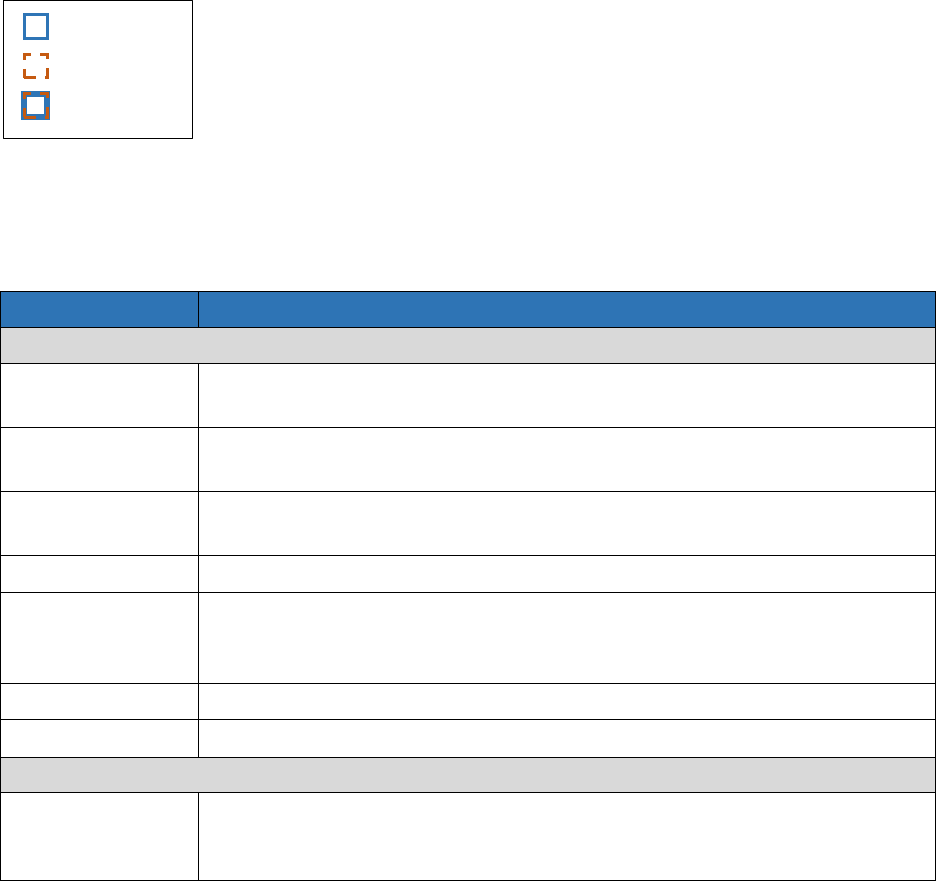
UNCLASSIFIED
29
UNCLASSIFIED
3. ICAM Data Flows
This section provides generic data flows for the ICAM capabilities described in Section 2. These flows
represent OV-5b activity flows. The intent of these data flows is to provide patterns for how ICAM
capabilities will function to promote interoperability across the DoD enterprise, COIs, and local
implementations. The data flows indicate on possible path, but in some cases actions may be performed
in a different order. For some capabilities, multiple data flow options are described. Information systems
may use one or more of the data flow options, depending on specific mission needs. Systems and
services shown in these data flows may be operated at the DoD enterprise, DoD Component,
community, or local level. In addition, a single service may provide the capabilities of more than one
system shown in the data flow diagram, especially for services operated at the COI or local level. Data
flows apply both to DoDIN connected systems and to standalone or closed restricted networks. For
disconnected or intermittently connected systems, the services shown would either be locally managed
and operated or would use local services that periodically obtain and cache data from enterprise
services.
As shown in the box to the left, entities and services operated internal to the
DoD are shown in blue, entities and services operated externally to the DoD are
shown in brown with a dashed line, and entities and services that may be either
internal or external to the DoD are shown by a thick blue box with an internal
brown dashed line.
Table 3 describes the entities and services that are used in the data flow diagrams. Examples of existing
DoD enterprise ICAM services are listed in bold italic font in the “Name” column. Descriptions of these
enterprise ICAM services as well as services that are currently in development are provided in Section 5.
Table 3 – ICAM Data Flow Entities and Services
Name
Description and Functionality
Entities
Entity
The entity whose identity is being managed and that will be requesting
access to resources
Approver
An entity who is authorized to approve the creation and maintenance of
digital identities
Sponsor
A person entity who is responsible for the operations and actions of another
entity such as an NPE or a mission partner entity
Resource Owner
A person entity or organization that is responsible for a resource
Requestor
An entity requesting that another entity be authorized access to a resource.
The requestor may be the entity that is requesting access or may be
another person entity or NPE requesting the access on the entity’s behalf
Manager
A person entity who has supervisory authority over an entity
Reviewer
A person entity or NPE responsible for reviewing ICAM related logs
Services
Local Identity
Manager
A data repository where identity related attributes are on-boarded and
managed for a set of entities
Verifies attribute value correctness and currency
DoD service
External service
Either DoD or
External service

UNCLASSIFIED
30
UNCLASSIFIED
Name
Description and Functionality
Provides updates to entity and attribute values to identity manager
Identity Manager
PDR
A data repository where identity related attributes are collected and
managed for a set of entities
Obtains entity and attribute values from local identity managers
Assigns unique identifiers to entities
Provides identifiers and identity information to CSPs and entity data
repositories
Entity Data
Repository (EDR)
A data repository that holds identifiers, credential information, and other
attributes for a set of entities
Obtains identifiers and attributes from identity managers
Generates identifiers for mission partner entities that are not contained in
identity managers
Registers credentials for internal and federated entities
Provides identifiers to IdPs and information systems based on the credential
used to authenticate
Provides attributes to information systems, provisioning systems, and other
systems and services
Authoritative
Attribute Source
milConnect, TASS
A data repository where ICAM authorization attributes are on-boarded and
managed for a set of entities
Verifies attribute value correctness and currency
Provides updates to entity and attribute values to attribute services
Attribute Service
EIAS, IdSS
A data repository where ICAM authorization attributes are collected and
managed for a set of entities
Obtains attribute information from authoritative attribute sources
Provides attribute values to provisioning systems, policy decision points,
and other systems and services
Credential Service
Provider (CSP)
DoD PKI, RAPIDS,
DS Logon
A system that issues, maintains, and revokes credentials
Obtains identifier and other information from identity managers
Generates and issues credentials to entities based on approval and identity
proofing
Maintains credentials
Revoke credentials in response to authorized requests
Provides credential validation, either directly or through publication of
revocation lists or other artifacts
Resource Policy
Service
A data repository where digital policy rules governing access to resources
are stored
Accepts and maintains digital policy rules defined by resource owners
Provides digital policy rules to entitlement provisioning services and policy
decision points
Entitlement
Provisioning
Service
A data repository that stores entitlements for a set of entities and provides
entitlements to information systems
Accepts information regarding entitlements from information systems

UNCLASSIFIED
31
UNCLASSIFIED
Name
Description and Functionality
Provides an interface for manual provisioning and de-provisioning actions
by authorized users
Obtains digital policy rules from resource policy services for use in dynamic
provisioning
Obtains attributes from entity data repositories and attribute services for
use in dynamic provisioning
Makes dynamic provisioning and de-provisioning decisions based on digital
policy rules and entity attributes
Provides entity entitlement information to information systems
Information
System
A system that hosts resources
Performs direct credential validation or processes authentication assertions
from approved IdPs
Defines entitlements and provides them to entitlement provisioning
services
Obtains entitlement information from entitlement provisioning services
(Optional) requests dynamic access authorization from a policy
enforcement point
Provides resource access to authorized entities
Reverse Proxy
Identity Provider
(IdP)
A system that performs direct authentication and optionally authorization
on behalf of one or more information systems
Authenticates entities
Provides authentication information to information systems located in-line
behind the reverse proxy using a format that can be consumed by each
information system
(Optional) determines if entities are authorized to access resources hosted
by each information system
Identity Provider
(IdP)
IdSS
A system that performs direct authentication of entities and provides an
authentication assertions to the entity for use in authenticating
Authenticates entities
Obtains identifiers from entity data repositories for entities whose
credentials do not directly contain the appropriate DoD identifier
Generates authentication assertions that include the DoD identifier, IAL and
AAL of the authentication
Provides authentication assertion back to the entity or to the information
system
Policy Enforcement
Point (PEP)
A system that responds to dynamic access requests from information
systems
Receives access request
Provides information regarding the access, including the identifier of the
requesting entity, the action, and resource or resources requested to a
policy decision point
Receives authorization decision information from a policy decision point
and provides it to the information system

UNCLASSIFIED
32
UNCLASSIFIED
Name
Description and Functionality
Policy Decision
Point (PDP)
A system that responds to dynamic access requests from policy
enforcement points to make a real-time dynamic access decision for one or
more resources
Obtains information regarding the access, including the identifier of the
requesting entity, the resource or resources requested from a policy
decision point, and the type of access requested
Obtains digital policy rules for requested resources from a resource policy
service
Obtains entity attributes from the entity data repository and attribute
services identified in the digital policy rules
Obtains environmental or other attributes identified in the digital policy
rules
Makes an authorization decision by determining if the requirements of the
digital policy rule have been satisfied
Provides the authorization decision to the policy enforcement point
Log Management
System
A data repository that hosts ICAM related event logs
Obtains ICAM related event logs from information systems, provisioning
systems, reverse proxy IdPs, and other systems
Provides ICAM related event logs to monitoring services
Supports person entity or NPE review of logs to identify anomalous
behavior
Master User
Record (MUR)
A data repository that hosts a record of entitlements entities have been
granted
Obtains entitlements from entitlement provisioning services
Obtains organizational information from identity managers
Provides detailed entitlement reports for all entities that share a common
manager
Contact Data
Repository
EDS, GDS
A data repository that hosts contact information for a set of person entities,
resources, and NPEs
Obtains contact attributes from identity managers and attribute services
(Optional) provides an interface for entities to update contact attributes
that are self-asserted
Provides a search capability for authorized users to obtain contact data
3.1. Core ICAM Capabilities
This section provides data flows for core ICAM capabilities including identity management, credential
management, and access management. These core ICAM capabilities depict portions of the end-to-end
flows for the lifecycle management of Identities and Credentials, and of the processes to manage and
implement authentication and authorization. End-to-end flows will be tailored to specific technologies,
mission partner integration, and mission needs.
Identity Management
This section addresses identity management for person entities, NPEs, and federated entities.

UNCLASSIFIED
33
UNCLASSIFIED
3.1.1.1 Person Entity
Digital Identity Creation
Figure 4 illustrates the services and steps for creation of a new digital identity. The role of the identity
manager is to assign unique identifiers for all users and to store identity attribute data about each user.
In a large distributed enterprise such as the DoD, identity information may be first entered into a local
identity manager which then interfaces with the enterprise identity manager to obtain the unique
identifier. The identity manager also registers the new digital identity by providing the identifier and
appropriate attributes to the entity data repository. The role of the entity data repository is to support
authentication and authorization events for the enterprise.
Figure 4 – Person Entity Identity Creation (C1.1.1)
Digital Identity Maintenance
Figure 5 illustrates the services and steps for updating identity attributes managed by the identity
manager. Identity attributes should be updated directly to the same identity manager where the digital
identity was first created and then provided to the enterprise identity manager. The enterprise identity
manager then provides updated information to the entity data repository if the updated attributes are
also stored in the entity data repository. For self-asserted contact attributes, the approver may be the
person entity.
Figure 5 – Modify Identity Attributes (C1.1.1)
Attribute Maintenance
Not all attributes associated with a digital identity are managed at an enterprise level. Authorization
attributes may be managed by separate authoritative attribute sources, depending on the entity and the
attribute. Figure 6 illustrates the services and steps for updating these attributes.
Local Identity
Manager
Identity
Manager
Entity Data
Repository
1. provide identity
information
2. provide identity
information
3. create
identifier
4. provide identifier
5. provide identifier and
identity information
Approver
Local Identity
Manager
Identity
Manager
Entity Data
Repository
1. update attributes
2. provide updated
attributes
3. provide updated
attributes
Approver

UNCLASSIFIED
34
UNCLASSIFIED
Figure 6 – Modify Attributes (C.1.1.1)
Attribute sources must include the unique identifier associated with the entity at the enterprise, DoD
Component, COI, or local level. If the approver does not know the identifier, it may be obtained from an
entity data repository. Attribute services combine attributes for a defined set of entities from one or
more authoritative attribute sources and make those attributes available for use. For self-asserted
contact attributes, the approver may be the person entity.
Digital Identity Deactivation
When a person is no longer affiliated with the DoD enterprise, DoD Component, COI, or local
information system, the digital identity must be deactivated. Systems may retain the digital identity for
audit purposes or in case the entity reestablishes a relationship with the DoD, but identity attributes
must be updated to indicate that the digital identity is no longer active, and credentials must be
revoked. Figure 7 shows the process of systems processing the deactivation notification to verify that
the identity is deactivated in all systems connected to the identity.
Figure 7 – Deactivate Identity (C1.1.1)
Deactivating a digital identity does not necessarily result in that identity being deactivated in
authoritative attribute stores and attribute services. These systems are maintained independently of the
identity management systems. However, because the person entity will no longer have valid credentials,
that person entity will not be able to authenticate. Authoritative attributes stores should update
attributes during their normal refresh cycles, or when notified that the status of a person entity has
changed.
Authoritative
Attribute Source
Attribute
Service
3. update attributes
4. provide updated
attributes
Approver
Entity Data
Repository
1. request
identifier
2. provide identifier
Local Identity
Manager
Identity
Manager
Entity Data
Repository
1. provide deactivation
notification
3. provide deactivation
notification
5. provide deactivation
notification
Approver
Credential
Service Provider
7. request credential
revocation
2. deactivate
digital identity
4. deactivate
digital identity
6. deactivate digital identity
and unregister credentials
8. revoke
credentials
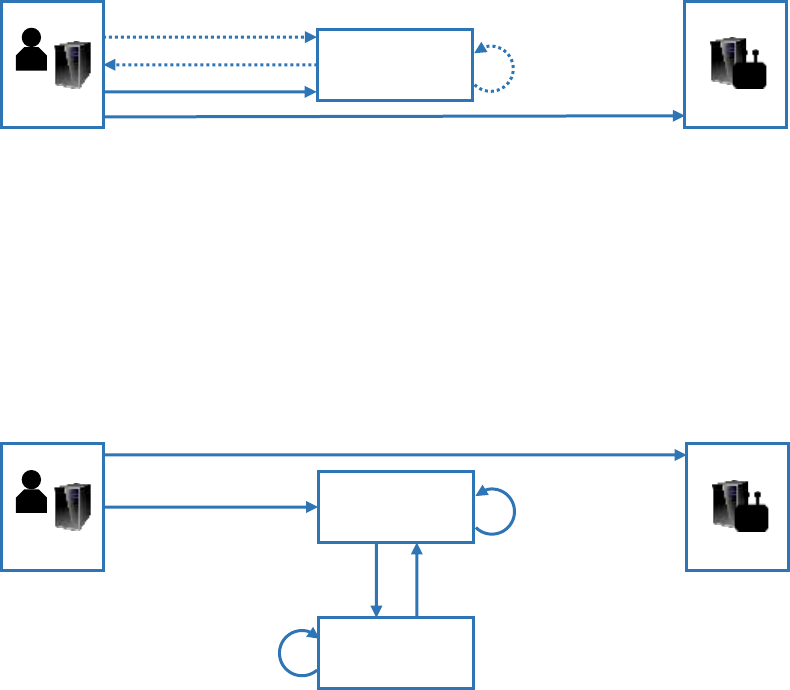
UNCLASSIFIED
35
UNCLASSIFIED
3.1.1.2 NPE
NPE Digital Identity Creation and Maintenance
The creation of a digital identity for an NPE is initiated by a sponsor, as shown in Figure 8. The sponsor
may be a person entity or may itself be an NPE. Depending on the type of NPE, the NPE may have its
own identifier, such as the serial number of a device, or it may be assigned an identifier by an
enterprise, DoD Component, COI, or local level entity data repository. The entity is configured by its
sponsor, and information about the NPE is entered into the entity data repository. If the configuration of
the entity is modified such that attributes are modified, these attributes must be updated in the entity
data repository.
Figure 8 – Create and Maintain NPE Identity (C1.1.2)
NPE Digital Identity Decommissioning
Unlike person entities that are decommissioned but not deleted, digital identities for NPEs do not
necessarily need to be maintained when the entity is decommissioned. When an NPE is
decommissioned, the sponsor notifies the entity data repository, and the entity data repository requests
revocation of any credentials registered to the entity. Once credentials are revoked, the entity data
repository marks the entity as disabled. When the NPE is destroyed, the record can be updated to
indicate it has been destroyed and the record can be archived. Keeping the record as disabled allows for
processes including audits and inventory tracking while the NPE is unused but not yet destroyed.
Figure 9 – Decommission NPE Identity (C1.1.2)
3.1.1.3 Federated Entity
Federated Digital Identity Creation
Digital identities for federated entities are created externally to the DoD. These federated digital
identities and any associated credentials may be registered as described in Section 3.1.2.2.
Federated Digital Identity Maintenance
Digital identities for federated entities are managed externally to the DoD. However, for some external
communities, the DoD may have an agreement to exchange and normalize one or more attributes.
Entity Data
Repository
4. configure NPE
1. request identifier
3. provide identifier
5. add attributes
2. generate
identifier
Entity
Sponsor
Entity Data
Repository
2. provide decommission
notification
1. decommission entity
Credential
Service Provider
4. revoke
credentials
3. request credential
revocation
Entity
Sponsor
6. mark NPE as
disabled and
archive digital
identity record
5. notify of credential
revocation
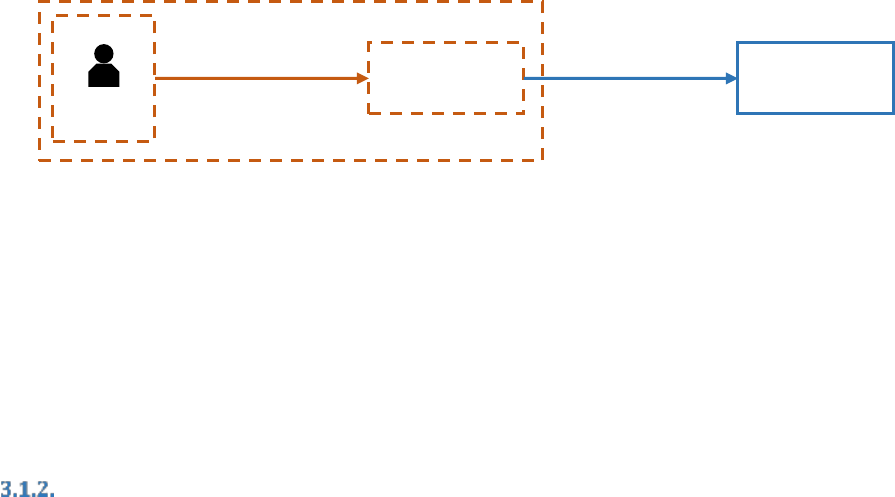
UNCLASSIFIED
36
UNCLASSIFIED
Where such agreements exist, the external identity manager may provide updates to these attributes
directly to the entity data repository as shown in Figure 10.
Figure 10 – Modify Federated Identity Attributes (C1.1.3)
Federated Digital Identity Deactivation
Digital identities for federated entities are deactivated externally to the DoD. Where attribute exchange
agreements exist, the external identity manager will notify the entity data repository of the identity
deactivation using the process shown in Figure 10. External identity managers should also require
revocation of all credentials issued to that entity when a digital identity is deactivated.
Because management of digital identities and attributes for federated entities is not performed by the
DoD, ICAM services that rely on information for federated entities should periodically refresh any stored
information about these entities to verify that the digital identity is still valid.
Credential Management
This section addresses credential issuance, registration, maintenance, and revocation. Credentials that
are issued internally are registered as a part of the credential issuance process. Entities that have
credentials issued by approved external CSPs may register those credentials at the enterprise, DoD
Component, community or interest, or local level in order to use those credentials to authenticate for
access to DoD resources.
3.1.2.1 Internal Credential Management
Credential Issuance
Figure 11 illustrates the process for issuing a credential to a registered entity. This process assumes that
the entity has prior approval to obtain the credential, see Figure 5 in Section 3.1.1.1 for information on
how to register a person entity, and Figure 8 in Section 3.1.1.2 for information on how to register an
NPE. Registration and credential issuance may take place at the same time or registration may happen
before issuance. For example, an entity requesting a new credential because their current credential is
about to expire may already be approved for the new credential. Alternatively, a workstation may
obtain its credential as part of the process of initial configuration. The entity or its sponsor (for NPEs that
are not able to request credentials directly) starts the process by submitting the request. The entity
must provide information to prove its identity so that the CSP can verify that the entity is authorized to
obtain the requested credential, and obtain the unique identifier for the digital identity associated with
the entity. The CSP then creates a credential that includes the identifier and provides the credential or
associated authenticator to the entity. The CSP also registers the credential with the entity data
repository.
Identity
Manager
Entity Data
Repository
1. update attributes
2. provide updated
attributes
External Services
Approver
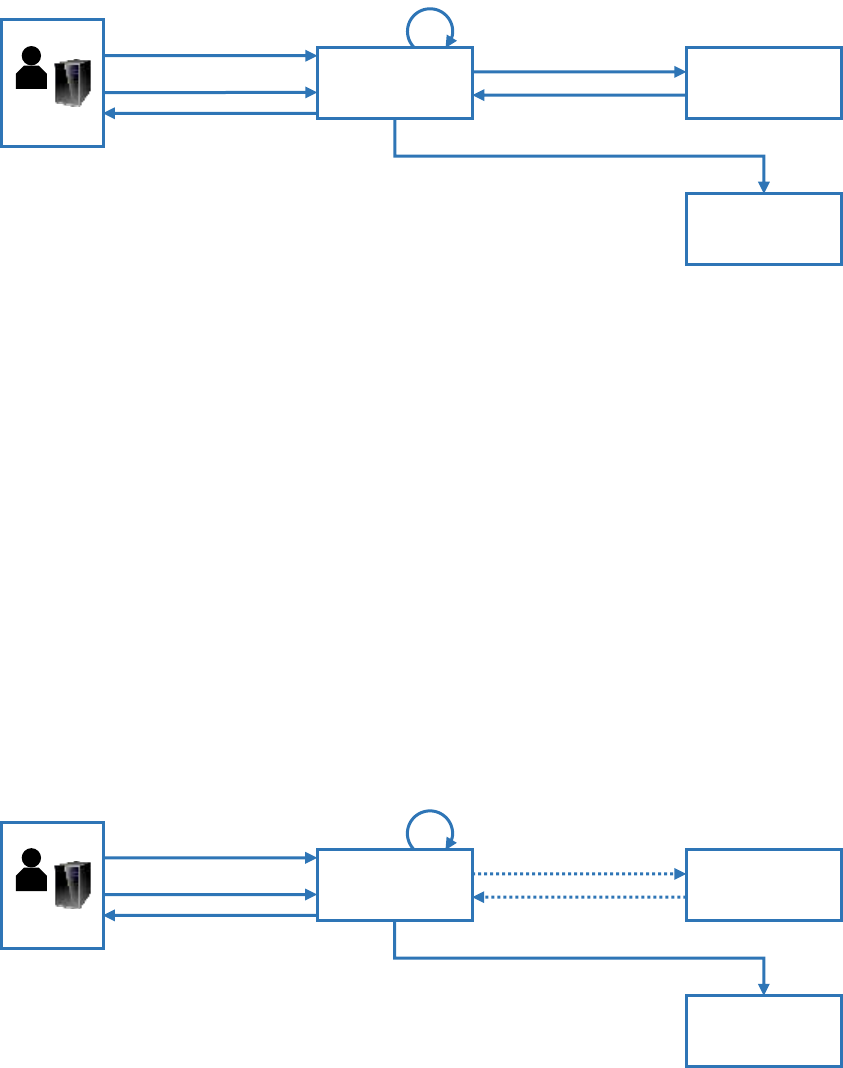
UNCLASSIFIED
37
UNCLASSIFIED
Figure 11 – Credential Issuance (C1.2.1)
Derived Credential Issuance
Derived credentials are credentials that are issued based on electronic authentication of an existing
credential, and may have a different form factor than the original credential. Derived credentials have
the same IAL as the credential used to authenticate, and may have the same or lower AAL depending on
the type of credential. Revocation of the primary credential does not necessarily mean automatic
revocation of the derived credential. For example, loss of the primary credential does not mean that a
derived credential must be revoked. Because derived credentials are based on eligibility to hold the
primary credential as part of the process to create the derived credential, if the entity is no longer
eligible to hold the primary credential, the derived credential must also be revoked.
Figure 12 illustrates the process for issuing a derived credential. The entity starts the process by
authenticating to the CSP that will issue the derived credential. The CSP must validate the credential,
which may require requesting and obtaining validation from a different CSP if the CSP issuing the
derived credential is different than the CSP that issued the original credential. The CSP then creates a
credential based on the information contained in the original credential and provides the credential or
associated authenticator to the entity. The CSP also registers the credential with the entity data
repository.
Figure 12 – Derived Credential Issuance (C1.2.1)
Credential Maintenance
It is the responsibility of the CSP to document credential maintenance support and data flows.
CSP
Identity
Manager
Entity Data
Repository
1. request credential
3. verify authorization
5. create
credential
4. provide authorization
and identifier
7. provide credential
2. provide proof of identity
6. provide credential
Entity
CSP CSP
Entity Data
Repository
1. request authentication
5. create
credential
7. provide credential
4. request credential
6. provide credential
Entity
2. request validation
3. provide validation

UNCLASSIFIED
38
UNCLASSIFIED
Credential Revocation
Figure 13 shows the process for revoking credentials. The approver may be the entity holding the
credential, or may be another authorized entity. Once the CSP has verified that the approver is
authorized, the CSP revokes the credential and notifies any connected entity data repositories that the
credential has been revoked and should no longer be bound to the entity. CSPs are also responsible for
providing revocation information to any requesting system, either through publication of a list of
revoked credentials or though providing validity information upon request.
Figure 13 – Credential Revocation (C1.2.1)
3.1.2.2 External Credential Registration
Entities whose identity is managed outside of the DoD and who are issued credentials by external
approved credential providers may be registered in an entity data repository in order to use their
external credentials to authenticate for access to DoD resources that require provisioned access, or
when DoD managed attributes are associated with the entity that are needed for resolving dynamic
access policy rules. Credential registration is not required when all attributes needed for making
dynamic access decisions are either contained within the credential or are provided by the federated
mission partner at the time of access request through an assertion.
Registration may happen at an enterprise, DoD Component, COI, or local level, and may be performed
prior to the access request or dynamically at runtime by an information system the first time access is
requested. As shown in Figure 14, the entity data repository must validate that the credential presented
by the entity was issued by an approved credential provider and that the credential is valid. If
agreements for exchanging identity attributes exist between the external entity’s identity manager and
the entity data repository, the entity data repository may obtain and cache additional attributes about
the entity at the time of registration. The attributes must be received as a normalized collection, or
normalized internally, before acceptance and storage. The entity data repository must determine if the
entity has already been registered and assigned an identifier, by checking internal to the entity data
repository and by querying the identity manager to determine if a record of the entity exists there. If the
entity has already been registered, then the entity data repository must map the new credential to the
existing digital identity and identifier. If the entity has not been previously registered, the entity data
repository must create a new digital identity and assign a new identifier. Identifiers assigned by the
external identity manager should be used instead of assigning a new DoD only identifier when externally
managed identifiers are persistent and will not create possible collisions.
Credential
Service Provider
Entity Data
Repository
1. request revocation
3. notify of revocation
2. revoke
credential
Approver
4. unregister
credential
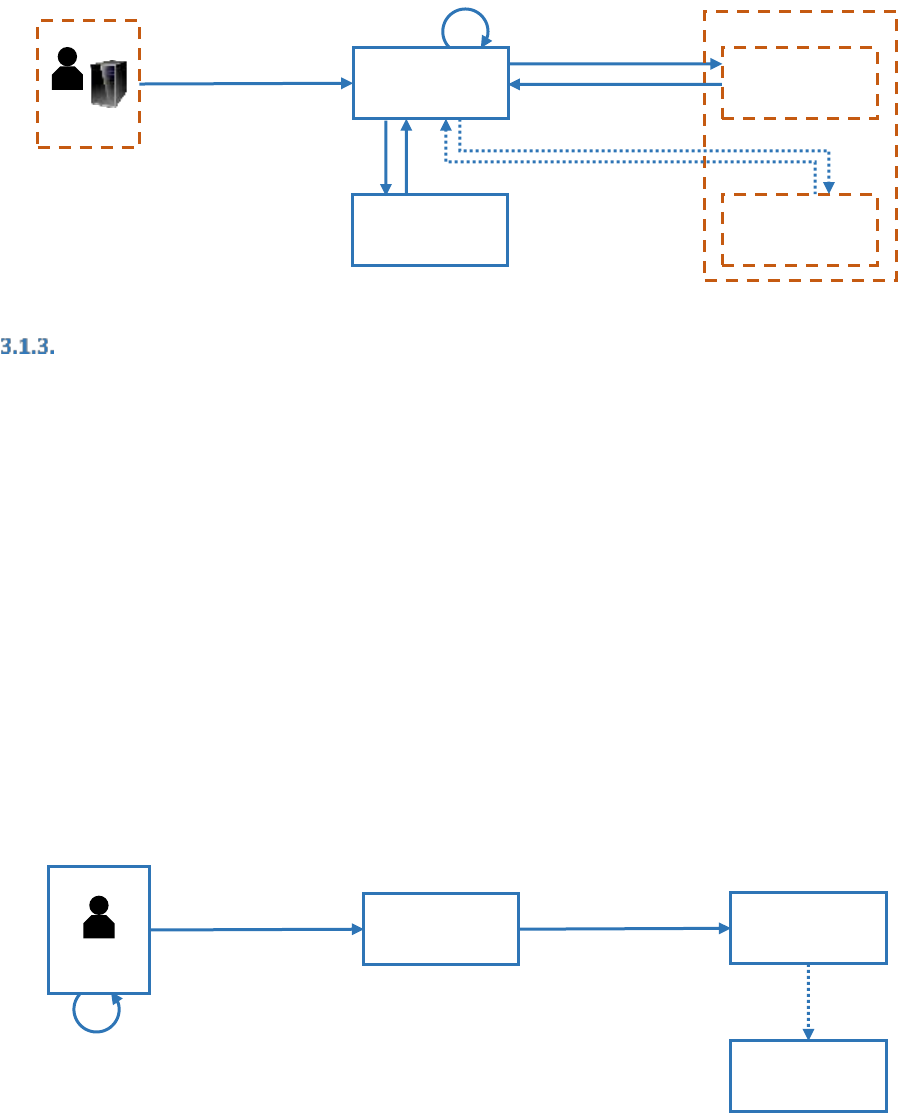
UNCLASSIFIED
39
UNCLASSIFIED
Figure 14 – Credential Registration (C1.2.2)
Access Management
This section addresses access management patterns, including establishing access rules for resources,
provisioning entities with entitlements, authentication, and authorization. Different patterns may be
implemented by different information systems and resources depending on the environment,
capabilities, and needs of the information system hosting the resource. The services described in these
patterns may be operated independently, or the capabilities may be combined. For example, a COI may
operate a single service that acts as an entity data repository, IdP, and entitlement provisioning service.
3.1.3.1 Resource Access Management
Resource Access Management via Hosting Information System
Figure 15 shows the process for managing access to resources when access to resources is managed by
an information system hosting the resource. The resource owner must identify the digital policy rule for
accessing the resource and encode this rule in a digital-readable form in a resource policy service. When
the resource is hosted by an information system, the policy rule is bound to an entitlement that is
defined in the information system that meets the digital policy rule. If a new entitlement is defined, this
new entitlement is uploaded to the entitlement provisioning service used by the information system. If
the resource is only hosted by a single information system, the information system may act as the
resource policy service.
Figure 15 – Resource Access Management via Hosting Information System (C1.3.1)
Resource Access Management via Data Tagging
Figure 16 shows the process for managing resource access when the access policy is bound to the
resource itself through data tagging. The resource owner must identify the digital policy rule for
8. map to or
assign identifier
Entity Data
Repository
Credential
Service Provider
Identity
Manager
1. request registration
2. validate credential
6. query for existing
entity identity record
Identity
Manager
External Services
3. provide credential
information
4. request attributes
5. provide attributes
7. provide attributes
Entity
Resource
Policy Service
3. bind policy rule to
entitlement
1. define resource
policy rule
2. publish resource policy
Information
System
Resource
Owner
Provisioning
Service
4. update entitlement in
provisioning service

UNCLASSIFIED
40
UNCLASSIFIED
accessing the resource and encode this rule in a digital-readable form in a resource policy service. The
resource owner then binds the digital policy rule to the resource itself.
Figure 16 – Resource Access Management via Data Tagging (C1.3.1)
3.1.3.2 Provisioning
Manual Entitlement Provisioning
As shown in Figure 17, manual entitlement provisioning via Access Control Lists (ACL) or Role Based
Access Control (RBAC) requires an approver to determine if the entity is authorized to access the
resource. Entitlements may be requested by the entity or the hosting information system, or
entitlements may be pre-approved by the approver without a specific request being made. The approver
may be acting on a request to add the entitlement, or may be following an on-boarding or other
process. If the entitlement is authorized, the approver adds the appropriate entitlement for the entity to
the entitlement provisioning service to reflect the authorization. The entitlement provisioning service
may then update the information system’s local access control system to add the entitlement to the
entity if the information system uses locally hosted entitlements and does not refer to the entitlement
provisioning service at runtime. The entitlement provisioning service may also provide an updated
attribute value to an attribute service that reflects the entitlement. For locally managed provisioning,
the entitlement provisioning service may be the information system itself.
Figure 17 – Manual Provisioning (C1.3.2)
Manual entitlement provisioning is commonly used, but is labor intensive, especially for resources that
have a large number of potential users. Manual entitlement provisioning can also result in inconsistent
application of policy rules for access to resources, as these rules may not be formally defined or may
only be understood by a single person.
Dynamic Entitlement Provisioning
Dynamic entitlement provisioning allows an entity or other requestor to be provisioned for access to a
resource based on the digital policy rules governing access without requiring a manual approval,
Resource Policy
Service
3. bind resource
policy to resource
2. publish resource policy
Resource
Owner
Resource
1. define resource
policy rule
Provisioning
Service
5. add entitlement
3.determine
approval
4. add entitlement
Information
System
Approver
Requestor
1. request entitlement
2. notify of request
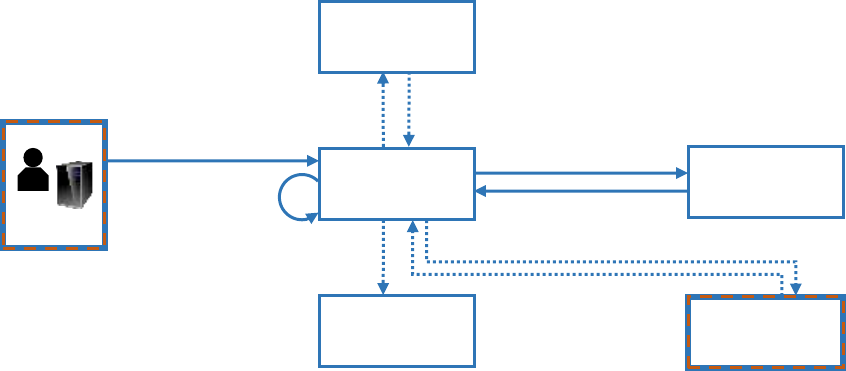
UNCLASSIFIED
41
UNCLASSIFIED
provided that the entitlement provisioning service can determine that the entity possesses the
appropriate attribute values as defined in the digital policy rule. As shown in Figure 18, the requestor
asks for the entitlement. Note that for information systems leveraging ABAC, the requestor may be the
information system itself. The entitlement provisioning service then obtains the appropriate digital
policy rule for the resource, and obtains information about the entity from authorized sources, which
may include the entity data repository and one or more attribute services. If the entitlement
provisioning service is able to verify that the digital policy rule has been satisfied, then the entitlement
provisioning service adds the entitlement for the requestor and may forward the entitlement update to
the information system.
Figure 18 – Dynamic Provisioning (C1.3.2)
Dynamic entitlement provisioning can greatly reduce the time required to provision entitlements to
users, especially for unanticipated users. However, dynamic de-provisioning must also be implemented
so that users who no longer qualify for an entitlement are de-provisioned within an acceptable
timeframe and do not maintain entitlements that they no longer need.
Hybrid Entitlement Provisioning
Hybrid entitlement provisioning uses a combination of dynamic attribute provisioning to partially
determine if the entitlement can be granted but also requires manual approval steps in the workflow to
fully determine if the entitlement should be provisioned.
Entitlement De-Provisioning
De-provisioning uses the same data flows as manual and dynamic provisioning (see Figure 17 and Figure
18) to remove entitlements from entities. When dynamic provisioning is used, the entitlement
provisioning service should either run a periodic process to check for changes in attribute values that
result in removing entitlements from entities, or the entitlement provisioning service should receive
regular updates from attribute services, entity data repositories, and resource policy services and
determine if any changes result in the need to de-provision entitlements.
Provisioning
Service
Information
System
9. add
entitlement
3. provide policy
5. provide
attributes
Entity Data
Repository
6. request attributes
7. provide attributes
1. request entitlement
4. request
identity attributes
Resource
Policy Service
2. request resource
access policy
8. determine
approval & add
entitlement
Requestor
Attribute
Service

UNCLASSIFIED
42
UNCLASSIFIED
3.1.3.3 Authentication
Direct Authentication
In direct authentication, as shown in Figure 19, the entity presents its authenticator to the information
system. The information system validates that the authenticator was issued by the CSP, verifies the
identifier in the credential, and determines that the credential has not expired or been revoked. If the
credential does not contain a persistent unique identifier, the information system requests the identifier
linked to the credential from the entity data repository. If the credential has been registered, the entity
data repository provides the identifier. If the credential has not previously been registered, the entity
data repository generates a new identifier and links it to the credential identifier. If the credential was
issued by an internal CSP and the identifier is present in the credential, the information system does not
need to query the entity data repository for the identifier.
Figure 19 – Direct Authentication (C1.3.3)
Direct authentication provides the greatest resistance to attacks because the information system
obtains credential validation information directly from the CSP. For PKI based authentication, validation
is performed using artifacts that are digitally signed by the same Certificate Authority (CA) that issued
the entity a credential. However, direct authentication is not practical in all cases. For example, direct
authentication is only practical for non-PKI based authenticators if the information system locally issued
the credential. Some information systems do not have interfaces that support direct authentication of
PKI based credentials. Where approved authenticators include PKI based credentials from a number of
different PKIs, or where multiple authenticators will be used, information systems may not correctly
implement the complexity of performing direct authentication.
Direct authentication methods may be complicated if there is a need to inspect the contents of
encrypted sessions. In those cases, the break and inspect process represents a reverse proxy IdP
authentication where the intermediary system performing the inspection acts as the reverse proxy IdP.
Reverse Proxy IdP Authentication
Figure 20 shows authentication using a reverse proxy IdP. In this model, the reverse proxy IdP performs
the authentication on behalf of the information system by validating that the authenticator was issued
by the CSP, verifying the identifier in the credential, and determining that the credential has not expired
or been revoked. If required, the IdP obtains the identifier from the entity data repository. The reverse
proxy IdP then provides an assertion to the information system regarding the identity of the requesting
entity, or the assertion may represent the reverse proxy IdP’s own identity provided that the reverse
proxy IdP maintains a log of the identifier of the authenticated entity. Assertions provided by reverse
proxy IdPs may be configured using whatever format is needed by the information system, provided
that the information system can only be accessed via the IdP.
Information
System
1. request authentication
2. validate credential
4. request identifier
Entity Data
Repository
3. provide credential
information
5. map to or
assign identifier
6. provide identifier
Entity
Credential
Service Provider
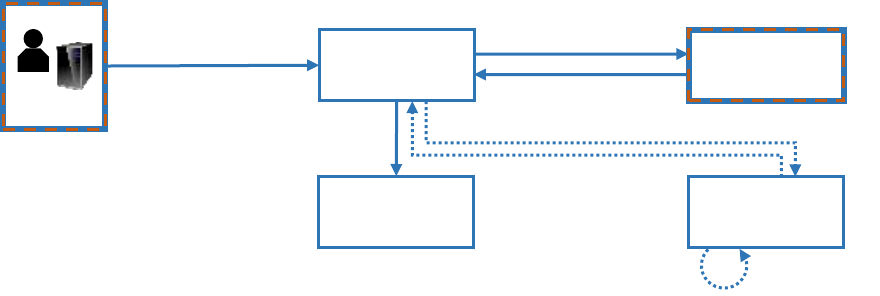
UNCLASSIFIED
43
UNCLASSIFIED
Figure 20 – Authentication using a Reverse Proxy IdP (C1.3.3)
Authentication using a reverse proxy IdP can be used to support a wide variety of mission needs. One
primary use is to enable legacy systems built to outdated standards to meet modern authentication and
authorization requirements. These IdPs must be configured to support whatever authentication and
authorization is supported by the legacy system. Other uses of reverse proxy IdPs include enabling
simplified sign-on to a group of systems that support a similar mission objective, or to support micro-
segmentation in a ZT environment. When used to support needs other than legacy system support,
reverse proxy IdPs must support standards based assertion formats.
Reverse proxy IdP authentication moves the complexity of performing authentication away from the
information system to a dedicated service. The reverse proxy IdP adds an additional element to the
authentication process because assertions are sent directly from the reverse proxy IdP to the
information system. Because the information system only authenticates users via the IdP, this pattern is
significantly more secure than authentication using a general purpose IdP. Use of a reverse proxy IdP
can result in more consistent level of user access, less configuration maintenance, and fewer
implementation errors.
IdP Authentication
Figure 20 shows authentication using an IdP. In this model, the information system initiates the request
for authentication. The IdP performs the authentication on behalf of the information system by
validating that the authenticator was issued by the CSP, verifying the identifier in the credential, and
determining that the credential has not expired or been revoked. If required, the IdP obtains the
identifier from the entity data repository. The external IdP then either provides the assertion directly to
the entity, or provides a one-time artifact back to the entity that the entity provides to the information
system which then requests the assertion from the IdP.
The assertion must contain the appropriate identifier for the entity, as well as the IAL and AAL for the
authentication performed by the IdP which allows the information system to make its own
determination regarding whether the authentication represents sufficient assurance in the identity of
the entity. The assertion may also contain additional attributes which can be used by the information
system in making access decisions.
Reverse Proxy
IdP
1. request authentication
2. validate credential
4. request identifier
Information
System
3. provide credential
information
6. provide identifier
Entity Data
Repository
7. provide assertion
5. map to or
assign identifier
Entity
Credential
Service Provider
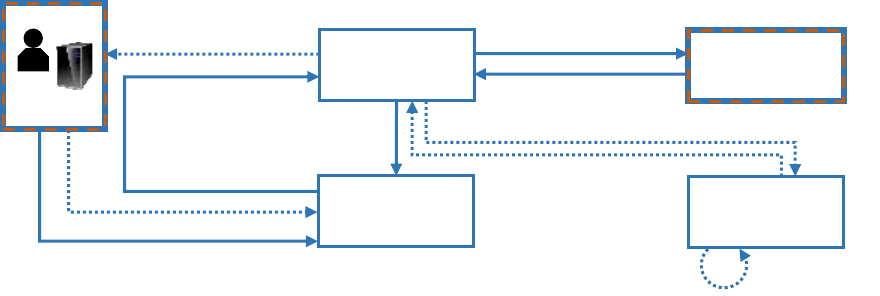
UNCLASSIFIED
44
UNCLASSIFIED
Figure 21 – Authentication using an IdP (C1.3.3)
When using IdP authentication, it is important to protect against replay attacks where an attacker
hijacks the assertion and either replays it to the intended information system or presents it to a
different information system to gain unauthorized access. Requiring holder of key validation in the
assertion is the most secure mitigation approach, but may not be practical or supported by technology
for all use cases. Other protections include timestamping the assertion, designating the intended
recipient in the assertion, and encrypting the assertion with the intended recipient’s public key.
Providing the assertion directly to the information system as shown in this pattern also protects against
replay attacks.
External IdP Authentication
Figure 22 shows the use of an external IdP. In this model, the entity authenticates to the external IdP,
which validates the credential with the external CSP and obtains any relevant information. The external
IdP then provides a one-time artifact back to the entity, passing the assertion by reference. The entity
provides the artifact to the internal relying party, which uses the artifact to request the assertion from
the external IdP. In the figure, the internal relying party is a reverse proxy IdP, but it could be an internal
IdP or even a specific information system. Because the assertion is provided by an external IdP, the
relying party may need to map the identifier contained in the assertion to the entity’s internal identifier
through the entity data repository.
Identity
Provider
4. validate credential
6. request identifier
Information
System
5. provide credential
information
8. provide identifier
Entity Data
Repository
7. map to or
assign identifier
1. request authentication
2. redirect request
3. request
authentication
11. provide
assertion
10. provide artifact
Entity
Credential
Service Provider
9. provide artifact
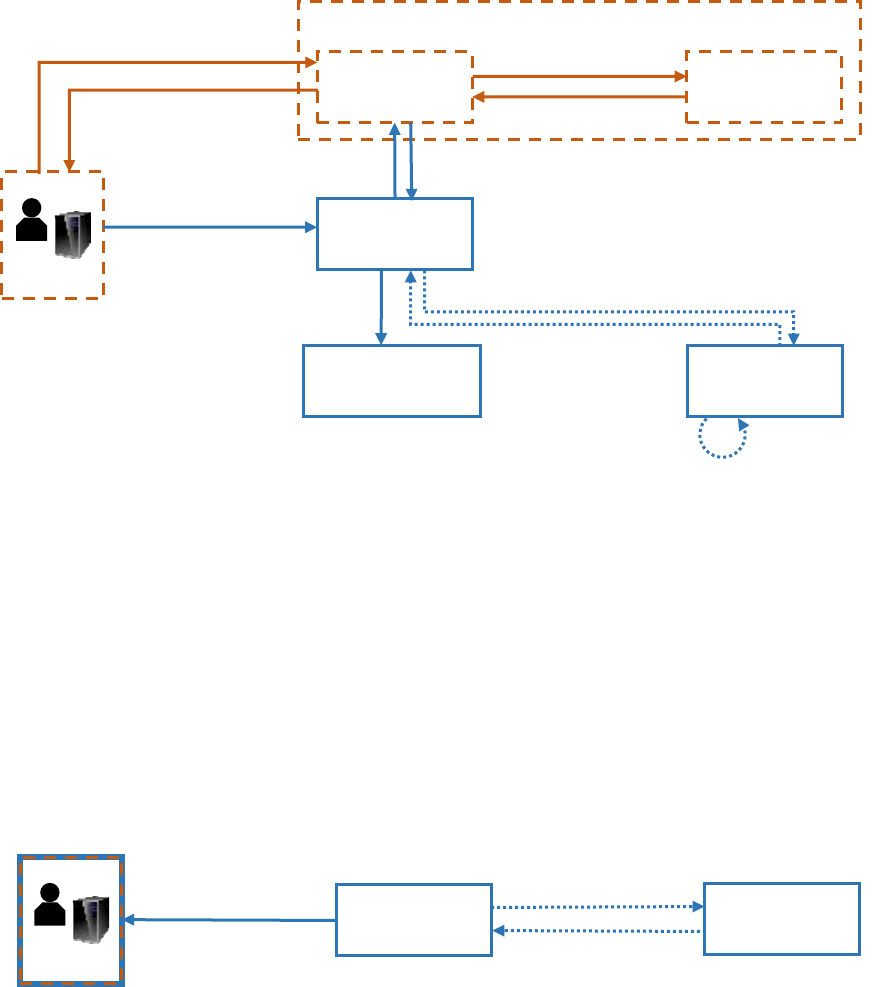
UNCLASSIFIED
45
UNCLASSIFIED
Figure 22 – Authentication of an External Entity using an External IdP (C1.3.3)
External IdP authentication presents similar security concerns to IdP authentication. The use of pass by
reference results in the external IdP providing the assertion directly to the internal reverse proxy IdP via
a secure channel instead of providing it through the entity, which mitigates assertion hijacking attacks.
3.1.3.4 Authorization
Direct Authorization
For provisioned access, once the information system has authenticated the requesting entity, the
information system looks at provisioned entitlements to determine if the entity is entitled to access the
resource as shown in Figure 23. The information system may host entitlements locally or may reach out
to an entitlement provisioning service. If the entity is entitled to access the resource, the information
system provides access to the resource.
Figure 23 – Direct Authorization (C1.3.4)
Direct authorization, especially when entitlements are cached locally, provides the fastest response time
for users who have already been provisioned with appropriate entitlements. Unanticipated users can
only be accommodated by either providing the user with the information needed to be manually
provisioned for access, or by requesting dynamic provisioning where that service is available.
Reverse Proxy IdP Authorization
Generally, information systems manage authorization decisions directly. However, reverse proxy IdPs
may perform authorization decisions on behalf of information systems hosted behind the reverse proxy
IdP. In this model, as shown in Figure 24, the reverse proxy IdP determines if the entity is authorized to
Reverse Proxy
IdP
2. validate credential
Information
System
External Services
3. provide credential
information
Entity
Entity Data
Repository
9. map to or
assign identifier
1. request authentication
4. provide artifact a
Credential
Service Provider
Identity
Provider
8. request identifier
10. provide identifier
5. provide artifact a
11. provide assertion b
7. provide
assertion a
6. request artifact a
resolution
Information
System
1. request entity
entitlement to resource
3. provide requested
resource
Provisioning
Service
Entity
2. provide entitlement

UNCLASSIFIED
46
UNCLASSIFIED
access the resource. If so, the reverse proxy IdP requests the resource and provides access to the
resource to the entity.
Figure 24 – Authorization using Reverse Proxy IdP (C1.3.4)
Reverse proxy IdP authorization is recommended where information systems lack the ability to support
local direct authorization, or where authorization information is centrally managed for a group of
information systems.
Dynamic Access
Access to some resources is provided through dynamic access instead of provisioned access. This model
is also called ABAC. In the dynamic access model, shown in Figure 25, users are not provisioned for
access. Instead, each time an entity requests access to a resource the information system refers the
identifier of the authenticated entity to a policy enforcement point. Alternatively, the policy
enforcement point may initiate the request. The policy enforcement point leverages a policy decision
point. The policy decision point first identifies the digital policy rule governing access to the resource,
then requests attributes from the entity data repository and one or more attribute services. The policy
decision point compares the attribute values to the policy requirements to determine if the entity is
authorized to access the resource. If the policy decision point is not able to identify attribute values or if
the attribute values do not meet the policy rule, then access is not granted. The policy decision point
provides the authorization decision to the policy enforcement point, which forwards it to the
information system. The information system then provides access to the resource if authorized, or
provides the resource to the policy enforcement point which then provides it to the entity.
Reverse Proxy
IdP
Information
System
3. request
resource
2. provide entitlement
5. provide requested
resource
Provisioning
Service
1. request entity
entitlement to resource
4. provide
resource
Entity
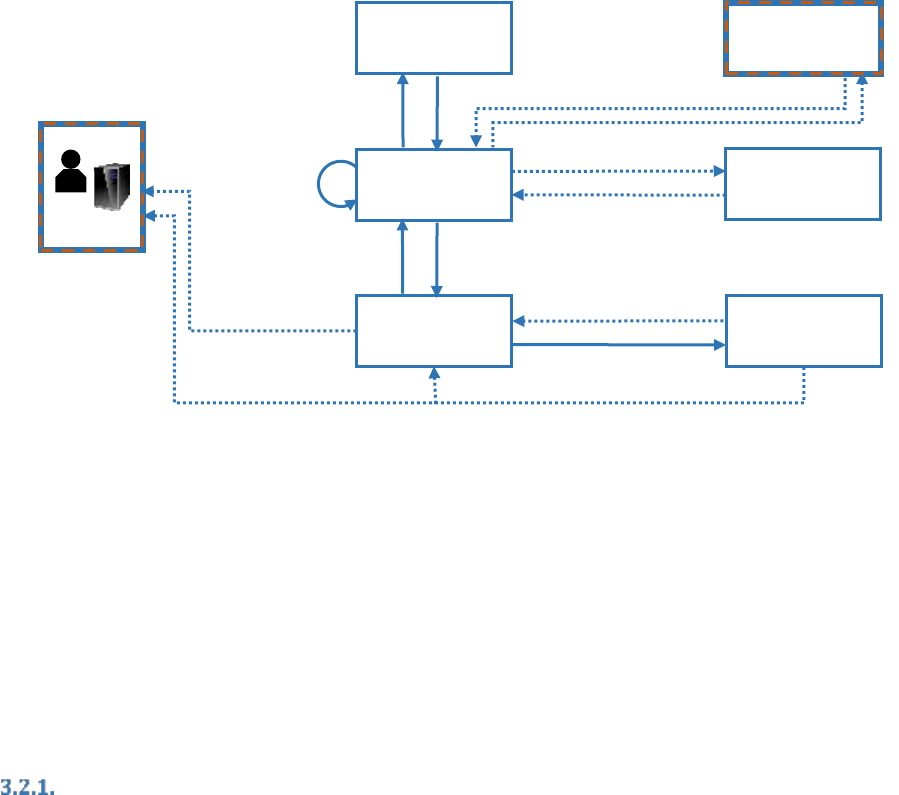
UNCLASSIFIED
47
UNCLASSIFIED
Figure 25 – Dynamic Access using ABAC (C1.3.4)
Dynamic access is well suited for environments with a large number of users, especially when accessing
information resources. Because access is always determined real-time, there is no requirement for
provisioning or de-provisioning. However, dynamic access can introduce delays in the authorization
process if network connectivity is insufficient to support all of the data collection and data exchange
steps. Dynamic access is also not recommended for access to resources that require managing licensing,
or for resources that require the ability to audit who can access the resource, not just who has accessed
the resource.
3.2. Access Accountability Capabilities
This section addresses access accountability capabilities including log collection and consolidation,
access review, and identity resolution.
Log Collection and Consolidation
As shown in Figure 26, each information system or ICAM service creates ICAM event logs. These logs are
then consolidated by a log management system and compared against provisioned entitlements or
resource access policies for each entity. This consolidated log information can then be reviewed by an
authorized reviewer for anomalous activity or provided to an authorized monitoring service.
Policy Decision
Point
Policy
Enforcement
Point
Information
System
11. provide decision
Resource
Policy Service
9. make
authorization
decision
1. request authorization
10. provide
decision
2. request
decision
Entity Data
Repository
Attribute
Service
Entity
4. provide policy
6. provide attributes
7. request attributes
8. provide attributes
5. request
identity attributes
3. request resource
access policy
12. provide requested
resource

UNCLASSIFIED
48
UNCLASSIFIED
Figure 26 – Log Collection and Consolidation (C2.1)
Access Review
Person Entity Centric Access Review
The steps required to perform an access review as shown in Figure 27 can be grouped into four primary
phases. The first phase requires identifying who is responsible for performing the access review for each
entity (step 1). This phase should be performed using organization information contained in identity
managers for both person entities and NPEs. The second phase requires collecting all information about
each entity’s access rights into a single location (steps 3-6). Access rights may be hosted in entitlement
provisioning services or may be based on digital policy rules that rely on attributes hosted by attribute
services. Access rights may also be hosted in information systems that are performing provisioning
locally. In this case, the information system is acting as an entitlement provisioning service. Access
information may also be collected from other systems such as User and Entity Based Analytics (UEBA)
tools. Once information has been collected into a master user record, a report is generated for each
manager or sponsor (step 7). Finally, the manager or sponsor reviews the entitlements listed in the
report. If any entitlements or attributes are incorrect, the manager must use the processes described in
Sections 3.1.1.1 and 3.1.3.2 to update provisioned entitlements and attributes as appropriate. At the
COl level, if a single entitlement provisioning service is used to manage entitlements for all information
systems within the COI, a separate master user record service is not required, as the entitlement
provisioning service can provide all information required to perform access reviews, including
connectivity to attribute services used to support provisioning.
Figure 27 – Person Entity Centric Access Review (C2.2)
Log Management
System
Provisioning
Service
6. provide access logs
12. review logs
Information
System
11. consolidate
log information
8. provide access logs
Reverse Proxy
IdP
Reviewer
CSP
3. create
logs
4. provide credential logs
PEP / PDP
1. create
logs
2. provide access logs
5. create logs
7. create
logs
9. create
logs
10. provide
entitlements
Master User
Record
Provisioning
Service
5. request
entitlements
2. provide organization
information
8. provide users,
entitlements, & attributes
Identity
Manager
1. request organization
information
6. provide entitlements
Manager
7. map entities to
manager
9. review
entitlements
3. request attributes
4. provide attributes
Attribute
Service
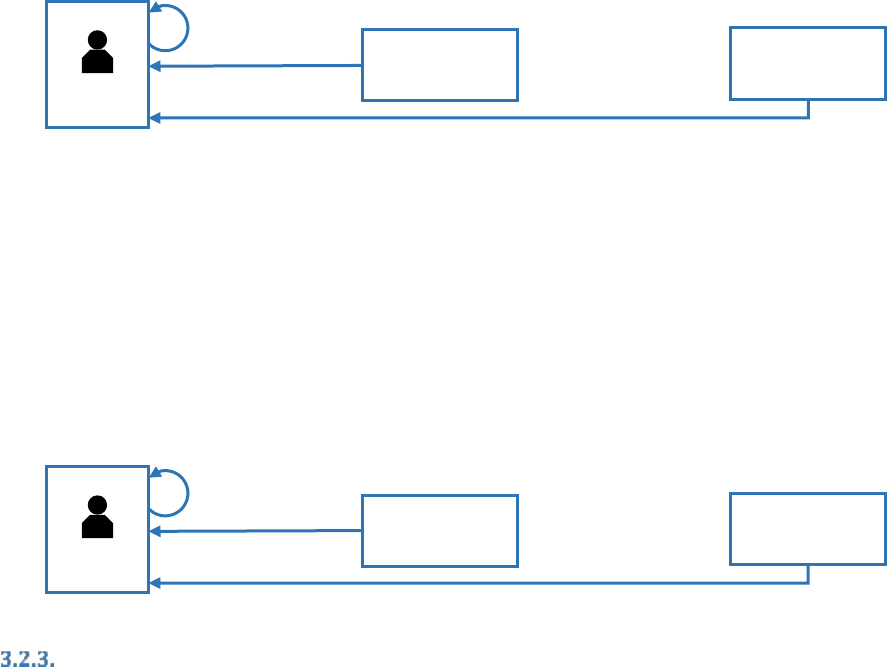
UNCLASSIFIED
49
UNCLASSIFIED
Full access reviews are not practical at the DoD enterprise level, as there will be locally stored attributes
and entitlements. For COIs where access review is needed, the COI must implement processes to ensure
that all attributes are reported to the appropriate master user record.
Resource Centric Access Review
Access reviews may also be performed at an information system level. The reviewer obtains the list of
users and entitlements from the information system, and should also retrieve the list of users and
entitlements from any provisioning system used to provision entitlements for the information system.
As part of the access review, these two lists are first reconciled. Then the reviewer verifies entitlements,
with specific focus on IT privileged user and functional privileged user access. . If any entitlements or
attributes are incorrect, the reviewer must use the processes described in Sections 3.1.1.1 and 3.1.3.2 to
update provisioned entitlements and attributes as appropriate.
Figure 28 – Resource Centric Access Review
NPE Centric Access Review
Many NPEs authenticate to other NPEs in order to perform their functions. These access privileges
should also be reviewed to ensure that NPEs do not have access to information systems they no longer
need access to. In addition, when an NPE is decommissioned, any entitlements provisioned to that NPE
must also be removed. Similar to person entity access reviews, the NPE sponsor obtains information
about the NPE from the entity data repository where it is registered, and from the master user record
which contains information regarding what entitlements are provisioned to the NPE. The sponsor
reviews the attributes and provisioned entitlements and updates any information using the processes
described in Sections 3.1.1.2 and 3.1.3.2.
Figure 29 – NPE Centric Access Review
Identity Resolution
Figure 30 shows the process of performing identity resolution. Entity data repositories and attribute
services should periodically review registered digital identities and flag those that cross a pre-
determined threshold for similarities. For example, if two different digital identities have registered
credentials with the same or very similar names, and share other identity attributes, there is a possibility
that those two digital identities map to the same real-world entity. These services should alert a
reviewer who can analyze the two records and determine if they do map to the same real-world entity.
If so, the reviewer will update the entity data repository to map the two digital identifiers to each other
to create a single digital identity. This process may also be used to evaluate digital identities from more
Information
System
1. provide users, &
entitlements
Provisioning
Service
Reviewer
3. review
entitlements
2. provide users, &
entitlements
Entity Data
Repository
1. provide attributes
Master User
Record
Sponsor
3. review attributes
& entitlements
2. provide entitlements

UNCLASSIFIED
50
UNCLASSIFIED
than one entity data repository, such as if a COI level data repository is being elevated to an enterprise
level.
Figure 30 – Identity Resolution (C2.3)
3.3. Contact Data Capabilities
Supporting contact data lookup requires the collection of contact data into a single repository or virtual
repository and providing search capabilities for entities to obtain contact data from that repository. The
contact data repository may contain all of the necessary information (i.e., is may have been previously
populated) or may need to dynamically request the information from the identity manager, attribute
service or entity data repository. Figure 31 illustrates the steps for collecting contact data into a
searchable repository (steps 1-7) and the process for requesting contact data (steps 8-9). The repository
must collate contact data from one or more data sources for each entity that is included. The repository
may support lookup information for a DoD Component, for a COI, or for the entire enterprise of DoD
internal users. Data sources for contact data may themselves be internal to the DoD, or the repository
may have agreements and technical interconnections in place to host contact data provided by external
services. Generally, contact data attributes will be found in identity managers, but additional attributes
may be collected from the entity data repository or from one or more attribute services. Attributes are
linked by a common identifier for each entity.
When an entity requests contact data, that entity may not know the common identifier, so Contact Data
Capabilities should provide a search interface that allows for searching on multiple attributes, such as
name or organizational affiliation.
Figure 31 – Contact Data Collection and Lookup (C3.1, C3.2)
Because many contact data elements are considered PII, access to contact data must therefore be
protected. Contact data repositories must have appropriate agreements in place with data sources for
the collection and intended dissemination of the data. In addition, entities requesting access to contact
data must be authenticated and authorized to obtain contact data from the repository.
Entity Data
Repository
4. provide alert
2. provide alert
Reviewer
5. review alerts and
identify duplicates
Attribute
Service
6. map identifiers to
merge duplicates
3. flag potential
duplicates
1. flag potential
duplicates
7. collate contact
attributes
Contact Data
Repository
3. request attributes
1. request
identifier(s)
Entity Data
Repository
4. provide attributes
5. request attributes
6. provide attributes
2. provide identifier(s)
Attribute
Service
Identity
Manager
Entity
9. provide contact data
8. request contact data

UNCLASSIFIED
51
UNCLASSIFIED
4. ICAM Patterns and Associated Use Cases
This section describes patterns for ICAM capabilities. These patterns represent Service View (SvcV)-2
resource flow descriptions. These patterns and their related use cases are intended to demonstrate how
capabilities may be implemented to meet a broad set of mission and other needs. They are not intended
to be prescriptive for how a given information system consumes ICAM capabilities, nor are they
intended to describe all possible ICAM use cases.
Use cases have been organized around four capability areas. Identity management and credential
management are combined, as these actions are generally performed together for entities who are
registered prior to requesting access to resources. Access management use cases focus on the real-time
activities of an entity requesting a resource, and include use cases for pre-registered entities as well as
dynamic access for unanticipated entities. Use cases for access accountability and for contact data are
also included.
4.1. Identity and Credential Patterns
These use cases describe patterns for registering users in advance. User registration is needed if
attributes specific to the user will be managed by DoD or if entitlements need to be provisioned specific
to the user. User registration for mission partner entities may not be required if attributes used in access
decisions for the user will be provided via assertions from the user’s IdP.
Depending on the type of user and the use case, identity management may be performed by the DoD or
by a DoD mission partner prior to the issuance of a credential. In other use cases, entities may be issued
credentials based on minimal or no prior identity management activities. Additional attributes for
registered users may also be managed with the DoD or by DoD mission partners.
As shown in the box to the left, services operated internal to the DoD are shown
in blue, services operated externally to the DoD are shown in brown with a
dashed line, and services operated by a COI are shown in black with a dotted
line.
Unclassified Enterprise DoD Internal Initial Registration
Pattern:
Figure 32 – Unclassified DoD Internal Initial Registration
Registration of internal entities includes collecting and verifying identity information about the entity,
creating a digital identity for that entity, and issuing credentials to the entity. The pattern includes the
following four steps:
New entities must be sponsored. For new military and civilian employees, the sponsorship is
through the Component that is initiating the employment. For contractors, the sponsorship is
through the contracting organization. For NPEs, sponsorship is the person or organization that is
responsible for the NPE. The sponsor initiates the on-boarding pattern and facilitates
completion of on-boarding steps.
DoD PKI
Person Data
Repository
Entity Data
Repository
DOD service
External service
COI service
UNCLASSIFIED
52
UNCLASSIFIED
Once an entity is sponsored, information about the entity must be verified and entered into
appropriate identity management systems. For person entities, the verification pattern includes
appropriate background investigation activities. Creation of the new digital identity also involves
assigning an identifier to that identity. For person entities, the identifier is usually the EDIPI
along with the appropriate PTC. If the new user already had an EDIPI assigned, the existing EDIPI
will be used. Otherwise, a new EDIPI will be assigned by the PDR. Person entities are also
assigned a PDN, which is a human readable name used to support contact data lookup
capabilities.
The third step in onboarding is the issuance of one or more credentials to the entity. Person
entities provide proof of their identity and are issued a CAC which contains digital certificates
issued by the DoD PKI. NPEs are issued one or more digital certificates by the DoD PKI based on
identity verification of their sponsor.
Finally, the entity must be provisioned for appropriate physical and logical access by linking
authorization attributes to the entity based on its identifier, and by provisioning entitlements to
the entity.
Use Cases:
4.1.1(a) A new DoD internal person entity reports for duty, and is Identity proofed, credentialed, and
registered.
4.1.1(b) A new NPE with an intended long term existence that requires an identity valid across the DoD
enterprise (such as a web server hosted in a traditional data center) is brought online.
4.1.1(c) A new NPE with an intended limited duration that requires and identity valid across the DoD
enterprise (such as a cloud-based web server) is brought online.
Gaps:
For person entities, basic identity management and credentialing processes are mature, leveraging
Component on-boarding of identity information, assignment of an EDIPI and EDIPI+PTC through the
PDR, assignment of an Enterprise Name and Enterprise Name+PTC, and the issuance of a CAC with
digital certificates from the DoD PKI that contain the Enterprise Name and Enterprise Name+PTC.
However, processes to provision attributes and entitlements beyond core identity attributes are
decentralized and manual, and the attributes and values are not normalized across the Components.
As DoD adopts SaaS, provisioning person entities to those SaaS is becoming a critical gap.
For NPEs, manual processes exist to issue credentials from the DoD PKI. However, enterprise
registration and naming capabilities are lacking. Fully automated processes for NPEs are also lacking.
The Entity Data Repository (EDR) does not currently exist.

UNCLASSIFIED
53
UNCLASSIFIED
Unclassified Enterprise Mission Partner Entity Registration
Pattern:
Figure 33 – Unclassified Mission Partner Entity Registration
For this pattern, mission partner entity identities are created and managed externally to the DoD, and
the mission partner entity is provided with a credential from a DoD approved external credential
provider. For some mission partners, such as Federal Agencies and some Defense Industrial Base (DIB)
companies, limited attributes for the use may be made available to the DoD through an attribute
exchange process. Other attributes for registered mission partner entities may be managed internally by
the DoD enterprise or by DoD COI attribute stores. To support attribute and entitlement management,
these entities must be assigned a persistent DoD identifier which can be linked to their credential and
accessed by DoD relying parties. The pattern includes the following three steps:
Prior to accepting externally issued credentials, the DoD must establish a trust relationship with
the external credential provider or identity manager. As part of this relationship, the DoD and
the external provider define the type(s) of credentials that will be accepted, what identifiers are
used in those credentials, what, if any, additional attributes will be made available, and what the
process is for requesting and obtaining additional attributes. As part of the trust establishment
process, the external provider may pre-register existing users with the DoD to facilitate these
users obtaining access to DoD resources.
When a mission partner entity with an approved credential requests registration, the DoD
validates the presented credential and determines if the credential has been pre-registered. If
not, the DoD assigns a persistent identifier to the user and links the credential to the identifier.
For some users, such as Federal Agency mission partner entities whose certificates contain a
federally recognized unique identifier, the DoD may assign the identifier contained in the
credential as that user’s DoD identifier. If there is no globally unique identifier contained in the
credential, the DoD will generate a new identifier and link it to the credential.
Once an entity has been registered, the entity may be provisioned for appropriate physical and
logical access by linking authorization attributes to the entity based on its identifier, and by
provisioning entitlements to the entity.
Use Cases:
4.1.2(a) One or more DoD relying parties have identified a requirement to interact with entities from
one or more Federal Agencies. These entities have been issued PIV cards by their agency.
4.1.2(b) An individual from a Federal Agency who has been provisioned with a PIV card by their agency
has identified a need to access a DoD resource.
4.1.2(c) One or more DoD relying parties have identified a requirement to interact with entities from a
DIB partner that issues DoD approved credentials to its employees and affiliates.
Entity Data
Repository
Mission Partner
Identity Manager
Mission Partner
PKI
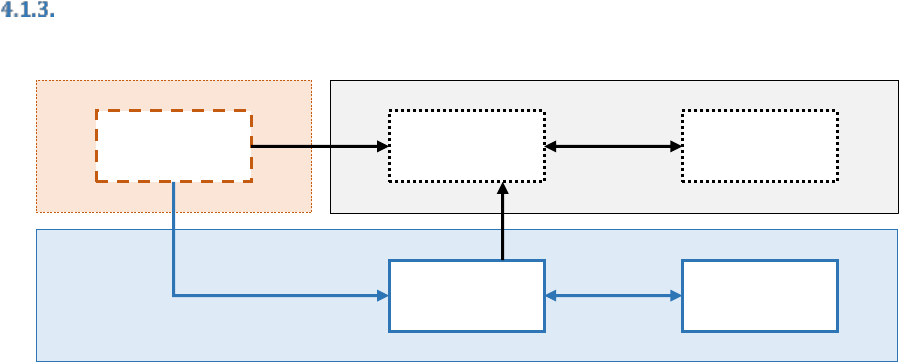
UNCLASSIFIED
54
UNCLASSIFIED
4.1.2(d) A DoD mission partner entity with a DoD approved credential has identified a need to access a
DoD resource.
Gaps:
The DoD does not have an enterprise registration capability for mission partner entities that have DoD
approved external credentials. Some relying party information systems support local registration of
mission partner entities. Others do not support registration of mission partner entity credentials and
deny mission partner entities access or require mission partner person entities to obtain CACs in order
to gain access.
Some DoD resources use the DoD issued EDIPI as the durable unique identifier for person entities.
Because mission partner entities with externally issued credentials, including other Federal agencies and
the DIB, do not have EDIPIs associated with their external identities, they are unable to access these
resources.
Community of Interest User Registration
Pattern:
Figure 34 – COI User Registration
Supporting all users in this environment requires the implementation of a COI IdP to support all relying
parties within the COI that supports four types of users:
DoD Internal users with DoD issued PKI certificate use these certificates with the EDIPI
identifiers contained in their certificates within the COI. The COI data repository obtains
information about these users from the DoD enterprise Person Data Repository. Certificate
status is verified either by periodically obtaining and caching Certificate Revocation Lists (CRL)
from the DoD PKI, by using the real time certificate validation service using Online Certificate
Status Protocol (OCSP) service from the DoD PKI, or by using a COI operated OCSP service that
provides certificate revocation status information for the DoD PKI.
Mission partner entities with certificates from DoD approved external PKIs who have been
registered at the DoD enterprise level use their certificates and the DoD enterprise identifiers
that have been assigned at registration. The COI data repository obtains information about
these users from the DoD enterprise Person Data Repository. Certificate status is verified either
by periodically obtaining and caching CRLs from the external PKI, using an external PKI OCSP
service, or by using a COI operated OCSP service that provides certificate revocation status
information for the DoD approved external PKIs.
Person Data
Repository
DoD PKI
Mission Partner
Identity Manager
COI Entity Data
Repository
COI CSP
UNCLASSIFIED
55
UNCLASSIFIED
Unanticipated mission partner entities with certificates from DoD approved external PKIs who
have not been registered at the DoD enterprise level use their certificates. These users are
registered upon their first authentication by the COI data repository. The full distinguished name
in the certificate can be used as a COI identifier. Relevant attributes from the PKI certificates are
persisted with the registration. Certificate status is verified either by periodically obtaining and
caching CRLs from the external PKI, using an external PKI OCSP service, or by using a COI
operated OCSP service that provides certificate revocation status information for the DoD
approved external PKIs.
Mission partner entities without certificates issued by DoD approved external PKIs or COI
participants whose identity information is not available as a result of lack of network
connectivity are provided credentials by a COI CSP. These credentials are limited for use within
the COI. The authorizing official for the COI must approve the identity proofing processes and
credential authenticators used and how those authenticators will be validated, based on the
sensitivity of resources available to the network and the operational needs of the COI
environment.
Use Cases:
4.1.3(a) The DoD is operating an unclassified network to support a coalition exercise. DoD members of
the coalition have CACs with digital certificates issued by the DoD PKI. Some coalition partners also have
hardware based PKI credentials issued by DoD approved external PKIs. Other coalition partners do not
have credentials they can use within the coalition and must be issued new credentials. The coalition
network has limited connectivity to the DoDIN.
4.1.3(b) A DoD unit is operating at the tactical edge with intermittent or limited connectivity to the
DoDIN. DoD enterprise ICAM information for person entities can be periodically downloaded to the
tactical environment, but local credentials must be supported for local NPEs and for users who join the
community while connectivity to the DoD enterprise is not available.
Gaps:
This use case does not depend solely on DoD enterprise ICAM services. DoD enterprise ICAM services for
identity management and credential issuance to DoD internal users are mature, see 4.1.1. Some COIs
have implemented the capability to issue local credentials, but may not be following consistent
standards for identity lifecycle management. Acceptance of mission partner credentials by COIs is
limited.
Closed Restricted Networks and Standalone Systems/Networks offer significant challenges because
there is (by design) no access to enterprise capabilities.
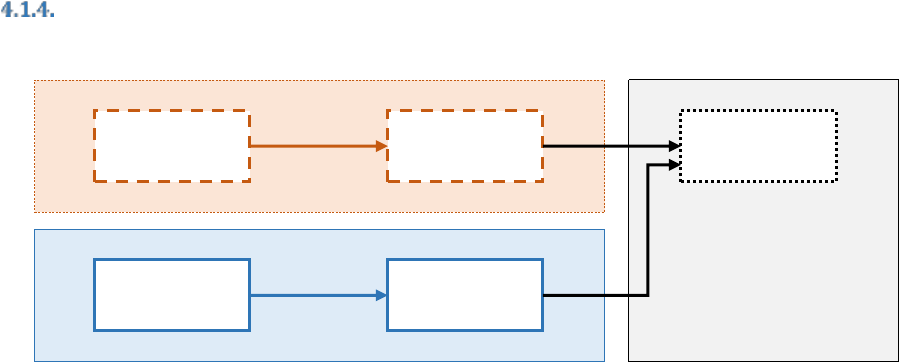
UNCLASSIFIED
56
UNCLASSIFIED
Community of Interest Person Entity Identity Provider Registration
Pattern:
Figure 35 – COI IdP Registration
The previous use cases all involve registration of the end entity users. For this use case, users are
registered within their own network, but are not registered with the COI. Instead, the public keys for
each IdP operated by each mission partner participating in the information exchange are registered
using an out-of-band mechanism such as manual in-person transfer. Once the COI registers the IdPs,
relying parties within the COI can validate assertions from the IdPs and leverage information contained
in the assertions to make access decisions. Although not shown in the figure, assertions provided by the
mission partner or DoD IdPs can also include additional attributes needed by the COI.
Use Cases:
4.1.4(a) A Secret//Releasable COI is formed to share information among the DoD and coalition mission
partners. All resources within the COI are labeled for releasability by country and possibly additional
attributes such as mission name or user role, but not specifically by user.
4.1.4(b) Digital policy rules for access to resources are established such that access is governed based on
the organization requesting the resource, such as a Federal Agency or DIB partner.
4.1.4(c) Digital policy rules for access to resources are established such that access is governed based on
the organization requesting the resource and the value of attributes asserted by the user’s organization.
Gaps:
Currently, the DoD does not provide an enterprise IdP capability. Some mission partners have
implemented IdPs, but others do not support this capability. As a result, the COI would need to
implement a COI IdP for validating credentials for DoD and mission partner entities that do not yet
operate an IdP that allows users to authenticate at their home organization. A COI operated IdP can
provide organization information based on the credentials being validated, but the COI IdP would not be
able to provide user attributes beyond those asserted in the user credentials.
Many relying party information systems are not configured to securely process authentication assertions
in lieu of performing direct credential validation. Addressing the gaps in this use case requires modifying
relying party authentication behavior in addition to registration capabilities.
DoD PKI DoD IdP
Mission Partner
CSP
Mission Partner
IdP
COI IdP
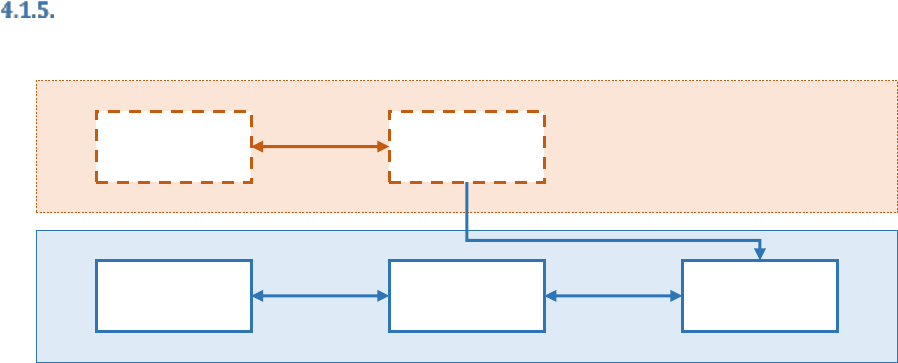
UNCLASSIFIED
57
UNCLASSIFIED
Secret Enterprise Registration for DoD and Federal Agencies
Pattern:
Figure 36 – Secret Network Initial Registration
Identity data for most DoD person entities is managed in the NIPRNet PDR and then a subset of that
data is uploaded to the SIPRNet PDR. Users with SIPRNet accounts can obtain credentials from the DoD
portion of the NSS PKI. NPEs can also obtain credentials from the DoD NSS PKI.
The NSS PKI also supports the issuance of certificates to Federal Agency mission partner entities. All
certificates issued by the NSS PKI contain unique full distinguished names which can be used as
identifiers by DoD relying parties. Most of these Federal Agencies obtain their credentials from the
Common Service Provider operated by the DoD. Identity management for these users is performed
internal to their agencies.
Contractors and other person entities who are provisioned accounts on US Secret Networks can obtain
credentials from the NSS PKI but must be sponsored by a Federal Agency.
Use Cases:
4.1.5(a) A DoD internal person entity requires access to resources hosted on SIPRNet
4.1.5(b) A new NPE with an intended long term existence that requires an identity valid across the DoD
enterprise (such as a web server hosted in a traditional data center) is brought online on the SIPRNet
4.1.5(c) A new NPE with an intended limited duration that requires and identity valid across the DoD
enterprise (such as a cloud-based web server) is brought online on the SIPRNet
4.1.5(d) A Federal Agency person entity or NPE requires access to DoD resources on the SIPRNet. The
entity has already been provided with a certificate issued by the NSS PKI.
Gaps:
For person entities, basic identity management and credentialing processes are mature, leveraging a
data transfer for person entities registered in the NIPRNet PDR to maintain the same identifier in the
SIPRNet PDR and their DoD NSS PKI credentials. Manual processes are available for registering DoD
internal users who are not in the NIPRNet PDR but require credentials on SIPRNet. However, processes
to provision attributes and entitlements beyond core identity attributes are decentralized and often
manual.
SIPRNet PDR
DoD NSS PKI
Entity Data
Repository
NSS PKI
Federal Agency
Identity Manager
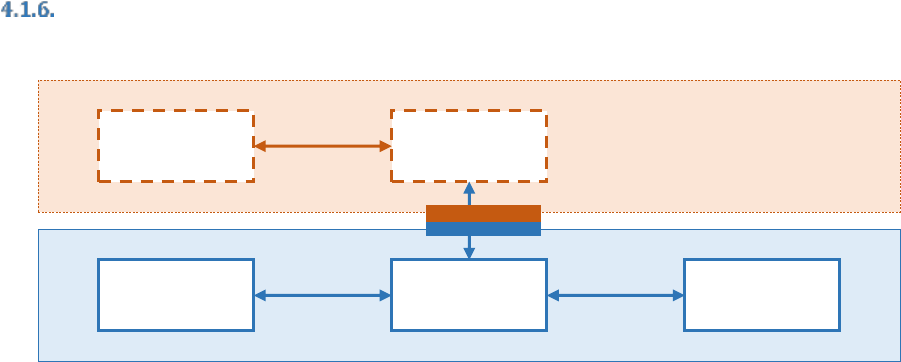
UNCLASSIFIED
58
UNCLASSIFIED
For NPEs, manual processes exist to issue credentials from the DoD NSS PKI. However, enterprise
registration and naming capabilities are lacking. Fully automated processes for NPEs are also lacking.
For Federal Agency partners, processes are in place to provision them with certificates from the NSS PKI.
Because the NSS PKI is a single infrastructure with a single Root CA, validation of certificates can be
performed, and all certificates contain a unique full distinguished name which can be used as a unique
identifier. However, the DoD does not have an enterprise ICAM service for registering non-DoD users.
Also, many DoD relying parties have chosen to use the EDIPI as the identifier, which results in a lack of
interoperability with non-DoD Federal Agency users as the EDIPI is only used within the DoD internal
community. Processes for sharing attributes beyond those asserted in NSS PKI certificates are also
lacking.
Secret Enterprise Registration for Non-Federal Agency Mission Partner Entities
Pattern:
Figure 37 – Secret Registration for Mission Partners
This pattern requires that person entities and NPEs are registered within their own network. Entities
may or may not be registered within the DoD Secret network.
The public keys for each IdP operated by each mission partner participating in the information exchange
are registered with the Mission Partner Gateway using an out-of-band mechanism such as manual in-
person transfer. These public keys are needed to be able to validate assertions provided by the IdPs. In
addition, each IdP asserts identifiers for users that it validates that are unique both within the mission
partner’s network and with the DoD network. Format of these identifiers must be defined as part of the
agreement established between the mission partner and the DoD for information exchange.
The gateway verifies the signature on the assertion, and then passes the information in the assertion
through the gateway so that it can be re-signed using a private key associated with a digital certificate
issued by the DoD NSS PKI or another DoD approved PKI on the DoD side of the gateway. For users who
only require access to resources that are authorized based on the country of origin attribute or other
attributes that are included in the assertion, no additional attributes are required.
Users who require access to resources that are authorized based on additional attribute information
hosted by the DoD must be registered using their identifier with the DoD Entity Data Repository.
Attributes may also be included in assertions from the Mission Partner IdP through Gateways and cross
domain devices, constrained by trust agreements. Additional attributes or entitlements can then be
provisioned to that user.
DoD IdP DoD NSS PKI
Mission Partner
CSP
Mission Partner
IdP
Entity Data
Repository
Gateway

UNCLASSIFIED
59
UNCLASSIFIED
Use Cases:
4.1.6(a) A DoD Combined Communication Electronics Board (CCEB) mission partner person entity or NPE
requires access to resources hosted on a DoD Secret network. The CCEB mission partner entity has been
identity proofed by the mission partner and has been issued a credential that is valid on the mission
partner’s Secret network. The mission partner network has connectivity to the DoD Secret network
through an approved Mission Partner Gateway.
4.1.6(b) An IC mission partner person entity or NPE requires access to resources hosted on a DoD Secret
network. The IC mission partner entity has been identity proofed and issued a credential on the JWICS
network. JWICS has connectivity to the DoD Secret network through an approved Cross Domain Solution
(CDS) gateway.
4.1.6(c) A Combatant Command mission partner person entity or NPE requires access to resources
hosted on a Combatant Command mission partner Secret Releasable network. The Combatant
Command mission partner entity has been identity proofed and issued a credential on their national
Secret Releasable mission partner network. The mission partner national Secret Releasable network has
connectivity to the Combatant Command Secret Releasable network through an approved Mission
Partner Gateway.
Gaps:
Currently, the DoD does not provide an enterprise ICAM capability for an IdP. Some mission partners
have implemented IdPs, but others do not support this capability.
Gateway functionality is also limited and may not support the verification of assertions, recreation of
the assertion, or digital signing of the recreated assertion.
Because many relying party information systems are not configured to securely process authentication
assertions in lieu of performing direct credential validation, ICAM services have been deployed that
create a new PKI digital certificate for the mission partner entity that can be presented to the relying
party. Migrating to assertion based authentication can eliminate the need for operating CAs at the
boundary while still maintaining attribution of who requested the resource and supporting the need to
inspect information as it crosses the boundary.
Short-Lived NPE Registration
Pattern:
Figure 38 – Cloud Elasticity Registration
Generally, registration of an entity occurs where there is a need for a long-term recognition of that
entity. This pattern is for when one or more short lived entities need to be credentialed in a short period
of time and then only exist for a limited time period. The pattern depicted here takes place after the
requirements in section 3.1.1.2 have been met.
CSP
Requesting
Service

UNCLASSIFIED
60
UNCLASSIFIED
A requesting service generates key pairs and certificate requests and submits the requests to the CSP.
The CSP issues certificates and returns them to the requesting service in a fully automated fashion with
little to no time delay. The requesting service then deploys the private keys and certificates to the new
short-lived entities for use. When the new entities reach end of life, the requesting service notifies the
CSP to revoke the credentials. The CSP can also limit the validity period of the certificates to reduce CRL
size. The requesting service must submit a new request prior to the expiration date of the current
certificates.
Use Cases:
4.1.7(a) A cloud based application needs to stand up 10,000 instances to process data in response to a
real-world event. Each instance requires 5 PKI key-pairs including signed certificates. After 3 days of
operations, the processing is complete, these instances are all decommissioned.
4.1.7(b) An information system needs to stand up an automated process to perform a specific function
on its behalf. Once the function is complete, the automated process is decommissioned.
Gaps:
The interface to the DoD Issuing Certification Authority for securely connecting to and for automating
the submission and retrieval of certificate signing requests does not currently exist.
For the use of "Only Locally Trusted (OLT)" solutions that may be used for certificates that are only used
internally (e.g., behind a load balancer), the Azure Application Service Certificates and Azure Key Vault
capabilities do not currently have DoD Provisional Authorizations and are not currently approved as
required by DoD Instruction 8520.02.
Processes and capabilities for short lived NPEs do not exist, including identity vetting/provenance,
issuance and validation of short term credentials, and provisioning entitlements.
DoD Beneficiary Registration
Pattern:
Figure 39 – DoD Beneficiary Registration
These use cases all require the issuance of non-PKI credentials to beneficiaries. Beneficiary identity is
managed by the PDR, and beneficiaries are assigned an EDIPI. Beneficiaries may be issued a credential
by DS Logon that contains their EDIPI, or they may use a commercially issued credential that must be
registered to connect it to their beneficiary identity. Accessing information on behalf of another user
also requires that the relationship be managed, either at the time of initial identity on-boarding (e.g., for
a dependent), or through a formal process where the beneficiary delegates authorization to another
individual.
Use Cases:
4.1.8(a) A DoD retiree desires to interact electronically with the DoD to manage their own health or
other benefits.
DS Logon
Person Data
Repository

UNCLASSIFIED
61
UNCLASSIFIED
4.1.8(b) A DoD military service member desires to interact electronically with the DoD using their
personally owned device to manage health benefits or review their own financial information.
4.1.8(c) An individual desires to interact electronically with the DoD to manage health, financial, or other
beneficiary information on behalf of a DoD beneficiary. The beneficiary is either a dependent of the
individual or has specifically authorized the individual to act on their behalf.
4.1.8(d) A DoD beneficiary desires to interact electronically with the DoD related to low sensitivity non-
Protected Health Information (PHI) such as scheduling an appointment at a DoD owned recreational
facility.
Gaps:
Registering and managing beneficiary information through the PDR is a mature set of processes. DS
Logon supports the issuance of password based credentials that are linked to the EDIPI. Migration to an
MFA credential is in process.
Registering externally issued and managed credentials to a specific beneficiary is not supported today.
Registering a relationship to allow an individual to act on behalf of a beneficiary is not generally
supported today, although beneficiaries may act on behalf of their dependent beneficiaries as a result of
the dependency relationship.
DoD Applicant Registration
Pattern:
Figure 40 – Applicant Registration
These use cases require the registration of users to support consistent interaction with that user, but it
may not be possible or desirable to collect and verify identity attributes. As a result, participants register
and self-assert required attributes and are provided with a local identifier.
At the conclusion of a limited duration event, or if an applicant or recruit is not hired, all information,
including identifiers, is archived as required by data retention policies and removed from active systems.
If an applicant is hired or a recruit joins the military service, then information about that user is verified
and used in registering the user as a member of the DoD internal community (see section 4.1.1).
Use Cases:
4.1.9(a) An individual applies for a job with the DoD.
4.1.9(b) An individual is recruited for military service and is completing initial accession activities.
4.1.9(c) A DoD relying party needs to register users for a limited duration event that will only require
sharing low sensitivity non-PHI information such as registration for a conference or training class.
Local Data
Repository
External CSP
Local CSP

UNCLASSIFIED
62
UNCLASSIFIED
4.1.9(c) A tactical unit establishes a short term limited scope network that is not specifically NIPRNet or
SIPRNet and does not support the connectivity requirements needed for the pattern described in
Section 4.1.3.
Gaps:
These use cases are implemented locally when required. There are no DoD enterprise ICAM gaps.
4.2. Access Management Patterns
These use cases describe processes for accessing resources real time. Entities requesting access may be
registered in advance, or may be unanticipated. Depending on the access requirements and digital
policy rules for the resource being requested, unanticipated entities may be able to obtain access in
near real time, or may be required to complete registration steps prior to access being granted.
These use cases assume that the entity is able to present an appropriate credential that is DoD approved
for accessing the type of resource being requested and do not distinguish between credentials that are
issued by a DoD enterprise ICAM capability, a COI or local DoD ICAM capability, or a DoD mission
partner.
Access to DoD Managed Resources
Pattern:
The access pattern consists of three steps – authenticating the entity, determining if the entity is
authorized to access the resource, and providing access to the resource if the entity is authorized.
Authentication requires that the entity present a credential claiming a digital identity, verifying that the
credential was issued by a DoD approved credential provider, verifying that the credential is valid at the
time of the request, and determining the identifier associated with that credential. Entities may be
authenticated directly by the relying party information system that the entity is requesting access to, or
entities may be authenticated by an IdP that then forwards the entity’s identity information in a digitally
signed assertion, which must be validated by the information system, to ensure that the assertion
originates from a trusted source and that the contents of the assertion have not been modified.
Identifiers may be present within the credential, or the credential may be registered with an entity data
repository that maps the credential to an identifier. Entities that have not been provisioned to the
specific relying party information system may already be registered with an entity data repository, or
may be registered and linked to an identifier at the time of access request.
Authorization requires determining what the access policy rule is for the resource being requested,
either through resource labeling and linking to a resource policy rule store, or locally through identifying
entitlements such as group membership that are necessary for access to the resource. Once the policy
rule has been identified, the relying party must determine if necessary attribute values are available
about the resource and the entity to determine if access can be granted. If the entity is provisioned with
entitlements to access the resource, no further action is necessary. If the entity is not provisioned, the
relying party may seek to perform dynamic provisioning through attributes available in the credential,
provided in an authentication assertion, or linked to the entity’s identifier using one or more attribute
services. If dynamic provisioning is not available, or if required attribute information cannot be
obtained, the entity cannot be granted access to the resource.
If the entity is authorized, then access to the resource is granted. Otherwise, access is not granted. The
relying party may provide information to the user regarding what steps will be needed to obtain access.

UNCLASSIFIED
63
UNCLASSIFIED
Use Cases:
4.2.1(a) An entity who has been registered and provisioned requests access to a DoD resource hosted by
a DoD managed information system.
4.2.1(b) An entity who has not been provisioned requests access to a DoD resource hosted by a DoD
managed information system that requires user registration.
Gaps:
The registration gap for mission partner entities after authenticating is the inability to link to the
attributes needed for access. As a result, mission partner entities are unable to access many resources
that they should be authorized for.
The DoD does not have an enterprise IdP service that accommodates DoD internal and mission partner
entities.
DoD relying party information systems lack the ability to process assertions in lieu of direct
authentication, limiting their ability to consume capabilities from DoD enterprise ICAM services.
The DoD has only limited enterprise services for attribute services. While some Components and COIs
maintain attribute values for a limited population, the lack of availability of authorization attributes
limits the implementation of dynamic provisioning and ABAC. Also, both attributes and their allowed
value lists are not normalized across the Components, making ABAC decisions difficult to consistently
evaluate.
DoD does not have an enterprise entitlement provisioning service. As a result, provisioning entitlements
must be done for systems through COI portals or locally. These manual provisioning processes require
significant processing time, delaying access to required resources.
Resource labeling is only performed by limited COIs, and the development and implementation of digital
policy rules for access to resources is even more limited. The lack of defined digital policy rules is a
primary deterrent to the expanded implementation of dynamic access.
Enterprise standards and policies for NPEs are lacking, resulting in limited ability for NPEs to access
resources.
Enterprise standards, policies and ICAM services for NPEs are lacking, resulting in limited ability for NPEs
to access resources.
Access for Unanticipated Entities
Pattern:
Access to many resources, especially information resources, should be supported through dynamic
access which does not require registration of entities but instead allows a real-time access decision to be
made at the time of the request based on information which can be made available the resource or PDP
making the access control decision.
This access pattern still requires the three steps of authenticating the entity, determining if the entity is
authorized to access the resource, and providing access to the resource if the entity is authorized.
Authentication may be performed by a DoD information system, DoD IdP, or approved external IdP, and
requires that the entity present a credential claiming a digital identity, verifying that the credential was
UNCLASSIFIED
64
UNCLASSIFIED
issued by a DoD approved credential provider, verifying that the credential is valid at the time of the
request, and determining the identifier associated with that credential. For unregistered entities who
are authenticated by an external IdP, a DoD identifier may not be established or needed. Instead, the
identifier will consist of the IdP’s own identity combined with the identifier used by the IdP for that
entity such as a full distinguished name from a PKI certificate.
Authorization requires determining what the access policy rule is for the resource being requested,
through resource labeling and linking to a resource policy rule store. Once the policy rule has been
identified, the relying party must determine if sufficient attributes are available about the entity to grant
access. The entity is not required to be registered or provisioned. Instead, the relying party uses
attributes available in the credential, provided in an authentication assertion, or linked to the entity’s
identifier using one or more attribute services. If required attribute information cannot be obtained, the
entity cannot be granted access to the resource.
If the entity is authorized, then access to the resource is granted. Otherwise, access is not granted. The
relying party may provide information to the entity regarding what steps will be needed to obtain
access.
Use Cases:
4.2.2(a) An entity requests access to a DoD resource that is managed through a fully ABAC model that
does not provision entities.
4.2.2(b) An entity requests access to a DoD resource that does not provision users and all attributes
required for satisfying the digital policy rule for access to that resource are included in the entity’s
credential or the assertion presented to the information system hosting the resource.
4.2.2(c) A person entity or NPE supporting a member of a coalition requests access to a resource where
access is limited by member nation, not by individual entity.
4.2.2(d) An NPE is created in response to a user request which then requests access to a resource on
behalf of the originating user. The NPE is provided with an assertion that includes the identity of the NPE
that created it and the identity of the user making the request (the user may be a person entity or NPE).
Access decisions by relying parties should be made taking into account both the requesting NPE and the
rights of the requesting user.
4.2.2(e) An entity in a DDIL environment requests access to a resource that is in the same DDIL
environment. If attributes needed for satisfying the digital policy rule for access to that resource have
been cached in the environment, the entity is able to dynamically obtain access to the resource.
However, if required attributes have not been cached within the environment, the resource owner will
need to use a manual provisioning process for that user. Manual provisioning of required entitlements
may be temporary pending the opportunity to request and cache needed attributes for that user when
connectivity to attribute stores becomes available.
Gaps:
There is no DoD enterprise IdP service available. IdPs that have been implemented by Components or
COIs do not always support authentication of DoD mission partner entities.
Because there is no DoD enterprise service for registering mission partner entities, mapping attributes
to mission partner entities is lacking or only performed at a local level.

UNCLASSIFIED
65
UNCLASSIFIED
Relying party information systems are not generally configured to process assertions in lieu of
performing direct authentication. As a result, many of these systems do not support access by mission
partner entities because of the complexity of authenticating mission partner credentials.
Labeling resources and aligning them to digital policy rules for access is lacking across the DoDIN, with
some exceptions in coalition environments where resources are tagged with country releasability. The
lack of defined digital policy rules is a primary deterrent to the expanded implementation of dynamic
access.
Enterprise standards, policies and ICAM services for NPEs are lacking, resulting in limited ability for NPEs
to access resources.
Privileged User Access
Pattern:
The access pattern consists of three steps – authenticating the user, determining if the user is
authorized to access the resource, and providing access to the resource if the user is authorized. This
pattern is similar to the pattern described in Section 4.2.1. However, additional monitoring and
oversight should be implemented to address the additional risks presented by users with elevated
access rights, including:
Required use of separate credentials to perform privileged functions from those used for non-
privileged access
Workstation and network connectivity limitations for accessing privileged functions
Allow access to privileged user accounts only through Privileged Account Management (PAM)
tools that control access to privileged user accounts, monitor behavior, and log activity
PAM tools provide an enhanced capability for the discovery, management, and enforcement of business
rules that define which users can perform which actions against which resources.
Use Cases:
4.2.3(a) An IT privileged user requests access to a DoD resource to perform privileged functions.
4.2.3(b) A functional privileged user such as an approver requests access to a DoD resource to perform
privileged functions.
Gaps:
The DoD PKI supports the issuance of segregated credentials to privileged users. Minimum requirements
for specific types of privileged users are not defined across the DoD enterprise.
Capabilities for privileged user monitoring are currently implemented at the Component or COI level, no
enterprise services exist.
Although PAM tools currently in the market provide integrations with many market leading applications
and SaaS providers, there are many relying party information systems currently in use within the DoD
that are not supported by PAM tools.
Workflows within the relying party information systems must be configured to require dual-approval of
changes for privileged actions where appropriate. Not all relying parties support such configuration.

UNCLASSIFIED
66
UNCLASSIFIED
Workflows within functional management tools must be configured to require dual-approvals for
privileged actions where appropriate. This configuration is typically performed locally and is impractical
to automate at the enterprise level.
Individual accountability can be limited in tactical DDIL environments since many systems implement
group authentication without traceability back to enterprise defined identities.
Zero Trust
Pattern:
ICAM is a fundamental pillar of a Zero Trust (ZT) environment. As ZT becomes better defined within the
DoD, ICAM support for ZT will be critical. The access pattern in a ZT environment includes multiple steps:
User and end user device both authenticate to network
Network decision point dynamically provisions default connectivity based on identity, state, and
environmental conditions
User requests access to a resource
Access to the requested resource is evaluated; if the user and the user’s endpoint device are
granted access to that resource, the network dynamically provisions a connection for the
duration of that session
Access to the requested resource for the specific action is evaluated and the grant/deny
decision is enforced
At end of session, connection is de-provisioned
Everything is logged
Use Cases:
4.2.4(a) An entity requests access to a DoD resource that is managed in a ZT environment.
Gaps:
Prerequisite capabilities to enable enterprise-level ZT are not yet in place across the DoD, including:
Enterprise ICAM, including a robust set of user attributes and values for both person entities and
NPEs
Resource labeling with associated defined digital policy rules for access
Access policy management, decision, and enforcement points, with applications refactored to
externalize access decisions
Software Defined Networking to enable dynamic provisioning and de-provisioning of network
connections
Existing resources often rely upon access control decisions made elsewhere instead of each
resource performing an access control decision.
Access to Software as a Service (SaaS) Cloud Managed System
Pattern:
The access pattern consists of three steps: authenticating the user, determining if the user is authorized
to access the resource, and providing access to the resource if the user is authorized. This pattern is
similar to the pattern described in Section 4.2.1. However, there are differences in the way that
Software as a Service (SaaS) vendors support authentication and authorization.
UNCLASSIFIED
67
UNCLASSIFIED
For authentication, while some SaaS vendors support direct PKI based authentication, most require the
presentation of an assertion from an IdP.
For authorization, cloud SaaS providers generally follow one of these five processes.
The SaaS vendor requires pre-provisioning of all entity accounts and entitlements to its local
access control engine and performs authentication of the entity using credentials issued and
managed by the SaaS vendor (e.g., does not support federated authentication). The
authentication of the entity to the SaaS must be proxied by the DoD IdP. Entity accounts are
provisioned to the SaaS. The internal identifier and authentication factors (e.g., password) are
stored in the SaaS internal IdP, and in the DoD IdP with a mapping to the DoD entity identity.
When an entity requests access to the SaaS resource, the entity authenticates directly to the
DoD IdP, which then presents the identifier and authentication factors that the SaaS is expecting
on the entity’s behalf. This process does not support entities who have not been pre-registered
and provisioned.
The SaaS vendor requires pre-provisioning of all entity accounts and entitlements to its local
access control engine and supports authentication through presentation of assertions from an
external IdP. Authorized entities must be pre-provisioned to the SaaS vendor using the vendor
provided interface. Changes to access rights must be uploaded to the SaaS vendor when the
change is made. After the entity authenticates to a DoD IdP, the IdP provides an assertion to the
SaaS vendor containing the user’s identifier. This process does not support entities who have
not been pre-registered and provisioned.
The SaaS vendor requires pre-provisioning of all entity accounts and inclusion of attributes
needed for authorization in the assertion. The use of assertions requires that the vendor and the
DoD IdP set up a trust agreement that defines the attributes to be used and the schema for the
attributes. Entity accounts must be managed through the interface provided by the SaaS vendor.
After the entity authenticates to a DoD IdP, the IdP determines appropriate attribute values and
includes them in an assertion to the SaaS vendor containing the user’s identifier. This process
does not support entities who have not been pre-registered, but does support entities whose
authorization attributes have changed.
The SaaS vendor does not pre-provision entity accounts but requires inclusion of identity and
attributes needed for authorization in the assertion. The use of assertions requires that the
vendor and the DoD IdP set up a trust agreement that defines the attributes to be used and the
schema for the attributes. After the entity authenticates to a DoD IdP, the IdP determines
appropriate attribute values and includes them in an assertion to the SaaS vendor containing
the entity’s identifier.
The SaaS vendor does not manage access. After the entity authenticates to a DoD IdP, the IdP
determines whether the entity is authorized, and only forwards a request to the SaaS vendor for
an authorized entity. this pattern requires the IdP to be:
o Provisioned with entitlements for the entity accessing the specific resource (or use a
service that provides them), or
o Obtain a policy for determining access to the resource from somewhere AND obtain
information about the resource from the SaaS (or an attribute service) to be able to use
the policy to make a decision.

UNCLASSIFIED
68
UNCLASSIFIED
Use Cases:
4.2.5(a) An entity who has been registered and provisioned requests access to a DoD resource hosted by
a cloud SaaS provider.
4.2.5(b) An entity who has not been provisioned requests access to a DoD resource hosted by a cloud
SaaS provider.
Gaps:
There is no DoD enterprise IdP service available. IdPs that have been implemented by Components or
COIs do not always support authentication of DoD mission partner entities.
Because there is no DoD enterprise service for registering mission partner entities, mapping attributes
to mission partner entities is lacking or only performed at a local level.
Most mission partners do not have IdPs implemented that can generate assertions, and DoD relying
parties are not configured to consume IdPs from external mission partners. These assertions could
potentially include attributes in addition to identity information that could support authorization
decisions.
Resource labeling is only performed by limited COIs, and the development and implementation of digital
policy rules for access to resources is even more limited. The lack of defined digital policy rules is a
primary deterrent to the expanded implementation of dynamic access. The lack of consistent up to date
data tagging is a larger issue than the perceived lack of digital policy.
The DoD has only limited enterprise services for attribute services. While some Components and COIs
maintain attribute values for a limited population, the lack of availability of authorization attributes
limits the implementation of dynamic provisioning and ABAC. Also, both attributes and their allowed
value lists are not normalized across the Components, making ABAC decisions difficult to consistently
evaluate
Enterprise standards, policies and ICAM services for NPEs are lacking, resulting in limited ability for NPEs
to access resources.
4.3. Access Accountability Patterns
Logging and Monitoring
Pattern:
The pattern for log collection is described in Section 3.2.1.
Use Cases:
4.3.1(a) A person entity is suspected of engaging in unauthorized behavior, and the investigator requires
information regarding all resources the user has accessed within the past six months.
4.3.1(b) A DoD Security Operations Center (SOC) or Cybersecurity Service Provider (CSSP) monitors
access behavior across the DoD enterprise and flags anomalous behavior for review by human analysts
to identify potential insider threats.
4.3.1(c) An NPE might be compromised and there is a need to analyze traffic and resource accesses
related to it.

UNCLASSIFIED
69
UNCLASSIFIED
4.3.1(d) Evidence exists that a DoD resource was leaked/compromised and investigation requires a list
of all person entities and NPEs who accessed it over a given timeframe.
Gaps:
Standards and processes for collecting and correlating ICAM related logs have not been deployed at the
DoD enterprise level.
Access Review
Pattern:
The patterns for access review is described in Section 3.2.2.
Use Cases:
4.3.2(a) The DoD financial audit requires a review of entitlements for users of in-scope financial
information systems to verify that users only have accesses they required to perform their job functions,
and that no user’s accesses violate separation of duty rules either within a single information system or
across multiple information systems.
4.3.2(b) A security auditor reviews access rights for IT privileged users to verify that users only have
accesses they require to perform their job functions, and that all required privileged user accounts are
managed through PAM tools.
4.3.2(c) A person entity with attributes that grant access to certain systems in the organization leaves
that organization. An individual with supervisory responsibilities reviews all attributes and provisioned
entitlements for that person entity and requests changes as warranted in line with the person entity’s
role change.
4.3.2(d) A system owner reviews access rights for all entities with provisioned entitlements on the
system to verify that entities only have those accesses need to perform their job functions.
4.3.2(e) A sponsoring organization reviews access rights for long-life NPEs to verify that the NPEs only
have accesses they require to perform their job functions.
4.3.2(f) An NPE is being decommissioned. The NPE sponsoring organization reviews all access rights for
the NPE and notifies any systems or services that the NPE is being decommissioned so that credentials,
attributes, and provisioned entitlements can be revoked or changed.
Gaps:
Consolidation of entitlement information is not available as a DoD enterprise ICAM capability, resulting
in a lack of ability to perform access reviews except at the relying party information system level.
DoD lacks the ability to review dynamic access.
Access reviews are not performed when person entity roles changed. Failure to accurately maintain
attribute values is a significant challenge/gap that will grow over time as more dynamic decisions are
implemented.
Access review should be performed for both person entities and NPEs. As more and more automation
occurs, NPEs can face the same problems as person entities, and are often reviewed even less
frequently.

UNCLASSIFIED
70
UNCLASSIFIED
Identity Resolution
Pattern:
The pattern for identity resolution is described in Section 3.2.3.
Use Cases:
4.3.3(a) DoD registers and issues locally valid credentials to community care providers and other first
responders within a DDIL network established in response to an emergency. When the local network
establishes connectivity with the DoDIN, the DoD must determine if any of the locally registered person
entities already have identifiers issued by the PDR.
4.3.3(b) Department of Homeland Security (DHS) registers and issues PIV cards to its employees. DHS
engages with DoD on a joint short term activity and provides identity information about users who will
be participating in the activity to the DoD COI. The DoD and DHS later decide that the activity will
continue indefinitely and the COI decides to upload the registered DHS users to the DoD enterprise PDR.
DoD must determine if any of the DHS managed users also have existing DoD identifiers, such as former
DoD dependents, contractors supporting both DoD and DHS, or DoD reservists who are employees of
DHS.
4.3.3(c) An individual who has been banned from DoD networks as a result of engaging in unauthorized
activity gets a job working for a DIB mission partner.
4.3.3(d) A local identity is established and a credential is issued to a person entity on a closed restricted
network that is derived from presentation of an enterprise credential such as a CAC. Because the closed
restricted network may be connected to the DoD enterprise at a later date, the local identity records the
enterprise identifier to support identity resolution.
Gaps:
Identity resolution is performed for DoD internal community members both at the time of initial
registration and periodically. However, identity resolution capabilities for mission partner entities is not
generally performed.
Local identities are often established without ever attempting to link the identities to DoD identities.
Even if a DoD-wide authenticator is checked at the time of registration (e.g., vet a person’s identity using
a CAC), the local system uses a different way of identifying the person (e.g., first initial, last name for the
user name); creating a new digital identity without linking it to the existing DoD enterprise identity.
4.4. Contact Data Lookup
Pattern:
The pattern for contact data lookup is described in Section 3.3.
Use Cases:
4.4(a) A DoD internal community member needs to identify the email address of another DoD internal
community member.
4.4(b) A coalition member needs to identify the email address of another coalition member.
4.4(c) A DoD internal community member needs to identify the email address of a Federal Agency
mission partner person entity.
UNCLASSIFIED
71
UNCLASSIFIED
4.4(d) An NPE needs to look up contact data for a person entity in order to send an alert.
4.4(e) A management NPE needs to discover all of the NPEs it has oversight of so it can send out an
update or get status (e.g., managing all of the radios in the network).
Gaps:
Contact data lookup for DoD internal person entities is supported through the Enterprise Directory
Service (EDS). Contact data collection and lookup for NPEs and mission partner entities is limited.
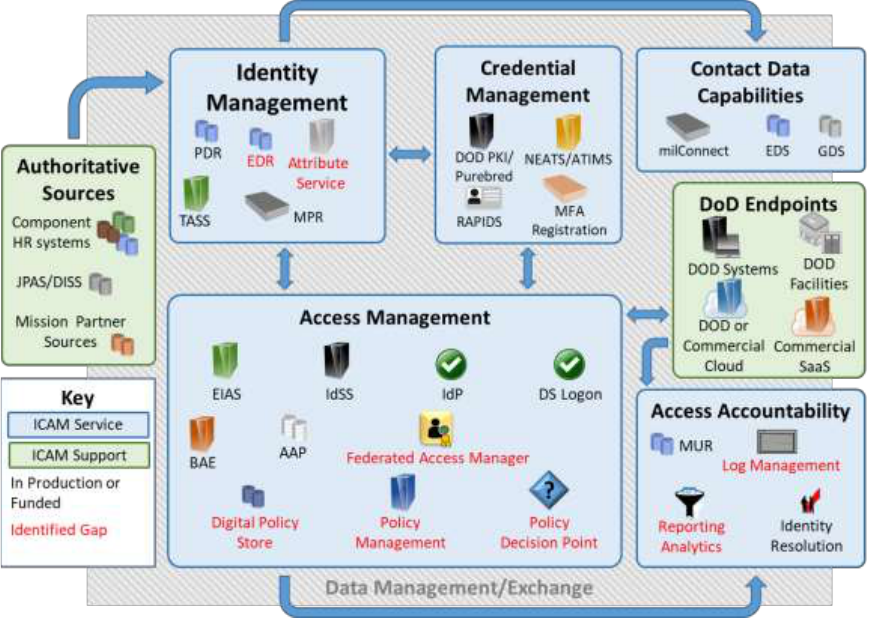
UNCLASSIFIED
72
UNCLASSIFIED
5. DoD Enterprise ICAM Services
This section identifies and describes existing and planned DoD Enterprise ICAM services. The context of
the collection of ICAM services is shown in Figure 41. These services are organized according to the
capabilities that were identified in Section 2 that they implement. The broad interface categories and
data flows are also depicted, wherein data from authoritative sources are used within the ICAM
processes to enable access decisions and to enable a robust audit trail. Initial gap analysis has identified
several ICAM services that do not currently exist and are not currently planned. Authoritative sources
are intended to be representational and do not represent all possible source systems.
Figure 41 – ICAM Service View (SvcV-1)
Some DoD enterprise ICAM services, especially identity management and access accountability services,
are dependent on receiving accurate and timely information from DoD Component or COI level ICAM
services. DoD Components must coordinate with DoD enterprise ICAM service providers to ensure
common standards and interoperability between enterprise and DoD Component and COI level ICAM
services.
5.1. DoD ICAM Enterprise Services Summary
Table 4 provides a summary of DoD ICAM Enterprise Services that are either in production today or are
planned and budgeted. Each service is described in this section, including what the service does, who
operates it, what entities the service supports, and what the service interfaces with. The Capabilities
column aligns with the capability taxonomy in Section 2.2, Figure 3. For more detailed information about
availability, capabilities, and interfaces, relying parties can contact their customer service representative
at the service provider listed, either the Defense Information Systems Agency (DISA) or DMDC.

UNCLASSIFIED
73
UNCLASSIFIED
Table 4 – ICAM Enterprise Services
Service
Provider
Status
Network
Capabilities
Identity Management
Person Data Repository
(PDR)
DMDC
Production
NIPRNet
SIPRNet
Person Entity
Trusted Associate
Sponsorship System (TASS)
DMDC
Production
NIPRNet
Person Entity
Mission Partner Registration
(MPR)
DMDC
Planned
NIPRNet
Federated Entity
Multi-Factor Authentication
(MFA) Registration Service
DMDC
Planned
NIPRNet
Federated Entity
Credential Management
DoD Public Key
Infrastructure (PKI)
DISA
Production
NIPRNet
SIPRNet
Internal Credential
Management
Real-Time Automated
Personnel Identification
System (RAPIDS)
DMDC
Production
NIPRNet
Internal Credential
Management
NIPRNet Enterprise
Alternate Token System
(NEATS) / Alternate Token
Issuance and Management
System (ATIMS)
DMDC
Production
NIPRNet
Internal Credential
Management
Purebred
DISA
Production
NIPRNet
Internal Credential
Management
MPR
DMDC
Planned
NIPRNet
External Credential
Registration
MFA Registration Service
DMDC
Planned
NIPRNet
External Credential
Registration
DoD Self-service (DS) Logon
DMDC
Production
NIPRNet
Internal Credential
Management
DS Logon (Enhanced)
DMDC
Planned
NIPRNet
Internal Credential
Management
Identity Provider (IdP)
DISA
Planned
NIPRNet
Internal Credential
Management
External Credential
Registration
Access Management
Enterprise Identity Attribute
Service (EIAS)
DMDC
Production
NIPRNet
SIPRNet
Authorization
EIAS (Enhanced)
DMDC
Planned
NIPRNet
Authorization

UNCLASSIFIED
74
UNCLASSIFIED
Service
Provider
Status
Network
Capabilities
SIPRNet
Backend Attribute Exchange
(BAE)
DMDC
Planned
NIPRNet
Authorization
Identity Synchronization
Service (IdSS)
DISA
Production
NIPRNet
SIPRNet
Authentication
Authorization
Enterprise Directory
Services (EDS)
DISA /
DMDC
Production
NIPRNet
Authentication
IdP
DISA
Planned
NIPRNet
Authentication
Authorization
MFA Registration Service
DMDC
Planned
NIPRNet
Authentication
MPR
DMDC
Planned
NIPRNet
Authorization
Automated Account
Provisioning (AAP)
DISA
Planned
NIPRNet
Provisioning
DS Logon
DMDC
Production
NIPRNet
Authentication
Authorization
Access Accountability
Master User Record (MUR)
DISA
Planned
NIPRNet
Access Review
Identity Resolution Service
DMDC
Production
NIPRNet
Identity Resolution
Contact Data
EDS
DISA /
DMDC
Production
NIPRNet
Contact Data Lookup
milConnect
DMDC
Production
NIPRNet
Contact Data Collection
IdSS
DISA
Production
NIPRNet
Contact Data Collection
Global Directory Service
(GDS)
DISA
Production
NIPRNet
SIPRNet
Contact Data Lookup
5.2. Production DoD ICAM Enterprise Services
This section provides a high level description of DoD ICAM enterprise services that are currently in
production. Descriptions include a high level purpose statement for the service, who operates the
service, what interfaces the service supports, and which data flows the service provides.
Person Data Repository (PDR)
The Person Data Repository (PDR), operated by DMDC, is the DoD human resource authoritative source
for person, personnel, and identity attributes. The PDR supports DoD internal community and
beneficiary members. The PDR provides DoD person entity Data Management capabilities including:
Extract, Transform, and Load (ETL) and data attribute normalization. The PDR operates on both NIPRNet
and SIPRNet.

UNCLASSIFIED
75
UNCLASSIFIED
The PDR aggregates information provided by DoD component human resource databases and TASS as
well as data regarding CACs from RAPIDS, and provides information to EIAS.
The PDR is an identity management service. It provides digital identity creation, maintenance, and
deactivation for person entities that are part of the DoD internal community and beneficiaries.
Identity Resolution Service
The Identity Resolution Service, operated by DMDC, is performed on the PDR on a daily basis to verify
that there are no duplicate digital identities for a single person entity. The identity resolution service
supports DoD internal community and beneficiary members. The identity resolution service operates on
the NIPRNet.
The Identity Resolution Service operates in support of the PDR.
The Identity Resolution Service provides identity resolution as part of access accountability.
Trusted Associate Sponsorship System (TASS)
Trusted Associate Sponsorship System (TASS), operated by DMDC, is the authorized personnel source
for DoD contractors. TASS supports contractors who are being enrolled as part of the DoD internal
community. TASS operates on the NIPRNet.
TASS is the authoritative data source for contractor information. Once a contractor is enrolled in TASS,
their information is forwarded to the PDR.
TASS is an identity management service. It provides digital identity creation, maintenance, and
deactivation for contractors that are part of the DoD internal community.
DoD Public Key Infrastructure (PKI)
The DoD PKI, operated jointly by DISA and the NSA, is a framework established to issue, maintain, and
revoke public key certificates for person entities and NPEs. The DoD PKI operates on both NIPRNet and
SIPRNet.
The DoD PKI interfaces with certificate issuance systems including RAPIDS/CAC, NEATS, and Purebred, as
well as supporting manual requests from Registration Authorities and other authorized users for
certificate issuance and revocation. The DoD PKI publishes CRL and provides real-time responses to
requests for certificate validation to any user. The DoD PKI also supports interoperability with DoD
External Certificate Authorities (ECA), other Federal Agency PKIs, selected commercial PKIs, and selected
CCEB PKIs as approved by the DoD CIO.
The DoD PKI is a credential management service. It provides internal credential issuance, credential
maintenance, and credential revocation for entities that are part of the DoD internal community. It also
supports external federation through the issuance and maintenance of cross certificates to external
PKIs.
Real-Time Automated Personnel Identification System (RAPIDS)
Real-Time Automated Personnel Identification System (RAPIDS), operated by DMDC, provides the
capability for the DoD’s identity card issuance service that supports credential lifecycle management,
including Common Access Cards (CAC) used for physical and logical access and other physical DoD
identity cards that are used for physical access only. RAPIDS supports DoD internal community members
and beneficiaries. RAPIDS operates on the NIPRNet.

UNCLASSIFIED
76
UNCLASSIFIED
RAPIDS interfaces with the PDR to obtain identity information used to generate CACs and DoD identity
cards and to verify that the person requesting the card has been authorized to obtain one. RAPIDS also
generates public/private key pairs and interfaces with the DoD PKI to request the issuance of PKI based
digital certificates. RAPIDS writes the key pairs and respective certificates onto CACs.
RAPIDS is a credential management service. It provides internal credential issuance, credential
maintenance, and credential revocation for entities that are part of the DoD internal community and
beneficiaries.
NIPRNet Enterprise Alternate Token System (NEATS) / Alternate Token Issuance and
Management System (ATIMS)
NIPRNet Enterprise Alternate Token System (NEATS) / Alternate Token Issuance and Management
System (ATIMS), operated by DMDC, supports the issuance of hardware PKI tokens to people who are
not eligible for CACs and to users who require an additional hardware PKI token to support privileged
user, group and role, and code signing uses. NEATS/ATIMS operates on the NIPRNet.
NEATS/ATIMS interfaces with the PDR to obtain identity information. NEATS/ATIMS also interfaces with
the DoD PKI to request the issuance of PKI based digital certificates.
NEATS/ATIMS is a credential management service. It provides internal credential issuance, credential
maintenance, and credential revocation for entities that are part of the DoD internal community and
limited mission partner entities who are not part of the DoD internal community but who require DoD
PKI issued hardware credentials.
Purebred
Purebred, operated by DISA, supports the issuance of PKI based digital certificates to person entities and
NPEs for use with internal DoD user assigned mobile devices with hardware backed key stores or
security tokens. Purebred operates on the NIPRNet.
3
Purebred interfaces with the DoD PKI to request the issuance of PKI based digital certificates.
Purebred is a credential management service. It provides credential issuance, credential maintenance,
and credential revocation for entities that are part of the DoD internal community who have approved
mobile devices.
DoD Self-service (DS) Logon
DoD Self-service (DS) Logon, operated by DMDC, issues and manages credentials and associated
attributes for beneficiaries. DS Logon also supports access to information systems that provide self-
service information and information technology resources for DS Logon participants. DS Logon operates
on the NIPRNet.
DS Logon interfaces with the PDR for identity information. DS Logon also interfaces with information
systems to provide authentication assertions when users have authenticated to DS Logon.
DS Logon is a credential and access service. It provides internal credential issuance, credential
maintenance, and credential revocation for beneficiaries. It also acts as an identity provider to support
authentication.
3
More information regarding Purebred may be found at https://cyber.mil/pki-pke/purebred/.

UNCLASSIFIED
77
UNCLASSIFIED
Enterprise Identity Attribute Service (EIAS)
Enterprise Identity Attribute Service (EIAS), operated by DMDC, distributes DoD person, persona, and
personnel attributes to applications and services in a controlled, consistent, and secure manner. EIAS
operates on the NIPRNet and SIPRNet.
EIAS interfaces with the PDR to obtain attribute information. Because attributes supported by EIAS
contain PII, appropriate Privacy Impact Assessments (PIA) or System of Records Notices (SORN) must be
in place prior to providing identity and identity attribute information. EIAS interfaces with other DoD
enterprise ICAM services and DoD components to provide attribute information.
EIAS is an access management service. It is an attribute service that provides identity attribute
information about person entities that are part of the DoD internal community to support dynamic and
hybrid entitlement provisioning and authorization using dynamic access.
Identity Synchronization Service (IdSS)
Identity Synchronization Service (IdSS) controls all account creation, deletion, and updates into DISA’s
EASF and downstream directory system supporting DoD internal community members that require
access to DISA hosted DoD enterprise services. IdSS operates on the NIPRNet and SIPRNet.
IdSS interfaces with EIAS to obtain identity attribute and credential information and with GDS to obtain
email encryption certificates. IdSS also interfaces with DISA hosted information systems to provide
authentication assertions and other attributes as needed. IdSS can also provide authentication
assertions to cloud-based or DoD operated information systems.
IdSS is an access management service. It is an authentication service that acts as an identity provider to
support authentication, and it is an authorization service that provides identity attribute information
about person entities that are part of the DoD internal community to support dynamic and hybrid
entitlement provisioning and authorization using dynamic access.
milConnect
milConnect, operated by DMDC, allows DoD internal community members to access and update their
personal and personnel information. milConnect operates on the NIPRNet
4
.
milConnect interfaces with the PDR to update contact data attributes.
milConnect is a contact data service that supports contact data collection.
Enterprise Directory Services (EDS)
Enterprise Directory Service (EDS), jointly operated by DISA and DMDC, is a suite of services that provide
authoritative DoD enterprise identity and contact attributes. EDS operates on the NIPRNet. EDS includes
the following services:
Real-time Broker Service (RBS), operated by DMDC, synchronous web service that provides DoD
identity and contact data
Batch Broker Service (BBS), operated by DMDC, asynchronous web service that provides DoD
identity and contact data
IDSS Machine Interface (IDMI), operated by DISA, supports local directory provisioning and
updating by providing DoD identity and contact data
4
milConnect is scheduled to be fully decommissioned by the end of fiscal year 2021.

UNCLASSIFIED
78
UNCLASSIFIED
Enterprise Directory Query Service (EDQS), operated by DISA, provides a Lightweight Directory
Access Protocol LDAP interface to query IdSS data
EDS interfaces with PDR and IdSS to obtain identity and contact data information. EDS interfaces with
component directories to provide identity and contact data information.
EDS is an access management service. It is an attribute service that provides identity attribute
information about person entities that are part of the DoD internal community to support dynamic and
hybrid entitlement provisioning and authorization using dynamic access. EDS is also a contact data
collection service that provides contact data to local directories.
Global Directory Service (GDS)
Global Directory Service (GDS), operated by DISA, is a directory service that supports the DoD PKI
program. GDS is the distribution point for DoD PKI CA certificates, CRLs, and email encryption
certificates. GDS operates on NIPRNet and SIPRNet.
GDS interfaces with the DoD PKI to obtain certificate information. GDS also provides a search capability
for users to obtain email addresses and email encryption certificates for DoD internal community
members.
GDS is a contact data lookup service for email addresses and email encryption certificates.
5.3. Planned DoD ICAM Enterprise Services
This section provides a high level description of DoD ICAM enterprise services that are in the planning or
development stage. Descriptions include a high level purpose statement for the service, who operates
the service, what interfaces the service supports, and which data flows the service provides.
Implementation timelines for planned services are in development, capabilities are expected to be
operational in fiscal year 2021.
Mission Partner Registration (MPR)
The Mission Partner Registration (MPR), in development by DMDC, will allow DoD government
personnel to sponsor DoD mission partner identities and register their identifiers so that identity can be
shared across the DoD ICAM architecture in a similar fashion to DoD personnel.
The MPR will interface with external mission partner identity and credentialing systems to obtain
identity attributes and register credentials. The MPR will also interface with information systems to
provide identifier and attribute information.
The MPR is an identity management service that supports creation, maintenance, and deactivation of
federated entity identities. It is also a credential management service that performs external credential
registration.
Identity Provider (IdP)
The Identity Provider (IdP), in development by DISA, will be a centralized authentication service for
applications for both DoD issued and mission partner credentials, including username and password
management, MFA credential authentication enablement and management, PKI certificate validation,
and a token provider.
The IdP will interface with PDR and MPR to obtain identity attribute information for DoD internal
community members and registered mission partner entities. The IdP will also interface with external

UNCLASSIFIED
79
UNCLASSIFIED
approved IdPs and credential service providers to validate mission partner credentials and assertions.
The IdP will provide assertions to DoD information systems once users have been authenticated.
The IdP is an access management service. It is an authentication service that acts as an identity provider
to support authentication.
Multi-Factor Authentication (MFA) Registration Service
The Multi-Factor Authentication (MFA) Registration Service, in development by DMDC, will aggregate
and combine DoD issued credentials for DoD internal community members and external credentials for
mission partner entities into a single repository that supports the IdP for user authentication. The MFA
Registration Service will register approved external credentials, perform validation of external
credentials, and connect mission partner entities to other identity attributes to support use for DoD
information system relying parties.
The MFA Registration Service will interface with the PDR and the MPR to obtain identity information,
and with external credential service providers to validate mission partner credentials. It will also
interface with the IdP to validate external credentials and provide identity information.
The MFA Registration Service is an identity management service that supports creation, maintenance,
and deactivation of federated entity identities. It is also a credential management service that performs
external credential registration. It is also an access management service that supports authentication as
well as authorization by providing identity attribute information.
EIAS (Enhanced)
See Section 5.2.9 for a description of EIAS. Planned enhancements to EIAS include implementing
processes to enhance data quality for attributes provided, and to modernize standards supported in
providing attribute information to information systems.
Backend Attribute Exchange (BAE)
Backend Attribute Exchange (BAE), in development by DMDC, will allow DoD to exchange identity and
credential information about person entities seeking access or transferring from one agency to another
with other participating Federal Agency mission partners.
BAE will interface with the PDR and MPR to maintain information about registered Federal Agency
mission partner entities. BAE will also interface with Federal Agency mission partner identity and
credential management systems to obtain this information.
BAE is an access management system. It is an attribute service that provides identity attribute
information about Federal Agency mission partner person entities to support dynamic and hybrid
entitlement provisioning and authorization using dynamic access.
DS Logon (Enhanced)
See section 5.2.8 for a description of DS Logon. Planned enhancements to DS Logon include modernizing
the architecture, support for MFA credentials, and support for federated credentials.
Automated Account Provisioning (AAP)
Automated Account Provisioning (AAP), in development by DISA, will provide identity governance
services such as user entitlement management, business role auditing and enforcement, and account

UNCLASSIFIED
80
UNCLASSIFIED
provisioning and de-provisioning based on identity data produced during DoD people-centric activities
such as on and off-boarding, continuous vetting, talent management, and readiness training.
AAP will interface with the PDR, EIAS, and other attribute services to obtain attribute information to
support automated provisioning. AAP will also interface with information systems to provision and de-
provision entitlements.
AAP is an access management system. It supports manual, dynamic, and hybrid entitlement provisioning
and de-provisioning.
Master User Record (MUR)
Master User Record (MUR), in development by DISA, will enable DoD-wide knowledge, audit, and data
rollup reporting of who has access to what system or applications. MUR will support identification of
insider and external threats, and will enable financial management segregation of duties auditability
across DoD Component organizations.
MUR will interface with the PDR, as well as DoD Component ICAM services and information systems to
collect and correlate attribute and entitlement information for person entities that have access to DoD
resources.
MUR is an access accountability system that supports access review.

UNCLASSIFIED
81
UNCLASSIFIED
6. ICAM Implementation Responsibilities
This section highlights responsibilities for implementing the ICAM program across the DoD.
Responsibilities are divided between DoD enterprise ICAM service providers and DoD Components who
consume DoD enterprise ICAM services and operate COI and local ICAM services. This section also
identifies responsibilities related to accepting services provided by external federated ICAM service
providers. These roles and responsibilities are aligned with ICAM policy defined in OMB Memo M-19-17.
6.1. DoD ICAM Joint Program Integration Office (JPIO) Responsibilities
The JPIO provides integration responsibility for the DoD ICAM enterprise capabilities. The JPIO is led by
DISA, and NSA and DMDC both provide a Senior Executive-level individual to serve as deputy leads and
to coordinate their agencies' ICAM efforts. The DoD ICAM JPIO develops and maintains an
implementation plan for DoD enterprise ICAM services.
6.2. DoD Enterprise ICAM Service Provider Responsibilities
DoD enterprise ICAM service providers provide one or more services that support ICAM capabilities. A
service is defined as DoD enterprise if it can be used by anyone across the DoD, and, for externally facing
federation services, by any DoD mission partner. DoD enterprise ICAM services may be hosted by DISA
or DMDC, or may be hosted by another DoD Component. DoD enterprise ICAM service providers must:
Provide DoD enterprise ICAM services meeting defined availability targets
Support cybersecurity and interoperability testing of DoD enterprise ICAM services
Develop and publish interface specifications describing the capabilities provided by the
enterprise service, the entities the service provides information for, and the interfaces the
service supports
Implement a process for collecting and prioritizing requirements for functionality enhancements
to the service
Monitor and identify enhancements needed to ensure resilience and adaptability to changes in
the threat environment
6.3. DoD Component Responsibilities
DoD Components rely on ICAM services to perform their missions. DoD Components support DoD
enterprise ICAM services such as providing verified identity and attribute data and providing trained
personnel to verify identity and issue credentials. Where ICAM enterprise services do not meet the
needs of Component use cases, Components are also responsible for operating COI and local ICAM
services that comply with DoD enterprise technical and process standards.
Establish DoD Component Level ICAM Governance
DoD Components must establish DoD Component level governance to implement ICAM, to include:
Developing and maintaining DoD Component level ICAM policies and procedures
Maintaining visibility into DoD Component level budgets for ICAM capabilities

UNCLASSIFIED
82
UNCLASSIFIED
Identifying DoD Component level organizations responsible for coordinating and providing ICAM
services and executing organizational structures for effective ICAM service coordination and
implementation
Support DoD Enterprise ICAM Services
DoD Components must support DoD enterprise ICAM services, to include:
Identifying requirements for enterprise ICAM services to support DoD Component ICAM
implementation and provide requirements to the JPIO
Defining and implementing processes for the accurate collection and management of enterprise
attributes for DoD Component entities and provide this information to DoD enterprise attribute
services in a timely fashion
Performing identity proofing and suitability determination for the issuance of DoD enterprise
credentials
Coordinating with enterprise ICAM service providers to ensure common standards and
interoperability between enterprise and DoD Component and COI level ICAM services.
Use DoD Enterprise ICAM Services
DoD Components must implement ICAM for DoD Component employees, contractors, mission partner
entities, information systems, and resources to include:
Leveraging DoD enterprise ICAM services where available and appropriate for the mission
Supporting interoperability testing of DoD enterprise ICAM services
Using standards-based interfaces to perform ICAM activities including the acceptance of
authentication assertions. Where legacy information systems do not support ICAM standards,
implement proxies to support ICAM standards where operationally feasible
Leveraging DoD enterprise ICAM services where available to support ICAM for NPEs, including
naming, identity management, credentialing, and provisioning
Developing and implementing policy rules for access to resources. Where appropriate, publish
resource policy rules to DoD enterprise policy stores
Aligning resources to policy rules through data tagging or within information systems that host
the resources
Performing authentication and authorization to access all DoD Component managed resources,
including physical and logical access, unless the resource has been approved for public release
Logging ICAM events and make ICAM logs available to DoD enterprise log collection services
Operate COI and Local ICAM Services
Although DoD Components are encouraged to use DoD enterprise ICAM services, there may be
circumstances where enterprise services are not available or do not meet the needs of the mission. For
example, a coalition network may have only minimal or no connectivity to the NIPRNet and must
register and provide credentials to local nationals who require access to resources on the coalition
network. When operating COI or local ICAM services, DoD Components must:
UNCLASSIFIED
83
UNCLASSIFIED
Ensure that the ICAM services use standards-based interfaces and are operated in accordance
with DoD policy
Address the full lifecycle of the ICAM service. For example, if the DoD Component is operating a
CSP, the DoD Component must address all aspects of credential issuance, including identity
proofing, credential management, credential validation, and credential revocation
6.4. Responsibilities Related to External Federated ICAM Service Providers
DoD relying parties may use ICAM services providers that are owned and operated externally to the
DoD. Examples of these external service providers include:
Federal agencies that issue PIV cards to their employees and contractors and manage identity
and other attributes about these people
Commercial and non-US mission partners that issue PKI certificate based credentials to their
users
External IdPs that authenticate external credentials including PKI certificate based, MFA based,
and username/password based and generate assertions that are passed to the DoD
Cloud-based SaaS vendors who consume assertions from DoD IdPs and manage authentication
and authorization decisions inside the cloud
Prior to relying on external providers, DoD must ensure the following:
The service provider has been approved.
o For enterprise ICAM service providers, the DoD CIO manages the approval
o For component, COI, and local external service providers, approval may be managed by
the DoD CIO or by the component depending on the type of service being provided and
the overall risk to the DoD enterprise
o Approval may be implemented through a specific Memorandum of Approval, by
leveraging an existing agreement, or as part of a contractual arrangement with the
service provider
o Approval will generally be based on the service provider meeting an agreed upon set of
minimum standards – which may be verified by an independent testing capability or
self-asserted
The service provider uses standards-based interfaces that do not place an undue burden on DoD
relying parties to accept
The service provider’s own operations are performed using appropriate security measures
depending on the level of sensitivity of the DoD resources that will be accessed leveraging
capabilities from the service provider

UNCLASSIFIED
84
UNCLASSIFIED
7. Summary of ICAM Service Gaps
Table 5 provides a summary of identified ICAM capability gaps in currently available DoD ICAM
enterprise services.
Table 5 – Summary of DoD ICAM Enterprise Capability Gaps
Capability
Gaps
General Gaps
General
Processes for ensuring resiliency and dynamic adaptability are not
defined.
General
Enterprise ICAM services are not available on the various Combatant Command
and MPCO-managed Secret Releasable environments.
C1. Core ICAM Capabilities
C1.1. Identity Management
C1.1.1. Person
Entity
Processes to provision attributes and entitlements beyond core identity
attributes are decentralized and manual.
Attributes and values for commonly used attributes are not normalized
across the DoD enterprise.
The DoD has only limited enterprise services for attribute services.
Minimum requirements for specific types of privileged users are not
defined across the DoD Enterprise.
Managing attributes to support authorization at the scale needed is not
well supported for enterprise deployments of SaaS cloud solutions.
Capabilities and standards for managing identities across classification
domains are not well defined.
C1.1.2. Non-
Person Entity
Enterprise registration and naming capabilities for NPEs are lacking.
Enterprise attributes for NPEs are not defined or normalized across the
DoD enterprise.
No plans to develop an Enterprise Data Repository that can manage
person entities and NPEs.
Identity vetting and provenance processes and capabilities do not exist
for short lived NPEs.
C1.1.3.
Federated
Entity
The DoD does not have an enterprise ICAM service for registering
mission partner entities.
Because there is no DoD enterprise service for registering mission
partner entities, mapping attributes to mission partner entities is lacking
or only performed at a local level.
C1.2. Credential Management
C1.2.1.
Internal
Credential
Management
Fully automated processes for issuing and managing credentials for NPEs
are lacking.
DS Logon does not support MFA credentials.

UNCLASSIFIED
85
UNCLASSIFIED
Capability
Gaps
Processes and capabilities for issuance and validation of short term
credentials for short lived NPEs do not exist.
C1.2.2.
External
Credential
Registration
DoD does not have an enterprise registration capability for mission
partner entities that have DoD approved external credentials.
DS Logon does not support registering externally issued and managed
credentials for beneficiaries.
C1.3. Access Management
C1.3.1.
Resource
Access
Management
Resource labeling is only performed by a limited number of COIs, and the
development and implementation of digital policy rules for access to
resources is even more limited.
The lack of defined digital policy rules is a primary deterrent to the
expanded implementation of dynamic access.
No plans to develop enterprise services for developing and managing
digital policies.
No plans to develop an enterprise digital policy store.
C1.3.2.
Provisioning
DoD does not have an enterprise service to support entitlement
provisioning and de-provisioning.
Manual provisioning and de-provisioning processes require significant
processing time, delaying access to required resources.
DoD lacks a consistent standards-based approach for provisioning and
de-provisioning entities to SaaS information systems.
The lack of availability of authorization attributes limits the
implementation of dynamic provisioning.
Linking mission partner digital identities and attributes to their federated
credentials results in an inability for mission partner entities to access
many resources that they should be authorized for.
Software defined networking to enable dynamic provisioning and de-
provisioning of network connections to support ZT architectures is
lacking.
Processes and capabilities for provisioning entitlements for short lived
NPEs do not exist.
C1.3.3.
Authentication
DoD resources that require a DoD issued EDIPI as the unique identifier
for person entities are unable to authenticate mission partner entities
with externally issued credentials that do not have EDIPIs as their
identifiers.
DoD does not provide an enterprise IdP capability that accommodates
DoD internal and mission partners entities with approved external
credentials.
IdPs that have been implemented by Components or COIs do not always
support authentication of DoD mission partner entities.
Relying party information systems are not configured to accept and
process authentication assertions in lieu of performing direct credential

UNCLASSIFIED
86
UNCLASSIFIED
Capability
Gaps
validation, limiting their ability to consume capabilities from DoD
enterprise ICAM services and limiting the ability to authenticate mission
partner entities because of the complexity of authenticating mission
partner credentials.
Because many relying party information systems are not configured to
securely process authentication assertions in lieu of performing direct
credential validation, ICAM services have been deployed that create a
new PKI digital certificate for the mission partner entity that can be
presented to the relying party. Migrating to assertion based
authentication can eliminate the need for operating CAs at the boundary
while still maintaining attribution of who requested the resource and
supporting the need to inspect information as it crosses the boundary.
Enclave gateway and CDS functionality is limited and may not support
the verification of assertions, recreation of the assertion, and digital
signature of the recreated assertion.
Information systems currently in use across the DoD are not configured
to support PAM tools for IT privilege user authentication.
C1.3.4.
Authorization
Processes for sharing attributes beyond those asserted in credentials
certificates are lacking.
Enterprise standards and policies for NPEs are lacking, resulting in
limited ability for NPEs to access resources.
Access policy management, decision, and enforcement points are not
deployed as enterprise ICAM services.
Relying party information systems are not configured to externalize
access decisions.
The lack of availability of authorization attributes limits the
implementation of dynamic provisioning and ABAC.
Implementing dynamic access will require resource labeling, but the DoD
lacks an actionable strategy for implementing data tagging that fully
supports ICAM.
No plans to develop an enterprise PDP.
No plans to support federated access management for mission partner
entities.
Workflows within the relying party information systems must be
configured to require dual-approval of changes for privileged actions
where appropriate. Not all relying parties support such configuration.
Workflows within functional management tools must be configured to
require dual-approvals for privileged actions where appropriate. This
configuration is typically performed locally and is impractical to
automate at the enterprise level.
Most mission partners do not have IdPs implemented that can generate
assertions, and DoD relying parties are not configured to consume IdP
assertions from external mission partners. These assertions could

UNCLASSIFIED
87
UNCLASSIFIED
Capability
Gaps
potentially include attributes in addition to identity information that
could support authorization decisions.
Registering a relationship to allow an individual to act on behalf of a
beneficiary is not generally supported today, although beneficiaries may
act on behalf of their dependent beneficiaries as a result of the
dependency relationship.
C2. Access Accountability
C2.1. Log
Collection and
Consolidation
Standards and processes for collecting and correlating ICAM related logs
have not been deployed at the DoD enterprise level.
Capabilities for privileged user monitoring are currently implemented at
the Component or COI level, no enterprise services exist.
No plans to develop an enterprise service for log management,
collection, and consolidation service.
C2.2. Access
Review
Consolidation of entitlement information is not available as a DoD
enterprise ICAM capability, resulting in a lack of ability to perform access
reviews except at the relying party information system level.
No plans to develop an enterprise service to support reporting and
analysis.
Access reviews are not performed when person entity roles change.
Access reviews are not consistently performed for both person entities
and NPEs.
C2.3. Identity
Resolution
Identity resolution capabilities for mission partner entities are not
implemented at the DoD enterprise level.
Local identities are not linked to existing DoD identities.
Individual accountability can be limited in tactical DDIL environments
since many systems implement group authentication without traceability
back to enterprise managed identities.
C3. Contact Data
C3.1. Contact Data
Collection
Contact data collection for NPEs and mission partner entities is limited.
C3.2. Contact Data
Lookup
Contact data lookup for NPEs and mission partner entities is limited.

UNCLASSIFIED
88
UNCLASSIFIED
Mapping ICAM Capabilities to the FICAM Architecture
Table 6 maps the services defined in the FICAM Architecture to the ICAM capability taxonomy. Access
accountability capabilities and Contact Data Capabilities are not in scope for the FICAM Architecture.
Table 6 – Mapping of ICAM Capabilities to FICAM Architecture Services
FICAM Architecture Service
ICAM Capability
Identity
Management
The set of practices that allow an organization
to establish, maintain, and terminate identities.
C1.1 Identity Management
Identity Proofing
Verifying information to establish the identity of
a person or entity
C1.2.1 Internal Credential
Management
Creation
Establishing a digital identity composed of
attributes that define a person or entity
C1.1.1 Person Entity
C1.1.2 NPE
Maintenance
Maintaining accurate and current attributes
within an identity record over its life cycle
C1.1.1 Person Entity
C1.1.2 NPE
Identity
Resolution
Finding and connecting disparate identity
records for the same person or entity
C2.3 Identity Resolution
Deactivation
Deactivating or removing an identity record
C1.1.1 Person Entity
C1.1.2 NPE
Credential
Management
The set of practices that an organization uses to
issue, track, update, and revoke credentials for
identities within their context.
C1.2 Credential
Management
Sponsorship
Formally establishing that a person or entity
requires a credential
C1.2.1 Internal Credential
Management
Registration
Collecting the information needed from a
person or entity to issue them a credential
C1.1.1 Person Entity
C1.1.2 NPE
Issuance
Transferring a credential to a person or entity
C1.2.1 Internal Credential
Management
Maintenance
Maintaining a credential over its life cycle
C1.2.1 Internal Credential
Management
Revocation
Withdrawing a credential from a person or
entity
C1.2.1 Internal Credential
Management
Access
Management
The set of practices that enables only those
permitted the ability to perform an action on a
particular resource.
C1.3 Access Management
Policy
Administration
Creating and maintaining the rule sets that
govern access to protected resources
C1.3.1 Resource
Management
Entitlement
Management
Establishing and maintaining the authoritative
access permissions for a person or entity
C1.3.2 Provisioning
Provisioning
Linking and unlinking access permissions for a
person or entity to a protected resource
C1.3.2 Provisioning

UNCLASSIFIED
89
UNCLASSIFIED
FICAM Architecture Service
ICAM Capability
Authentication
Verifying that a claimed identity is genuine
based on valid credentials
C1.3.3 Authentication
Authorization
Granting or denying access requests to
protected resources based on a policy
determination
C1.3.4 Authorization
Federation
The ability of one organization to accept
another organization’s work
C1.1.3 Federated Entity
C1.2.2 External Credential
Registration
C1.3 Access Management
Attribute
Exchange
Discovering and sharing identity attributes
between different systems to promote
interoperability and simplify the process for
establishing an identity
C1.1.3 Federated Entity
Credential
Bridging
Transforming a token or credential into an
alternative format, potentially containing claims
about the client, for acceptance at a relying
party
C1.3.3.Authentication
Credential
Translation
Establishing a cross-certified, affiliated
relationship to trust credentials at a level of
assurance asserted by those credentials
C1.3.3 Authentication
Policy Alignment
Establishing a mutual relationship between
parties by deliberately establishing common
standards and principles
C1.1.3 Federated Entity
C1.2.2 External Credential
Registration
Governance
The set of practices that allow organizations to
administer and support the successful
execution of the core ICAM services and
functions
N/A
Enterprise
Governance
Developing and implementing the policies, rules,
and procedures to manage and improve an
ICAM program
Section 6
Auditing and
Reporting
Monitoring, reviewing, and reporting on an
ICAM program’s conformance with rules,
policies, and requirements
C2 Access Accountability for
general auditing and
reporting
N/A for ICAM services as this
is a system specific
requirement
Redress
Fixing problems and vulnerabilities that occur
during standard operation of an ICAM program
N/A – System specific
requirement
Recovery
Preparing the procedures and assets that would
be needed to recover from a security or privacy
breach and ensure continuity of service
N/A – System specific
requirement

UNCLASSIFIED
90
UNCLASSIFIED
ICAM and the Risk Management Framework
Table 7– Mapping NIST SP 800-53 Controls to ICAMTable 7 maps ICAM to security controls defined in
NIST SP 800-53.
Table 7– Mapping NIST SP 800-53 Controls to ICAM
Security Control
Section
ICAM Reference Design Related Text
Family: Access Control (AC)
AC-1 - Access
Control
6.3
Components are also responsible for operating COI and local ICAM
services that comply with DoD enterprise technical and process
standards
AC-2 - Account
Management
4.2.3
Allow access to privileged user accounts only through Privileged
Account Management (PAM) tools that control access to privileged
user accounts, monitor behavior, and log activity
AC-3 - Access
Enforcement
4.1.1
Finally, the entity must be provisioned for appropriate physical and
logical access by linking authorization attributes to the entity based
on its identifier, and by provisioning entitlements to the entity.
AC-4 - Information
Flow Enforcement
3.1.2.2
Entities whose identity is managed outside of the DoD and who are
issued credentials by external approved credential providers may be
registered in an entity data repository in order to use their external
credentials to authenticate for access to DoD resources that require
provisioned access, or when DoD managed attributes are associated
with the entity that are needed for resolving dynamic access policy
rules.
AC-5 - Separation
of Duties
4.3.2
The DoD financial audit requires a review of entitlements for users of
in-scope financial information systems to verify that users only have
accesses they required to perform their job functions, and that no
user’s accesses violate separation of duty rules either within a single
information system or across multiple information systems.
AC-6 - Least
Privilege
Attach-
ment B
Because of the prevalence of CAC based authentication and
authorization, people who have been issued CACs have access to a
broad range of DoD resources, many of which are not required for
DoD or mission partner person entities to perform their job function.
This broad access violates the principle of least privilege and
presents a security risk.
AC-12 -Session
Termination
4.2.4
At end of session, connection is de-provisioned
AC-14 - Permitted
Actions Without
Identification or
Authentication
4.3.3
Local identities are often established without ever attempting to link
the identities to DoD identities. Even if a DoD-wide authenticator is
checked at the time of registration (e.g., vet a person’s identity using
a CAC), the local system uses a different way of identifying the
person (e.g., first initial, last name for the user name); creating a
new “person” without linking it to the existing DoD identity.

UNCLASSIFIED
91
UNCLASSIFIED
Security Control
Section
ICAM Reference Design Related Text
AC-16 - Security
and Privacy
Attributes
2.2.1.1
and
througho
ut
Throughout the document
AC-17 - Remote
Access
2.2.1.2
IAL2 introduces the need for either remote or physically-present
identity proofing.
AC-19 - Access
Control for Mobile
Devices
5.2.7
Purebred, operated by DISA, supports the issuance of PKI based
digital certificates to person entities and NPEs for use with internal
DoD user assigned mobile devices with hardware backed key stores
or security tokens. Purebred operates on the NIPRNet.
AC-20 - Use of
External Systems
1.3.4
Some DoD information systems interact with external entities for a
limited duration or purpose. Identity information for these entities is
generally not managed at the DoD enterprise level, and these
entities may require locally issued credentials.
AC-21 -
Information
Sharing
2.1
The resulting capabilities will facilitate information sharing across
the DoD and with mission partners, while managing risks and
protecting information against unauthorized access.
AC-24 - Access
Control Decisions
2.2.2.1.3
Attributes from federated entities should only be used during
authentication and authorization decisions by DoD information
systems if the DoD has evaluated the attribute provider as meeting
DoD data quality requirements.
Family: Awareness and Training (AT)
AT-2 – Security
Awareness Training
5.3.7
Automated Account Provisioning (AAP), in development by DISA, will
provide identity governance services such as user entitlement
management, business role auditing and enforcement, and account
provisioning and de-provisioning based on identity data produced
during DoD person-centric activities such as on and off-boarding,
continuous vetting, talent management, and readiness training.
Family: Audit and Accountability
AU-2 - Event
Logging
2.2.2.1
Entire section
AU-6 - Audit
Record Review,
Analysis, and
Reporting
3.2.1
These logs are then consolidated by a log management system and
compared against provisioned entitlements or resource access
policies for each entity. This consolidated log information can then
be reviewed by an authorized reviewer for anomalous activity or
provided to an authorized monitoring service.
AU-8 - Time
Stamps
3.1.3.3
Other protections include timestamping the assertion, designating
the intended recipient in the assertion, and encrypting the assertion
with the intended recipient’s public key.
AU-9 - Protection
of Audit
Information
3.1.3.3
Other protections include timestamping the assertion, designating
the intended recipient in the assertion, and encrypting the assertion
with the intended recipient’s public key.

UNCLASSIFIED
92
UNCLASSIFIED
Security Control
Section
ICAM Reference Design Related Text
AU-13 - Monitoring
for Information
Disclosure
2.2.2.1
High confidentiality – logs are appropriately protected from
unauthorized disclosure
Family: Security Assessment and Authorization
CA-3 - Information
Exchange
4.1.6
The public keys for each IdP operated by each mission partner
participating in the information exchange are registered with the
Mission Partner Gateway using an out-of-band mechanism such as
manual in-person transfer. / Format of these identifiers must be
defined as part of the agreement established between the mission
partner and the DoD for information exchange.
Family: Configuration Management
CM-7 - Least
Functionality
6.2
Implement a process for collecting and prioritizing requirements for
functionality enhancements to the service
CM-12 -
Information
Location
1.2
All DoD ICAM capabilities, functions, systems, elements and services
implemented at any and all locations, from well-connected
Continental United States (CONUS) and Outside Continental United
States (OCONUS) environments, to tactical environments, including
the most challenging and restricted denied, degraded, intermittent,
or limited bandwidth (DDIL) environments.
Family: Identification and Authentication
IA-2 - Identification
and Authentication
(Organizational
User)
3.1.3.3
If the credential does not contain a persistent unique identifier, the
information system requests the identifier linked to the credential
from the entity data repository.
IA-3 - Device
Identification and
Authentication
2.2.1.1.2
For devices, identity attributes should include linking the NPE to its
supply chain and acquisition process, registration and configuration
by an authorized person entity, and maintenance of the device from
registration through decommissioning and destruction.
IA-5 -
Authenticator
Management
2.2.1.2
Entire section
IA-7 -
Cryptographic
Module
Authentication
2.2.1.2
Private keys may also be generated and stored using hybrid
approaches where the key is generated in a software cryptographic
module but then moved to a hardware module and the copy in
software is deleted.
IA-8 - Identification
and Authentication
(Non-
Organizational
Users)
2.2.1.2.2
Entire section

UNCLASSIFIED
93
UNCLASSIFIED
Security Control
Section
ICAM Reference Design Related Text
IA-9 - Service
Identification and
Authentication
3.1.1.2
Entire section
IA-11 - Re-
authentication
2.2.1.3.3
In addition, authentication should only be valid for a limited
duration, and entities should be required to re-authenticate,
especially after a period of inactivity. Appropriate duration is
dependent on the information system and type of resource being
accessed.
IA-12 - Identity
Proofing
2.2.1.2
Identity proofing is performed prior to issuing a credential to an
entity. Generally, identity proofing occurs after the digital identity
has been created (see Section 2.2.1.1) and is used to bind the
credential to the digital identity. NIST SP 800-63A defines three IALs
for person entities.
Family: Physical and Environmental Protection Policy and Procedures
PE-2 - Physical
Access
Authorizations
1
Provide access to and protection for DoD information systems and
DoD electronic Physical Access Control Systems (PACS) resources
Family: Program Management
PM-12 - Insider
Threat Program
2.2.2
Although audit is out of scope for ICAM, access accountability
capabilities provide information that can be used to support audits.
For example, ICAM logs can be used to support insider threat
detection, and access review is an important compensating control
for financial audits.
PM-20 -
Dissemination of
Privacy Program
Information
2.2.1.1
Because of security and privacy considerations, it is very important
that the extent of the distribution of attributes be limited to what is
required for specific ICAM operational capabilities. / Other
considerations for determining the extent attributes should be
distributed include privacy and legal considerations, operations
security, and system performance, particularly when bandwidth is
limited.
Family: Personnel Security
PS-3
Multiple
Sections 2.2.1.2, 5.2.1, 5.2.3, 5.2.5, 5.2.9, and 5.3.1
PS-4 - Personnel
Termination
3.1.1.1
When a person is no longer affiliated with the DoD enterprise, DoD
Component, COI, or local information system, the digital identity
must be deactivated
PS-7 - External
Personnel Security
3.1.1.3
Where attribute exchange agreements exist, the external identity
manager will notify the entity data repository of the identity
deactivation using the process shown in Figure 10. External identity
managers should also require revocation of all credentials issued to
that entity when a digital identity is deactivated.

UNCLASSIFIED
94
UNCLASSIFIED
Security Control
Section
ICAM Reference Design Related Text
Family: Risk Assessment
RA-3 - Risk
Assessment
2.2.2.1
However, monitoring capabilities may rely, in part, on ICAM activity
records as a source of information. In turn, monitoring capabilities
can provide analytical data to information systems to support risk
scores associated to entity activity.
RA-5 - Vulnerability
Monitoring and
Scanning
2.2.2.1
Although monitoring of entity activity is not a DoD ICAM capability,
collection of ICAM event logs for a group of information systems in
support of monitoring may be performed as part of ICAM
RA-9 - Criticality
Analysis
2.2.1.3.1
Resource management and data tagging are not in scope for the
ICAM Reference Design, but resource access management, including
the ability to properly relate a resource to an ICAM process, is a
critical dependency for proper access determination. The DoD is
developing a Data Reference Architecture to address data resources,
but for ICAM, the term resource is broader than data. A resource is
anything to which an entity can request access.
Family: System and Services Acquisition
SA-4 - Acquisition
Process
2.2.1.1.2
Identity management for NPEs depends on the type of NPE. For
devices, identity attributes should include linking the NPE to its
supply chain and acquisition process, registration and configuration
by an authorized person entity, and maintenance of the device from
registration through decommissioning and destruction.
SA-9 External
System Services
2.2.1
Because DoD does not operate or oversee the operations of these
external services, DoD must make a determination whether the
service is operated in a fashion that is appropriate for DoD relying
parties to trust artifacts produced by the service. This determination
requires that the service provider operates in accordance with an
agreed upon set of minimum requirements.
SA-11 - Developer
Testing and
Evaluation
5.3.2
The Identity Provider (IdP), in development by DISA, will be a
centralized authentication service for applications for both DoD
issued and mission partner credentials, including username and
password management, MFA credential authentication enablement
and management, PKI certificate validation, and a token provider.
SA-15 -
Development
Process, Standards,
and Tools
5.3.3
The Multi-Factor Authentication (MFA) Registration Service, in
development by DMDC, will aggregate and combine DoD issued
credentials for DoD internal community members and external
credentials for mission partner entities into a single repository that
supports the IdP for user authentication.
SA-23 -
Specialization
2.2.2.1
ICAM operational and data capabilities must be implemented such
that they do the following:
• Link an entity’s digital identity to their ICAM activity
• Record that entity ICAM activity in ICAM event logs
• Record other ICAM activity not directly associated with entity
activity (i.e., modification of an access policy)

UNCLASSIFIED
95
UNCLASSIFIED
Security Control
Section
ICAM Reference Design Related Text
Enable authorized access to these ICAM event logs, as
appropriate
Family: System and Communications Protection
SC-2 - Separation
of System and User
Functionality
4.3.2
The DoD financial audit requires a review of entitlements for users of
in-scope financial information systems to verify that users only have
accesses they required to perform their job functions, and that no
user’s accesses violate separation of duty rules either within a single
information system or across multiple information systems.
SC-4 - Information
in Shared System
Resources
5.3.1
The Mission Partner Registration (MPR), in development by DMDC,
will allow DoD government personnel to sponsor DoD mission
partner identities and register their identifiers so that identity can be
shared across the DoD ICAM architecture in a similar fashion to DoD
personnel.
SC-7 - Boundary
Protection
4.1.6
(Gap) (Acknowledged) Migrating to assertion based authentication
can eliminate the need for operating CAs at the boundary while still
maintaining attribution of who requested the resource and
supporting the need to inspect information as it crosses the
boundary.
SC-10
3
For disconnected or intermittently connected systems, the services
shown would either be locally managed and operated or would use
local services that periodically obtain and cache data from enterprise
services.
SC-12
Cryptographic Key
Establishment and
Management
4.1.6
The public keys for each IdP operated by each mission partner
participating in the information exchange are registered with the
Mission Partner Gateway using an out-of-band mechanism such as
manual in-person transfer. These public keys are needed to be able
to validate assertions provided by the IdPs.
SC-13 -
Cryptographic
Protection
2.2.1.2
Private keys are protected in cryptographic modules that are under
the control of the entity named in the certificate. Private keys may
be generated and protected in software cryptographic modules that
permit copying the private key, and are considered AAL2.
SC-37 - Out-of-
Band Channels
4.1.6
The public keys for each IdP operated by each mission partner
participating in the information exchange are registered with the
Mission Partner Gateway using an out-of-band mechanism such as
manual in-person transfer. These public keys are needed to be able
to validate assertions provided by the IdPs
Family: System and Information Security
SI-4 – Information
System Monitoring
Table 5
(Gap) (Acknowledged) Capabilities for privileged user monitoring are
currently implemented at the Component or COI level, no enterprise
services exist.

UNCLASSIFIED
96
UNCLASSIFIED
Security Control
Section
ICAM Reference Design Related Text
Family: Supply Chain Risk Management
SR-4 - Provenance
4.1.7
(Gap) (Acknowledged) Processes and capabilities for short lived NPEs
do not exist, including identity vetting/provenance, issuance and
validation of short term credentials, and provisioning entitlements.

UNCLASSIFIED
97
UNCLASSIFIED
Case Study: Moving Beyond CAC Authentication and
Authorization
Information systems across the DoD have implemented access based on the user presenting a PKI
certificate from a CAC. For many of these systems, the ability to authenticate via the CAC also serves as
the only authorization needed to access resources hosted on those systems. Users with a CAC have
access, and users without a CAC cannot gain access to these systems. Implementing CAC based
authentication and authorization was seen as a straightforward mechanism for meeting DoD mandates
to use PKI for authentication. However, this migration to CAC based authentication and authorization
has resulted in some significant issues for the DoD.
• Mission partner person entities are authorized to obtain CACs simply because they need to
access one or more DoD managed information systems, even if these users do not need regular
physical access to DoD facilities and are not provisioned for DoD network accounts. Managing
identities and issuing credentials for these users has a significant cost, both in terms of
personnel time and in terms of licensing and card purchasing.
• Because of the prevalence of CAC based authentication and authorization, people who have
been issued CACs have access to a broad range of DoD resources, many of which are not
required for DoD or mission partner person entities to perform their job function. This broad
access violates the principle of least privilege and presents a security risk.
• People who do not use a DoD issued workstation to perform their regular duties must manage
the CAC as well as their corporate credentials when accessing DoD. Although not a significant
challenge, this requirement does degrade the user experience, especially for users who already
have smart-card based PKI credentials for their corporate credentials.
• Mission partner person entities who are unable to obtain CACs are not able to access DoD
resources that they require to perform their job function and would otherwise be authorized to
access.
Adoption of CAC based authentication and authorization may be based on the overall ease of
implementation, but the CAC also performs a number of functions that may be needed in making an
access decision, either directly or indirectly. Moving away from CAC based authentication and
authorization will require deploying DoD enterprise ICAM services that can perform these same
functions for federated mission partner credentials. These functions include:
• Knowledge that the authentication is based on a high assurance (AAL3) credential
• Knowledge that the authentication is based on high assurance (IAL2) identity proofing
• Presentation of a unique identifier, either the full DN or the EDIPI (note that some systems are
using email address; however CACs issued after August of 2020 will only allow use of the
authentication certificate which does not contain an email address)
• Indication that the user has a successfully adjudicated background investigation
• Proof of a current relationship with the DoD
• Real time credential validation
• No cost to the information system owner for issuing or managing the CAC (costs are incurred at
the DoD Component level)

UNCLASSIFIED
98
UNCLASSIFIED
• No requirement for managing an access control list
Migration from CAC based authentication and authorization will require the deployment of planned DoD
enterprise ICAM services, but it will also require information systems owners to modify their approach
authentication and authorization. Table 8 provides a listing of enterprise service capabilities and sample
information system modifications to leverage these enterprise services to support authentication and
authorization for CAC holders and mission partner entities.
Table 8 – Sample Modifications to Support Mission Partner Entity Access
Action
Enterprise Service Support
Information System Modifications
Authentication
Authentication
IdP either directly validates
mission partner credential by
interfacing with the appropriate
credential service provider or
validates an assertion from the
mission partner’s IdP
IdP generates an assertion that
contains the mission partner
entity’s identifier and the IAL and
AAL used for the initial
authentication
Information system receives and
validates assertion from the IdP for
authentication
Authorization
Local
Authorization
MPR registers mission partner
entity
Information system implements
local authorization and registers
mission partner entity access
request
Information system manually
verifies DoD sponsorship or other
attributes needed
Enterprise
Supported
Authorization
AAP provides an interface for
requesting and approving access
to application
MPR registers mission partner
entity and provides a mechanism
for linking mission partner
identifier to attributes from
mission partner’s identity
manager and from DoD systems
such as JPAS/DISS
AAP automates access approval
where attributes are available,
and supports manual approval
where needed
Information system redirects access
request to AAP if user is not already
authorized for access
Information system receives access
entitlement from AAP

UNCLASSIFIED
99
UNCLASSIFIED
Action
Enterprise Service Support
Information System Modifications
AAP pushes entitlement to
information system
Dynamic Access
using ABAC
MPR registers mission partner
entity and provides a mechanism
for linking mission partner
identifier to attributes from
mission partner’s identity
manager and from DoD systems
such as JPAS/DISS
EIAS provides additional
attributes that may be required
Digital policy service hosts digital
policy required for access to
resource
PDP obtains digital policy and
attributes needed to resolve
access request
PDP provides access approval or
denial to information system to
the PEP
Information system owner
develops digital policy rules for
access to resources
Information system owner updates
the system to accept and validate
the assertion from the PDP
Information system owner labels
resources to connect them to
digital policy rules
Information system either
implements a PEP or connects
system to a COI PEP
Information system redirects all
access requests to the PEP
PEP redirects all access requests to
the PDP

UNCLASSIFIED
100
UNCLASSIFIED
DoD Internal Community Persona Type Codes
Table 9 provides the list of PTCs assigned to personas by the PDR as defined in the DoD Naming
Convention for People within DoD Identity, Credential, and Access Management.
Table 9 – Persona Type Codes
Personnel Type Definition
Type Code
Active Duty member
MIL
Academy student (USAFA, USCGA, USMA, USMMA, USNA)
MIL
ROTC (under contract)
MIL
National Guard member (on active duty)
MIL
National Guard member (SEL RES)
MIL
National Guard member (IRR)
MIL
Reserve member (on active duty)
MIL
Reserve member (SEL RES)
MIL
Reserve member (RES RET)
MIL
Reserve member (IRR)
MIL
Presidential Appointee (any Federal Agency)
CIV
DoD/Uniformed Service Civil Service employee
CIV
Non-DoD Civil Service employee (other federal agency)
CIV
Non-federal civilian associates (State employees of NGB)
NFG
Non-federal civilian associates (Red Cross)
NGO
Non-federal civilian associates (USO)
USO
DoD or Uniformed Service Contract employee
CTR
Non-DoD Contract employee (other federal agency)
CTR
DoD OCONUS hires (local national DoD employee)
LN
Foreign Military
FM
Foreign Civilian
FN
Non-Appropriated fund DoD/Uniformed Service employee
NAF
Former/Retired Military Member (receiving retired pay)
RET
Former Military Member discharged under honorable conditions and not retired
VET
Civilian Retiree
CVR
Non-federal civilian affiliate (volunteer)
VOL
Medal of Honor Recipient
MOH
Current Beneficiary (sponsor level)
BEN
Current family member
BEN
No known current association with the DoD
NCA

UNCLASSIFIED
101
UNCLASSIFIED
Non-Person Entity Type Codes
Reserved for future version

UNCLASSIFIED
102
UNCLASSIFIED
Core Authorization Attributes
Reserved for future version

UNCLASSIFIED
103
UNCLASSIFIED
Glossary of Terms
The terms used in this DoD ICAM RD remain consistent with ICAM-related language in other documents
and architectures, particularly FICAM architecture. Table 10 provides a glossary of terms used within this
document.
Table 10 – Glossary
Term
Description
Access Management
The set of practices that enables only those permitted the ability to perform
an action on a particular resource.
--FICAM Architecture
Access Review
Review of the appropriateness of user access privileges to address audit
requirements and reduce risks.
Approver
An entity who is authorized to approve the creation and maintenance of
digital identities and attributes associated with those identities.
Assertion
A digitally signed data artifact that contains the identifier of the entity that
has been authenticated by the IdP, the IAL and AAL of the original
authentication, and can optionally contain other attributes about the entity.
Assurance Level
The grounds for confidence that the set of intended security are effective in
their application.
-- CNSSI 4009
Attribute
A quality or characteristic ascribed to someone or something.
-- NIST SP 800-63
Attribute Based Access
Control (ABAC)
An access control paradigm whereby access rights are granted to users
through the use of policies which combine attributes together. The policies
can use any type of attributes. (Also see Role Based Access Control)
-- NIST CSRC Glossary
Attribute Service
A data repository where authorization attributes are collected and managed
for a set of entities that is recognized as having the authority to verify the
association of attributes to an identity, accessible only through a service
that both provisions and serves up authorization attributes.
Authentication
The process by which a claimed identity is confirmed, generally through the
use of a credential.
--FICAM Architecture
Authenticator
Something that the Claimant possesses and controls (typically a
cryptographic module or password) that is used to authenticate the
Claimant’s identity
-- NIST SP 800-63
Authenticator
Assurance Level (AAL)
A category describing the strength of the authentication process.
-- NIST SP 800-63

UNCLASSIFIED
104
UNCLASSIFIED
Term
Description
Authoritative Attribute
Source
A data repository where authorization attributes are on-boarded and
managed for a set of entities.
Authorization
The process by which a request to perform an action on a resource is
decided, typically based on a policy. (Also see Access Management)
-- FICAM Architecture
Authorization Attribute
An attribute used in authorization decisions.
Beneficiary
Any person eligible for benefits under the provisions of chapter 55 of Title
10, United States Code, which will generally include active duty Service
members, retirees, certain reserve and national guard members, and
eligible dependents and survivors.
-- DoD Manual 6025.13
Certificate
See public key certificate
Cloud Service Provider
An organization that provides cloud services.
-- NIST CSRC Glossary
Community of Interest
(COI)
A collaborative group of users who exchange information in pursuit of their
shared goals, interests, missions, or business processes.
-- NIST CSRC Glossary
Contact Attribute
An attribute used by contact data lookup services to provide information
about an entity.
Contact Data Repository
A data repository that hosts contact information for a set of person entities,
resources, and NPEs.
Credential
An object or data structure that authoritatively binds an identity - via an
identifier or identifiers - and (optionally) additional attributes, to at least
one authenticator possessed and controlled by a subscriber. While common
usage often assumes that the subscriber maintains the credential, these
guidelines also use the term to refer to electronic records maintained by
the CSP that establish binding between the subscriber’s authenticator(s)
and identity.
-- NIST SP 800-63
Credential Management
The set of practices that an organization uses to issue, track, update, and
revoke credentials for identities within their context.
--FICAM Architecture
Credential Service
Provider (CSP)
A trusted entity that issues or registers subscriber authenticators and issues
electronic credentials to subscribers.
-- NIST SP 800-63
Denied Degraded
Intermittent or Limited
(DDIL) Bandwidth
Environment
Any environment where high bandwidth high availability connectivity to the
DoDIN is not consistently available.

UNCLASSIFIED
105
UNCLASSIFIED
Term
Description
Derived Credential
Credentials that are issued based on electronic authentication of an existing
credential, and may have a different form factor than the original
credential.
Digital Certificate
See Public Key Certificate
Digital Identity
The digital representation of an identity including an identifier and a set of
attribute values about the identity.
Digital Policy Rule
A rule that defines the combination of attributes under which an access
may take place
-- CNSSI 4009 ABAC
DoD Internal
Community
All people who are eligible for fully provisioned network accounts on
NIPRNet or SIPRNet as a requirement of performing their job function, and
NPEs (NPE) that are fully managed by the DoD.
DoDIN
The globally interconnected, end-to-end set of information capabilities, and
associated processes for collecting, processing, storing, disseminating, and
managing information on-demand to warfighters, policy makers, and
support personnel, including owned and leased communications and
computing systems and services, software (including applications), data,
security services, other associated services, and national security systems.
-- CNSSI 4009
Entitlement
Authorization to access one or more resources within an information
system
Entitlement Provisioning
Service
A data repository that stores entitlements for a set of entities, provides an
interface for managing those entitlements, and provides entitlements to
information systems. This repository is accessible only through the service
that both provisions and serves up entitlements.
Entity
A person, role, organization, device, or process that requests access to and
uses resources.
Entity Data Repository
(PDR)
A data repository that holds identifiers, credential information, and other
attributes for a set of entities.
Federated Entity
An entity whose identity is managed external to the DoD enterprise but
who possesses a credential and potentially attributes managed external to
the DoD that are approved for use within the DoD.
Federation
The ability of one organization to accept another organization’s work.
Federation is based on inter-organizational trust. The trusting organization
has to be comfortable that the trusted organization has similar policies, and
that those policies are being followed.
-- FICAM Architecture
Federation Assurance
Level (FAL)
A category describing the assertion protocol used by a federation to
communicate authentication and attribute information (if applicable) to a
relying party.

UNCLASSIFIED
106
UNCLASSIFIED
Term
Description
-- NIST SP 800-63
Functional Privileged
User
A user who has approval authorities within workflows. Functional privileged
user roles are specific to a mission area, such as Human Resources or
Finance. (Also see Privileged User)
Identifier
Unique attribute that can be used to locate a specific identity within its
context
--FICAM Architecture
Identity
The set of characteristics (also called “attributes”) that describe an entity
within a given context. (Also see Digital Identity)
--FICAM Architecture
Identity Assurance Level
(IAL)
The degree of confidence that the applicant’s claimed identity is their real
identity.
-- NIST SP 800-63
Identity Attribute
An attribute containing identity information, (Also see Attribute)
Identity Credential and
Access Management
(ICAM)
The set of security disciplines that allows an organization to enable the right
entity to access the right resource at the right time for the right reason. It is
the tools, policies, and systems that allow an organization to manage,
monitor, and secure access to protected resources. These resources may be
electronic files, computer systems, or physical resources such as server
rooms and buildings.
--FICAM Architecture
Identity Management
The set of practices that allow an organization to establish, maintain, and
terminate identities.
--FICAM Architecture
Identity Manager
A data repository where identity related attributes are collected and
managed for a set of entities
Identity Proofing
The process by which a CSP collects, validates, and verifies information
about a person.
-- NIST SP 800-63
Identity Provider (IdP)
A system that performs direct authentication of entities based on their
credentials and issues assertions derived from those credentials. Assertions
may contain attribute information in addition to identity information.
Identity Resolution
Finding and connecting disparate identity records for the same person or
entity.
--FICAM Architecture
Information System
An IT system that hosts one or more resources.
IT Privileged User
A user who has roles that allow read, write, or change access to manage IT
systems including system, network, or database administrators; and
security analysts who manage audit logs. IT privileged user roles are generic

UNCLASSIFIED
107
UNCLASSIFIED
Term
Description
to all IT infrastructure, including transport, hosting environments,
cybersecurity, and application deployment.
(Also see Privileged User)
Local Identity Manager
A data repository where identity related attributes are on-boarded and
managed for a set of entities.
Log Management
System
A data repository that hosts ICAM related event logs.
Manager
A person entity who has supervisory authority over an entity.
Master User Record
(MUR)
A data repository that hosts a record of all entitlements entities have been
granted.
Mission Partner
An organization with which the DoD cooperates to achieve national goals,
such as other departments and agencies of the U.S. Government; State and
local governments; allies, coalition members, host nations and other
nations; multinational organizations; non-governmental organizations; and
the private sector
Mission Partner Entity
A person entity or NPE who is a member of a DoD mission partner
Multi-Factor
Authentication (MFA)
A characteristic of an authentication system or an authenticator that
requires more than one distinct authentication factor for successful
authentication. MFA can be performed using a single authenticator that
provides more than one factor or by a combination of authenticators that
provide different factors.
-- NIST SP 800-63
Non-Person Entity (NPE)
A physical device, virtual machine, system, service, or process that is
assigned an identifier and may be issued credentials to support
authentication and authorization.
Person Entity
An individual acting as themselves or in the capacity of a role that is
assigned an identifier, assigned attributes, issued credentials, and provided
with entitlements to support authentication and authorization.
Persona
An electronic identity that can be unambiguously associated with a single
person or non-person entity (NPE). A single person or NPE may have
multiple personas, with each persona being managed by the same or
different organizations
-- NIST CSRC Glossary
Policy Decision Point
(PDP)
Mechanism that examines requests to access resources, and compares
them to the policy that applies to all requests for accessing that resource to
determine whether specific access should be granted to the particular
requester who issued the request under consideration.
-- NIST CSRC Glossary
Policy Enforcement
Point (PEP)
A system entity that requests and subsequently enforces authorization
decisions.

UNCLASSIFIED
108
UNCLASSIFIED
Term
Description
-- NIST CSRC Glossary
Privileged User
A user that is authorized (and therefore, trusted) to perform security-
relevant functions that ordinary users are not authorized to perform. (Also
see IT Privileged User, Functional Privileged User)
– NIST CSRC Glossary
Provisioning
Linking and unlinking access permissions for a person or entity to a
protected resource.
-- FICAM Architecture
Public Key Certificate
A digital document issued and digitally signed by the private key of a
certificate authority that binds an identifier to a subscriber to a public key.
The certificate indicates that the subscriber identified in the certificate has
sole control and access to the private key.
-- NIST SP 800-63
Public Key Infrastructure
(PKI)
A set of policies, processes, server platforms, software, and workstations
used for the purpose of administering certificates and public-private key
pairs, including the ability to issue, maintain, and revoke public key
certificates.
-- NIST SP 800-63
Registration
Creation of a new digital identity for an entity including and assigning one
or more credentials to that entity or of a link between an existing digital
identity from a federated context to a potentially different identifier within
the DoD enterprise, COI, or local context.
Relying Party
An entity that relies upon the subscriber’s authenticator(s) and credentials
or a verifier’s assertion of a claimant’s identity, typically to process a
transaction or grant access to information or a system. (Also see
Information System)
– NIST SP 800-63
Requestor
An entity requesting that another entity be authorized access to a resource.
The requestor may be the entity that is requesting access or may be
another person or NPE requesting the access on the entity’s behalf.
Resource Attribute
Attribute applied to a resource rather than to an entity.
Resource Owner
A person entity or organization that is responsible for a resource.
Resource Policy Service
A data repository where digital policy rules governing access to resources
are stored.
Reverse Proxy Identity
Provider (IdP)
A system that performs direct authentication and optionally authorization
on behalf of one or more information systems.
Reviewer
A person or NPE responsible for reviewing ICAM related logs.
Role
A job function or employment position to which person entities or other
system entities may be assigned in a system.
-- NIST CSRC Glossary

UNCLASSIFIED
109
UNCLASSIFIED
Term
Description
Role Based Access
Control (RBAC)
A model for controlling access to resources where permitted actions on
resources are identified with roles rather than with individual subject
identities. (Also see Attribute Based Access Control)
-- NIST CSRC Glossary
Sponsor
A person entity who is responsible for the operations and actions of an NPE
or other person entity.
Transaction
A discrete event between user and systems that supports a business or
programmatic purpose.
Zero Trust (ZT)
Zero Trust is an IT security model that requires strict identity verification for
every person and device trying to access resources on a network, regardless
of whether they are accessing from within or outside of the network
perimeter.

UNCLASSIFIED
110
UNCLASSIFIED
Acronyms
AAL Authenticator Assurance Level
AAP Automated Account Provisioning
ABAC Attribute-Based Access Control]
AC Access Control
ACL Access Control List
ALT Alternative Login Token
ATIMS Alternate Token Issuance and Management System
BAE Backend Attribute Exchange
BBS Batch Broker Service
CA Certification Authority
CAC Common Access Card
CCEB Combined Communications Electronic Board
CDS Cross Domain Solution
CJCS Chairman of the Joint Chiefs of Staff
CIO Chief Information Officer
CNSS Committee on National Security Systems
COI Community of Interest
CONUS Continental United States
CRL Certificate Revocation List
CSP Credential Service Provider
CSRC Computer Security Resource Center
CSSP Cybersecurity Service Provider
CUI Controlled Unclassified Information
CV Capability Viewpoint
DDIL Denied, Degraded, Intermittent, or Limited Bandwidth
DISA Defense Information Systems Agency
DISS Defense Information System for Security
DNI Director of National Intelligence
DHS Department of Homeland Security
DIB Defense Industrial Base
DMDC Defense Manpower Data Center
DMZ De-Militarized Zone
DoD Department of Defense
DoDAF DoD Architecture Framework
UNCLASSIFIED
111
UNCLASSIFIED
DoDIN DoD Information Networks
DREN Defense Research and Engineering Network
DS DoD Self-service
ECA External Certification Authority
EDIPI Electronic Data Interchange Person Identifier
EDQS Enterprise Directory Query Service
EDR Entity Data Repository
EDS Enterprise Directory Services
EIAS Enterprise Identity Attribute Service
ETL Extract, Transform, and Load
EUN Enterprise Username
EXCOM Executive Committee
FAL Federation Assurance Level
FICAM Federal Identity, Credential, and Access Management
FIPS Federal Information Processing Standard
GDS Global Directory Service
HSPD Homeland Security Presidential Directive
IA Identity and Authentication
IAL Identity Assurance Level
IC Intelligence Community
ICAM Identity, Credential, and Access Management
ICD Intelligence Community Directive
IdAM Identity and Access Management (term replaced by ICAM)
IDMI IdSS Machine Interface
IdSS Identity Synchronization Service
IdP Identity Provider
IP Internet Protocol
IT Information Technology
JIE Joint Information Environment
JPAS Joint Personnel Adjudication System
JPIO Joint Program Integration Office
JWICS Joint Worldwide Intelligence Communications System
LDAP Lightweight Directory Access Protocol
MFA Multi-Factor Authentication
MOA Memorandum of Agreement
UNCLASSIFIED
112
UNCLASSIFIED
MPE Mission Partner Environment
MPR Mission Partner Registration
MUR Master User Record
NEATS NIPRNet Enterprise Alternate Token System
NGO Non-Governmental Organiztion
NIPRNet Non-classified Internet Protocol Router Network
NIST National Institute of Standards and Technology
NPE Non-Person Entity
NSA National Security Agency
NSS National Security System
OCONUS Outside the Continental United States
OCSP Online Certificate Status Protocol
OIG Office of the Inspector General
OLT Only Locally Trusted
OMB Office of Management and Budget
OSD Office of the Secretary of Defense
OV Operational Viewpoint
PACS Physical Access Control System
PAM Privilege Access Management
PDP Policy Decision Point
PDN Persona Display Name
PDR Person Data Repository
PEP Policy Enforcement Point
PHI Protected Health Information
PIA Privacy Impact Assessment
PII Personally Identifiable Information
PIT Platform Information Technology
PIV Person Identity Verification
PIV-I PIV Interoperable
PKI Public Key Infrastructure
PTC Person Type Code
RAPIDS Real-time Automated Personnel Identification System
RBAC Role Based Access Control
RBS Real-time Broker Service
RD Reference Design
UNCLASSIFIED
113
UNCLASSIFIED
RMF Risk Management Framework
SaaS Software as a Service
SAP Special Access Program
SCI Sensitive Compartmented Information
SvcV Service View
SD Service Description
SDN Software Defined Network
SDREN Secret Defense Research and Engineering Network
SIPRNet Secret Internet Protocol Router Network
SIPR REL SIPRNet Releasable
SOC Security Operations Center
SORN System of Records Notice
SP Special Publication
TAD Technical Architecture Description
TASS Trusted Associate Sponsorship System
US United States
USBICES US Battlefield Information Collection and Exploitation System
USCYBERCOM US Cyber Command
ZT Zero Trust
